- Analytics
- News and Tools
- Market News
CFD Markets News and Forecasts — 23-03-2023
- USD/JPY prods two-day downtrend at the lowest levels since February 10.
- Japan’s National Consumer Price Index eased in February, National CPI ex Food, Energy improved.
- Shift in market’s mood, corrective bounce in yields also put a floor under the Yen price.
- US data, risk catalysts will be crucial for fresh impulse.
USD/JPY portrays a corrective bounce off the multi-day low amid mixed inflation numbers from Japan and a shift in the sentiment during early Friday, following a volatile week. That said, the Yen pair picks up bids to 130.80 as it prints the first daily gain in three while keeping the late Thursday’s bounce off the lowest levels since February 10.
Japan’s National Consumer Price Index eased to 3.3% YoY in February from 4.3% prior and 4.1% market forecasts. However, the National CPI ex Food, Energy rose to 3.5% YoY compared to the analysts’ estimates of 3.4% and the 3.2% prior readings.
Apart from the mixed Japan data, a shift in the market’s mood, amid increasing fears of banking rout and Fed rate hikes seems to also allow the US Dollar to pare the weekly losses, which in turn allows the Yen pair to consolidate the latest losses.
It should be noted that a collapse in the banking shares and chatters that the Fed’s emergency lending to the banks has ballooned the balance sheet, renewing fears of more Fed rate hikes, which in turn allowed the DXY to pare recent losses. Also favoring the US Dollar Index buying could be the mixed US data.
Reuters said, “Federal Reserve emergency lending to banks, which hit record levels the last week, remained high in the latest week, amid continued large-scale extensions of credit to the financial system, which now includes official foreign borrowing.” The news also mentioned that borrowing from the Fed caused the size of its overall balance sheet to move to $8.8 trillion from $8.7 trillion the prior week.
Elsewhere, mixed US data and comments from US Treasury Secretary Janet Yellen also allow USD/JPY to lick its wounds.
That said, the US Chicago Fed National Activity Index (CFNAI) dropped to -0.19 in February versus 0.0 expected and 0.23 prior. Further, Weekly Initial Jobless Claims declined to 191K for the week ended on March 18, versus 192K prior and 203K market forecasts. It should be noted that the US New Home Sales rose 1.1% in February from 1.8% prior, versus 1.6% analysts’ estimation, whereas Kansas Fed Manufacturing Index for March rose to 3.0 from -9.0 prior and 6.0 expected.
On the other hand, the US Treasury Secretary’s testimony in front of the House Appropriations Financial Services Subcommittee probed the market’s previous risk-on mood and allowed the USD/JPY to recover from multi-day low as she said, “China and Russia may want to develop an alternative to the US dollar,” while also showing preparedness for additional deposit actions `if warranted'. “Strong actions have been taken to ensure deposits are safe,” said US Treasury Secretary Yellen.
While portraying the mood, Wall Street pared intraday gains and closed with a light green number whereas the Treasury bond yields also recovered but failed to post a positive closing. That said, S&P 500 Futures print mild gains at the latest.
Moving on, preliminary readings of the US S&P Global PMIs for March and the Durable Goods Orders for February will be crucial for the USD/JPY pair traders to watch for clear directions.
Also read: S&P Global PMIs Preview: EU and US figures to shed light on economic progress
Technical analysis
A successful rebound from the 10-week-old ascending support line, around 130.40 by the press time, allows USD/JPY to challenge the downward-sloping resistance line stretched from March 08, near 131.25 at the latest.
- NZD/USD is gauging a cushion below 0.6250 as US Inflation will be attacked by Fed’s rates and tight credit conditions.
- The upside for the USD Index looks restricted as the Fed is set to terminate its policy-tightening cycle sooner.
- Widening insurance blanket for deposits from US Yellen infused confidence among market participants.
The NZD/USD pair is showing signs of exhaustion in the corrective move below 0.6250 in the early Asian session. The Kiwi asset displayed a downside move on late Thursday after the US Dollar Index (DXY) rebounded from 102.00. The market tone is still upbeat as investors are cheering signals of a policy-tightening end recovered from Federal Reserve (Fed) chair Jerome Powell’s commentary.
The comment from Fed Powell that ‘some additional policy firming may be appropriate’ was sensed as music to the ears of investors. It is highly likely that the Fed is one rate hike far from reaching the terminal rate but the battle against sticky United States inflation will continue till Consumer Price Index (CPI) gets softened to 2%.
Meanwhile, S&P500 futures have carry-forwarded their positive move in early Asia as US Treasury Secretary Janet Yellen has stated that the government is ‘prepared for additional deposits actions if warranted’. Widening insurance blanket for deposits has infused confidence among market participants.
The US Dollar Index (DXY) has rebounded to near 102.60 but is likely to face stiff barriers ahead. US inflation would face dual attacks from now as the Fed is not willing to consider rate cuts this year and tight credit conditions from US banks for households and businesses would result in lower demand, weaker activities, and inflation softening.
Going forward, preliminary S&P Global PMI (March) data will be keenly watched. The Manufacturing PMI is expected to trim to 47.0 from the former release of 47.3. And, Service PMI might soften to 50.5 from the prior release of 50.6. Weaker-than-anticipated PMI data might impact the USD Index further.
The New Zealand Dollar is expected to gain strength ahead as the Reserve Bank of New Zealand’s (RBNZ) battle against inflation is far from over. More rate hikes are in pipeline from the RBNZ as NZ inflation has not meaningfully decelerated yet.
- EUR/USD stays defensive after reversing from seven-week high, as well as snapping five-day uptrend.
- Break of weekly support line, downbeat oscillators favor sellers even if 61.8% Fibonacci retracement prods immediate declines.
- Recovery moves need validation from 1.0935 to aim for fresh 2023 high.
EUR/USD seesaws around 1.0830-20 as the key Fibonacci retracement level probes bears during early Friday, following the Euro pair’s U-turn from a seven-week high the previous day.
EUR/USD marked the first daily loss in six on Thursday as it failed to cross the two-month-old horizontal resistance area surrounding 1.0930-35. The following pullback also broke an upward-sloping support line from Monday and allowed intraday sellers to tighten the grip.
It should be noted that the RSI’s U-turn from the overbought territory breaks short-term support and the MACD also teases bears, which in turn suggests the EUR/USD pair’s further downside even if the 61.8% Fibonacci retracement of February-March fall prods sellers of late.
That said, an upward-sloping support line from March 15 joins the mid-month high to keep the EUR/USD bear’s focus on the 1.0765-60 support zone.
If the pair manages to break the same, it could quickly drop to a convergence of the 100-SMA and 200-SMA, around 1.0670-65.
Alternatively, the EUR/USD pair’s recovery moves may initially aim for the support-turned-resistance line stretched from Monday, near 1.0885 at the latest.
However, bulls should remain cautious unless witnessing a clear break of 1.0935. Following that, a run-up towards refreshing the yearly high, around 1.1035 at the latest, can’t be ruled out.
EUR/USD: Four-hour chart
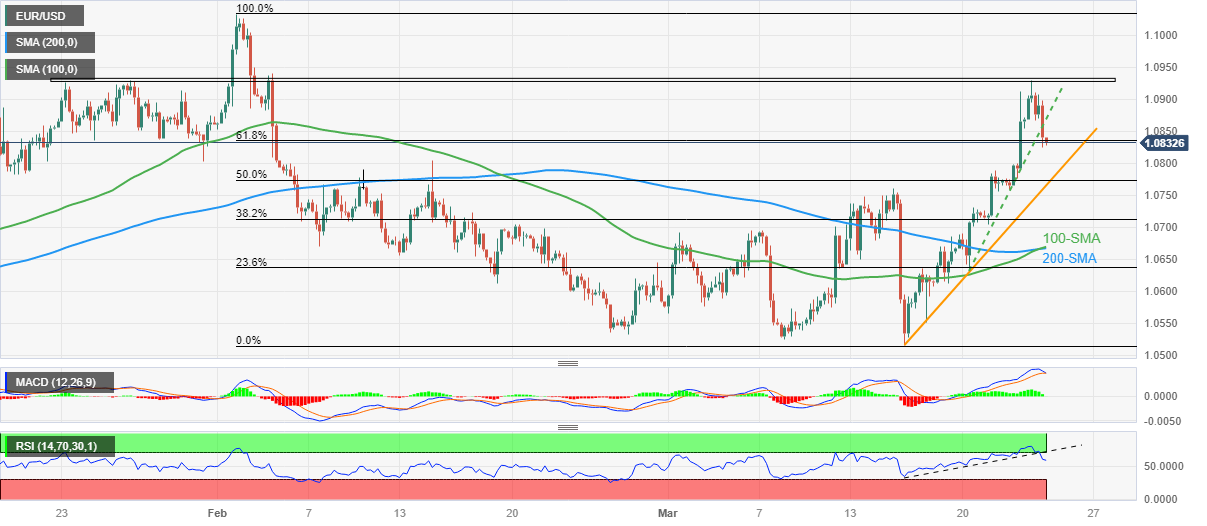
Trend: Further downside expected
- EUR/GBP has gauged an intermediate cushion around 0.8810 as BoE claims rapid inflation softening ahead.
- The BoE announced a 25 bps rate hike and pushed rates to 4.25% despite fears of banking turmoil.
- ECB Knot is in favor of further rate hikes in May as inflation is showing no signs of abating.
The EUR/GBP pair has found an intermediate cushion around 0.8810 in the early Tokyo session. Earlier, the cross witnessed a sell-off after the Bank of England (BoE) announced an eleventh consecutive rate hike to sharpen its tools in the battle against double-digit inflation. BoE Governor Andrew Bailey announced a rate hike by 25 basis points (bps) and pushed rates to 4.25%.
The asset is expected to deliver more weakness ahead as the street believes that the United Kingdom (UK) inflation is extremely stubborn and will take plenty of time to get contained. The BoE has come a long way by hiking rates to 4.25% and the annual inflation is still in the double-digit figure, showing no evidence of softening ahead.
On Wednesday, the UK Office for National Statistics reported a surprise jump in the headline Consumer Price Index (CPI) to 10.4% while the street was anticipating a decline to 9.8%. BoE stated that the surprise upside was mainly the impact of less often volatile clothing prices, which won’t last long.
The central bank is very much confident that inflation will start decelerating rapidly from the second quarter. However, the labor shortage and higher food prices might continue to keep inflation at elevated levels. For further guidance, investors will focus on the Retail Sales data, which is expected to contract by 4.7% on an annual basis.
On the Eurozone front, European Central Bank (ECB) policymaker Klaas Knot said that the ECB is unlikely to be done with rate hikes and added that they still think that they need to raise the policy rate in May. Investors should be aware that the ECB hiked rates by 50 bps last week. No doubt, more hikes must be in pipeline as ECB President Christine Lagarde has been reiterating that higher inflation would stay for a longer period.
- Market absorbs aftermath of Fed meeting, impacting USD/CAD.
- Investors foresee a halt in Fed rate hikes and rate reduction by 2023 end.
- US Treasury Secretary Yellen reassures bank deposit safety.
Since the Federal Reserve(Fed) meeting, the USD/CAD has experienced continuous choppy price action, with the US Dollar remaining indecisive as market forces have yet to determine a clearer direction for the greenback. On Thursday, US Initial Jobless Claims were released, coming in at 191K, compared to the previous 192K and an expected 197K. These figures remain close to 200K, suggesting firmer labor conditions.
Following the FOMC meeting and comments from US Treasury Secretary Janet Yellen, the market has leaned towards significant dovish repricing and anticipates a pause in the Federal Reserve's (Fed) rate hiking path. By the end of 2023, the market expects a 100 basis point (bps) rate cut from the Fed, due to gloomy banking concerns and a cautious approach from the central bank.
US Treasury Secretary Janet Yellen has taken charge of commentary amid the ongoing banking crisis, reassuring investors of a safe and sound US banking system. She has reiterated her preparedness to take further action if necessary to protect the US banking system.
Despite the backstop provided by the US Treasury Department and a dovish FOMC, US indices have failed to capitalize and remain in choppy conditions. Amid this jittery sentiment, oil prices struggle to find a clear direction, fluctuating between gains and losses. U.S. Energy Secretary Jennifer Granholm informed lawmakers that refilling the country's Strategic Petroleum Reserve (SPR) would be challenging this year and could take several years.
Geopolitical factors are also not improving risk sentiment, as US Defense Secretary Austin noted that the meeting between Chinese President Xi and Russian President Putin sent a troubling signal.
On the economic data front, Friday's US calendar will feature Durable Goods, S&P Purchasing Managers Index (PMI), and Canadian retail sales data for January, all set to be released.
Levels to watch
- US Dollar Index grinds higher after bouncing off seven-week low.
- Slump in banking stocks, mixed US data allow US Dollar to pare weekly loss.
- Comments from US Treasury Secretary Yellen, fears of more Fed rate hikes renew USD demand.
- A slew of economics to offer an interesting end to the volatile week.
US Dollar Index (DXY) holds onto the late Thursday’s rebound from a multi-day low to 102.65 during early Friday. In doing so, the greenback’s gauge versus the biggest weekly loss since early January amid fresh hopes of higher Federal Reserve (Fed) rates and more banking turmoil.
That said, a collapse in the banking shares and chatters that the Fed’s emergency lending to the banks has ballooned the balance sheet, renewing fears of more Fed rate hikes, which in turn allowed the DXY to pare recent losses. Also favoring the US Dollar Index buying could be the mixed US data.
“Federal Reserve emergency lending to banks, which hit record levels the last week, remained high in the latest week, amid continued large-scale extensions of credit to the financial system, which now includes official foreign borrowing.,” reported Reuters. The news also said that borrowing from the Fed caused the size of its overall balance sheet to move to $8.8 trillion from $8.7 trillion the prior week.
Elsewhere, the US Chicago Fed National Activity Index (CFNAI) dropped to -0.19 in February versus 0.0 expected and 0.23 prior. Further, Weekly Initial Jobless Claims declined to 191K for the week ended on March 18, versus 192K prior and 203K market forecasts. It should be noted that the US New Home Sales rose 1.1% in February from 1.8% prior, versus 1.6% analysts’ estimation.
It should be noted that the US Treasury Secretary’s testimony in front of the House Appropriations Financial Services Subcommittee probed the market’s previous risk-on mood and allowed the US Dollar Index (DXY) to pare losses at the seven-week low. “China and Russia may want to develop an alternative to the US dollar,” while also showing preparedness for additional deposit actions `if warranted'. “Strong actions have been taken to ensure deposits are safe,” said US Treasury Secretary Yellen.
Against this backdrop, Wall Street pared intraday gains and closed with a light green number whereas the Treasury bond yields also recovered but failed to post a positive closing.
Looking ahead, preliminary readings of the US S&P Global PMIs for March and the Durable Goods Orders for February will be crucial for the US Dollar Index traders to watch as firmer readings could join the aforementioned factors to extend the latest DXY recovery.
Technical analysis
Although the lower band of the Bollinger on the daily chart restricts US Dollar Index (DXY) downside near 102.30, the DXY bulls need validation from the 50-DMA hurdle of 103.45 to extend the rebound.
- EUR/JPY opens the Asian session with minuscule gains of 0.08%.
- An evening star in the EUR/JPY daily chart could drive prices lower.
- For a bullish resumption, EUR/JPY buyers must reclaim 142.00.
EUR/JPY fell for the second straight day, as the Euro (EUR) weakened despite European Central Bank (ECB) members' hawkish rhetoric. In the early Asian session, the EUR/JPY is trading at 141.83, above its opening price by 0.10%, after hitting a weekly high of 143.63 on Wednesday.
EUR/JPY Price action
The EUR/JPY daily chart portrays the formation of a three-candlestick chart pattern, an evening star, which implies that the pair might be headed lower. However, Japanese Yen (JPY) bulls must reclaim 141.61, so the EUR/JPY could test the 200-day Exponential Moving Average (EMA) at 141.05. A breach of the latter could open the door for further downside.
Conversely, if Euro (EUR) bulls move in and reclaim 142.00, that could pave the way for them to reclaim the 100-day EMA and the confluence of the 20/50-day EMAs. Once the EUR/JPY breaks above 142.00, the 100-day EMA at 142.33 would be challenged. Upside risks lie at the confluence of the 20/50-day EMA at 142.55/60, on its way toward 143.00.
Oscillators like the Relative Strength Index (RSI) are in bearish territory but shifted flat, and meaning sellers are taking a respite. The Rate of Change (RoC) shifted gears and turned bearish, signaling that sellers are in control.
EUR/JPY Daily chart
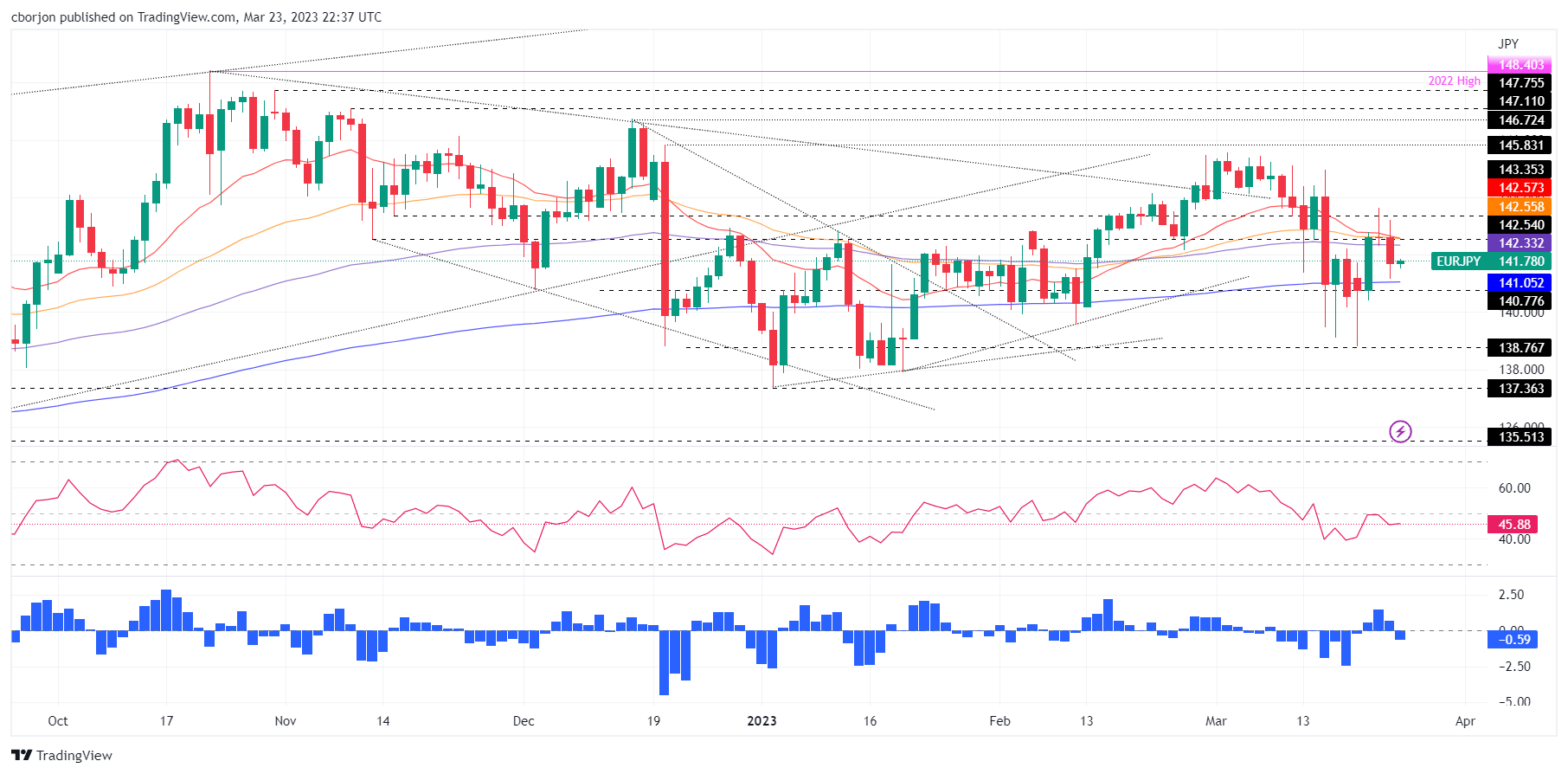
EUR/JPY Technical levels
- WTI licks its wounds after posting the first daily loss in four.
- U-turn from one-week-old resistance line breaks 200-HMA and joins downbeat oscillators to favor sellers.
- 100-HMA offers breathing space to bears before directing them to multi-month low.
- Bulls need successful break of $72.70 for confirmation.
WTI crude oil flirts with the 200-HMA as bears take a breather after returning to the table, following a three-day absence, during early Friday. In doing so, the black gold consolidates the previous day’s U-turn from a one-week high amid a sluggish Asian session.
That said, the quote reversed from an upward-sloping resistance line from March 16 the previous day to welcome bears. The downside move gained momentum after breaking the 200-Hour Moving Average (HMA). It should be noted that the bearish MACD signals and the downbeat RSI (14) line, not oversold, also back the energy benchmark’s latest weakness.
Hence, the quote’s corrective bounce remains elusive unless crossing the aforementioned resistance line, near $71.80 at the latest.
Even so, the mid-March swing high and 50% Fibonacci retracement of the commodity’s fall from March 07 to 20, around $72.70 by the press time, appears crucial for the WTI crude oil buyers to retake control.
Alternatively, the 100-HMA level of $68.65 puts a floor under the WTI crude oil price, a break of which could direct bears towards the seven-day-old horizontal support area surrounding $66.00-65.45.
In a case where the quote resists bouncing off the stated key support, the odds of witnessing a slump to refresh the multi-day low marked earlier in the week, around $64.40, can’t be ruled out.
WTI: Hourly chart
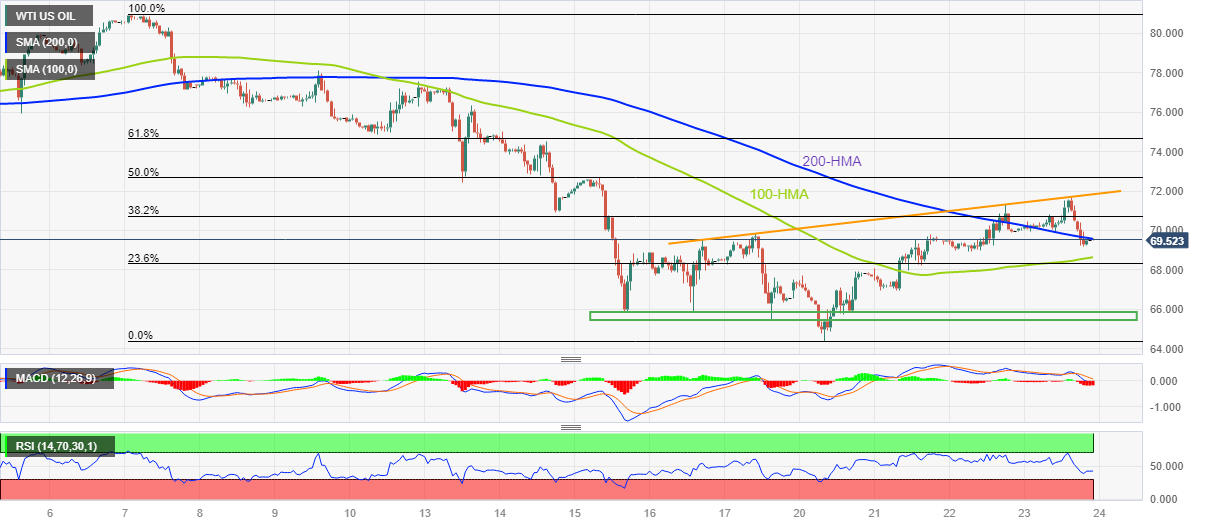
Trend: Further downside expected
- GBP/JPY has sensed buying interest near 160.00 as investors digest dovish guidance from BoE on interest rates.
- An absence of inflation softening in the UK despite pushing rates to 4.25% could create vulnerabilities ahead.
- Japan’s inflation is expected to cool off due to moderation in oil prices.
The GBP/JPY pair has sensed a buying interest after crashing to near 160.00 in the early Asian session. The cross has found a cushion as investors have digested the dovish commentary on interest rate guidance from the Bank of England (BoE).
Notable persistent inflation in the United Kingdom economy led by higher food prices, shortage of labor, and recent higher energy costs has been creating a mess for the BoE policymakers for a longer period.
In spite of a dismal economic outlook and global banking fiasco, BoE Governor Andrew Bailey went for an eleventh consecutive rate hike as inflationary pressures are getting beyond their control. Out of the seven-member team, Monetary Policy Committee (MPC) members Swati Dhingra and Silvana Tenreyro voted for an unchanged monetary policy while others favored a 25 basis point (bp) rate hike.
On the inflation guidance, BoE said that Consumer Price Index (CPI) figures would start scaling lower from the second quarter. They further added that Wednesday’s surprise jump in the price index was the outcome of volatile clothing prices, which could prove less persistent.
Analysts at Danske Bank consider that both growth and domestic inflation have surprised to the upside and given BoE’s message, they pencil in an additional 25 bps hike in May 2023.
On Friday, volatility from the Pound Sterling would continue as UK Office for National Statistics will report the Retail Sales (Feb) data. The economic data is expected to expand by 0.2% vs. 0.5% reported earlier. On an annual basis, a contraction is expected by 4.7%.
Meanwhile, the Japanese Yen will remain in action ahead of the release of the inflation data. Analysts at Standard Chartered expect “Headline CPI inflation to have expanded to 3.3% YoY, down from 4.3% in January. Similarly, core CPI inflation excluding fresh food may also have increased to 3.2%, less than 4.2% prior. However, core CPI excluding food and energy likely grew by 3.4% YoY in February, higher than 3.2% prior. The moderation in headline and core CPI inflation is mainly due to the base effect of oil prices, as per their view.
Late Thursday, Reuters reported that Federal Reserve emergency lending to banks, which hit record levels the last week, remained high in the latest week, amid continued large scale extensions of credit to the financial system, which now includes official foreign borrowing.
“Borrowing from the Fed caused the size of its overall balance sheet to move to $8.8 trillion from $8.7 trillion the prior week,”
Additional quotes
The Fed reported that discount window borrowing, its main source of emergency credit to depository institutions, ticked down to $110.2 billion as of Wednesday, from the $152.9 billion reported last week.
Last week's level had surged from $4.6 billion on March 8, shredding the $112 billion record set during the fall of 2008, during the global financial crisis’s most perilous phase.
The Fed also reported lending to foreign central banks and monetary authorities went from nothing on March 15 to $60 billion on Wednesday. Several major central banks announced recently they would draw on Fed dollar liquidity as needed.
Last week's increase set back the Fed’s work since last summer to reduce the size of its stockpile of cash and bonds that topped out at just shy of $9 trillion during the summer, a development the Fed views as having no implications for monetary policy.
Fed data also showed the $142.8 billion in credit it had extended to the Federal Deposit Insurance Corporation (FDIC) to deal with the failed California banks rose further and stood at $179.8 billion.
Market reaction
The news increase market’s fears of more Fed rate hikes and banking crisis, which in turn could be linked to the latest rebound in the US Treasury bond yields and the US Dollar from the recent troughs.
Also read: Forex Today: The Dollar says hello as Wall Street’s rally fades
- GBP/USD seesaws around seven-week high, pauses two-day uptrend.
- BoE matches market forecasts and announced 0.25% rate hike, showing readiness for more if inflation stays high.
- Fed’s dovish hike, banking crisis weigh on Treasury bond yields and US Dollar.
- Mixed US data allowed markets to consolidate recent moves ahead of a slew of data.
GBP/USD bulls take a breather around the highest levels in nearly two months, making rounds to 1.2290 after rising in the last two consecutive days, as the volatile week is left with one last ball to play. The Cable pair cheered the US Federal Reserve’s (Fed) dovish rate hike, as well as the Bank of England’s (BoE) readiness for more rate increases to renew the multi-day top of late. However, the mixed US data and sentiment seem to allow the quote to pare recent gains ahead of the key statistics.
On Thursday, the Bank of England (BoE) raised the policy rate by 25 basis points (bps) to 4.25%, as expected. The policy statement highlighted an increase in Q2 Gross Domestic Product (GDP) forecast while also estimating a slower growth in Consumer Price Index (CPI) for the same. "UK banking system is well-placed to support the economy, including in a period of higher interest rates," added the BoE statement. It should be noted, however, that the policymakers clearly showed readiness for more rate hikes if inflation stays high, which in turn allowed the GBP/USD to remain firmer.
On the other hand, the US Chicago Fed National Activity Index (CFNAI) dropped to -0.19 in February versus 0.0 expected and 0.23 prior. Further, Weekly Initial Jobless Claims declined to 191K for the week ended on March 18, versus 192K prior and 203K market forecasts. It should be noted that the US New Home Sales rose 1.1% in February from 1.8% prior, versus 1.6% analysts’ estimation.
It should be noted that the US Treasury Secretary’s testimony in front of the House Appropriations Financial Services Subcommittee probed the market’s previous risk-on mood and allowed the US Dollar Index (DXY) to pare losses at the seven-week low. “China and Russia may want to develop an alternative to the US dollar,” while also showing preparedness for additional deposit actions `if warranted'. “Strong actions have been taken to ensure deposits are safe,” said US Treasury Secretary Yellen.
Amid these plays, Wall Street pared intraday gains and closed with a light green number whereas the Treasury bond yields also recovered but failed to post a positive closing.
Moving on, UK Retail Sales for February and preliminary readings of the UK and US PMIs for March will be crucial for the GBP/USD pair traders.
Technical analysis
A 10-month-old resistance line, around 1.2345 by the press time, restricts immediate GBP/USD upside amid overbought RSI.
- Gold price is looking to shift its auction above $2,000.00 as the Fed doesn’t believe more rate hikes are appropriate.
- Further tightening of credit conditions by US banks would result in lower inflation, and cooling demand.
- Gold price is now marching towards the ultimate resistance plotted from August 2020 high at $2,075.32.
Gold price (XAU/USD) is oscillating in a narrow range of $1,990-2,000 in the early Asian session. The precious metal is struggling to shift its auction above the psychological resistance of $2,000. However, the upside looks favored as the Federal Reserve (Fed) has come closer to halting its policy-tightening cycle after eight consecutive hikes in the past year.
Fed chair Jerome Powell commented that some hikes might be appropriate to make the policy restrictive enough to tame the stubborn inflation. Also, it would not be worth hiking rates further in times when the United States economy is facing the fears of a potential banking crisis.
As the battle against stick inflation is still on, higher rates for a longer period will continue to weigh on persistent US inflation. Also, further tightening of credit conditions by commercial banks to avoid increment in Non-Performing Assets (NPAs) would result in lower inflation, cooling demand, and a dismal economic outlook.
Meanwhile, S&P500 futures showed some recovery on Thursday as investors are cheering that the economy is somehow clear about the terminal rate, which would help firms to design their strategy for further operations, portraying a risk-appetite theme. The US Dollar Index (DXY) defended the 102.00 support, however, the expression of fewer rate hikes ahead would maintain pressure on it.
On Friday, investors will keenly watch the US Durable Goods Orders data. As per the consensus, the economic data will expand by 0.6% against a contraction of 4.5%. Investors should be aware that the mighty Fed is not bound to stay on commentary and could continue its rate-hiking spell if forward demand continues to grow.
Gold technical analysis
Gold price has rebounded from the demand zone plotted in a range of $1,947-1,960 on a weekly scale. The precious metal is now marching towards the ultimate resistance plotted from August 2020 high at $2,075.32.
The 10-period Exponential Moving Average (EMA) will continue to act as a cushion for the Gold price.
Meanwhile, the Relative Strength Index (RSI) (14) has reclaimed the bullish range of 60.00-80.00. More upside looks solid as the momentum oscillator is not showing any sign of divergence and overbought situation.
Gold weekly chart
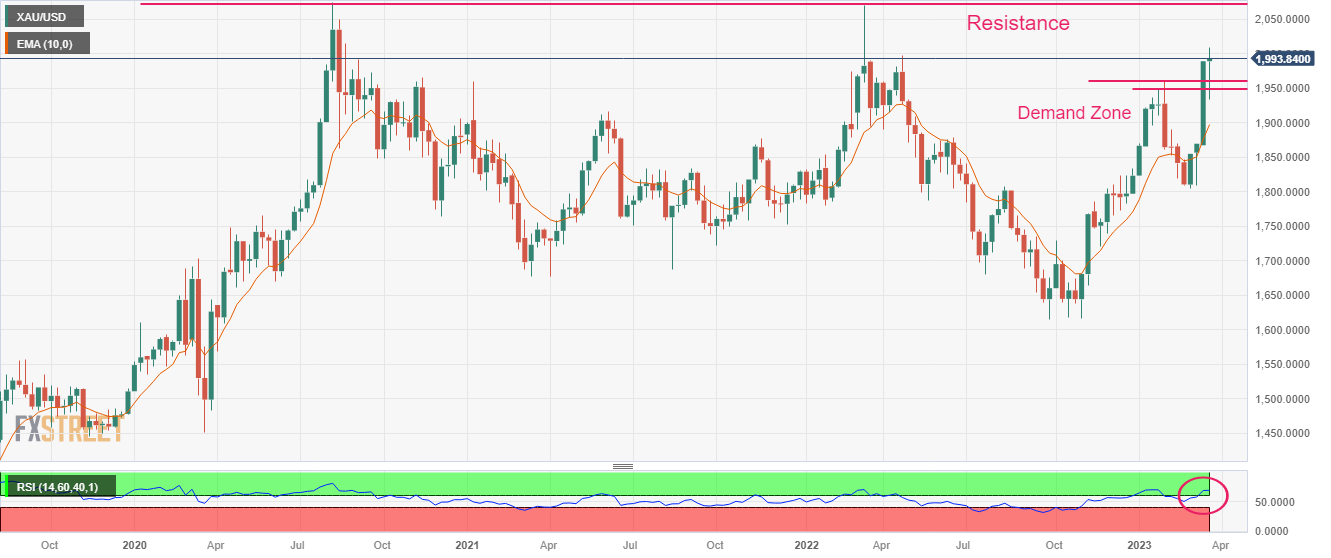
- USD/CHF bounced off the weekly lows around 0.9110s as the US Dollar pares its losses.
- USD/CHF Price Analysis: To shift neutral, above 0.9200; otherwise, the YTD lows would be tested.
The USD/CHF finished Thursday’s session with a loss of 0.11% after hitting a low of 0.9118 and closing at around 0.9163. As the Asian session begins, the USD/CHF is trading at around 0.9160s, as sellers continued to drive prices for the fourth straight day.
USD/CHF Price action
The USD/CHF daily chart portrays the pair as downward biased, but Thursday’s price action formed a hammer candlestick preceded by a downtrend; it’s usually a bullish candle. But buyers need to crack March’s 23 daily high at 0.9180 if they want to drive the USD/CHF higher.
For a bullish resumption, the USD/CHF first resistance would be 0.9200. Break above, and the 20-day Exponential Moving Average (EMA) at 0.9249 would be up for grabs. The 50-day EMA would be tested at 0.9278 before the USD/CHF reaches 0.9300.
On the flip side, and the path of least resistance, the USD/CHF first support would be March’s 23 low at 0.9118. A breach of the latter and the USD/CHF will fall to the March 13 daily low at 0.9070 before challenging the YTD low at 0.9059.
USD/CHF Daily chart
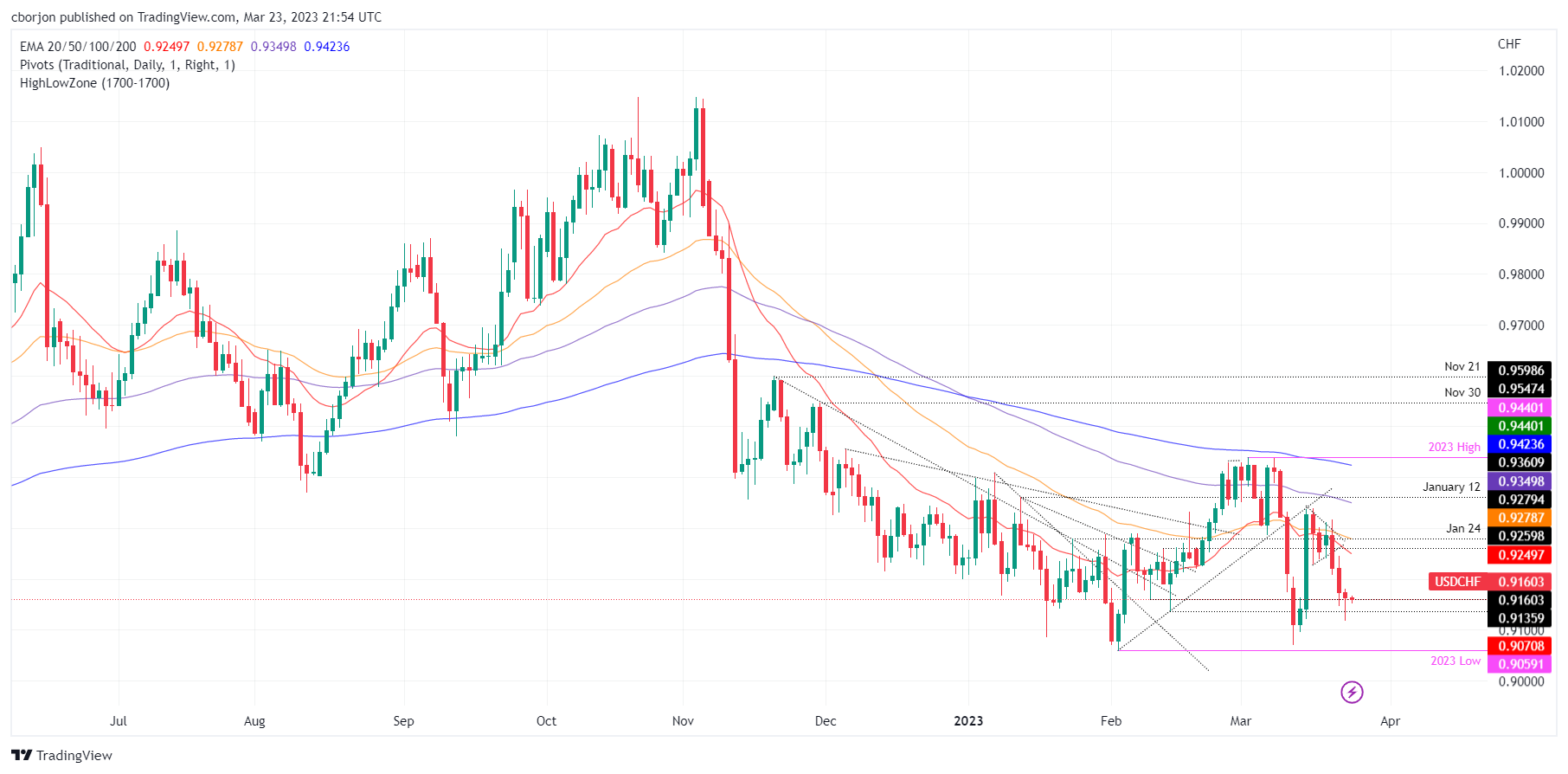
USD/CHF Technical levels
- AUD/USD consolidates a choppy number of past sessions.
- The focus is on the RBA as markets weigh the minutes and prospects for the next move.
AUD/USD is trading at around 0.6680 in early Asian Friday morning following a choppy number of sessions in financial markets. The pair traveled between a high of 0.6755 to a low of 0.6669 on Thursday but closed near its open and in the red as the US Dollar pared earlier losses on Thursday. The US Dollar index, DXY, which measures the currency against six major peers, was trading between 101.95 and 102.65 on the day.
Risk rallied as markets continued to digest the more dovish guidance from the Federal Open Market Committee, analysts at ANZ Bank said. ´´At the crux of future FOMC decisions will be the supply of credit in the economy. Current market interest rate pricing is skewed heavily towards expecting a persistent deterioration in the flow of credit,´´ the analysts explained.
´´For the foreseeable future, the Fed will proceed cautiously. We maintain our 5.50% forecast for fed funds, which implies two more 25bp hikes. The Fed’s 2023 core PCE forecast of 3.6% implies that sequential inflation will soon subside. The data have yet to confirm that,´´ the analysts said.
Meanwhile, domestically, the minutes from the March Reserve Bank of Australia meeting suggested that the Board is considering a pause in the rate hike cycle. Another 25bp hike at the April meeting is being priced in, so far although this assumes that financial market volatility recedes.
- EUR/USD stumbled and headed to the 1.0830s area after printing a weekly high at 1.0929.
- US jobs data suggests that the US Federal Reserve is not done raising rates.
- European Central Bank policymakers continue to emphasize that more hikes are coming.
EUR/USD hit a seven-week high but reversed its course, dropping below 1.0900 as the US Dollar (USD) pared some of its earlier losses. On Wednesday, the US Federal Reserve (Fed) raised rates by 25 bps, though market participants perceived it as dovish. That underpinned the EUR/USD, but traders booking profits weakened the Euro (EUR). The EUR/USD is trading at 1.0829, down 0.17%.
Yellen’s soft tone improved sentiment and lifted the US Dollar
Wall Street finished positively. The US Secretary of Treasure Janet Yellen testified before the house and backpedaled on Wednesday’s remarks that the US government is not planning to introduce blanket insurance to all depositors. Yellen said, “The strong actions we have taken ensure that Americans’ deposits are safe. Certainly, we would be prepared to take additional actions if warranted.”
Data-wise, the US Department of Labor revealed that the labor market remains tight, unveiling the Initial Jobless Claims for the last week. Claims rose by 191K, less than the 201K estimates by the market. The Chicago Fed National Activity Index for February plunged to -0.19 vs. the prior’s month 0.23.
Meanwhile, European Central Bank (ECB) officials crossed the wires and remained hawkish. ECB Muller said that the ECB should likely raise rates a little. Echoing some of his comments was Klas Know, adding that the ECB is unlikely to stop raising interest rates.
Sources linked to the ECB commented that policymakers are confident that the Eurozone (EU) banking system stood tall in the recent turbulence. Therefore that would allow the ECB to resume additional interest rate increases.
EUR/USD Daily chart

EUR/USD Technical levels
- NZD/USD was testing the 0.6270s in a soft US dollar environment.
- The RBNZ still have a job on its hands.
NZD/USD is higher into the close of the New York session by some 0.5% after rallying from 0.6211 to test the bear´s commitments near 0.6300 with the price making a high of 0.6294.
´´The Kiwi held strength attained following yesterday’s Fed decision and starts the day at the upper end of March’s trading ranges, at around 0.6275,´´ analysts at ANZ Bank explained, noting yesterday’s speech by Reserve Bank of New Zealand´s Chief Economist Paul Conway.
´´While he didn’t really say anything new, media reports made it look hawkish, and to be fair, the RBNZ still have a job on their hands. But of course, so do others even if the Fed is possibly wavering. Our forecasts see Kiwi mildly higher, but we remain worried about the imbalances that bears continue to cite,´´ the analysts said.
Meanwhile, the US Dollar pared earlier losses on Thursday after the US Federal Reserve sounded close to calling time on interest rate hikes. The dollar index, DXY, which measures the currency against six major peers, is trading between 101.95 and 102.65 on the day.
Here is what you need to know on Friday, March 24:
After the meetings of the Federal Reserve (Fed), the Swiss National Bank (SNB) and the Bank of England (BoE), the focus is back on economic data on Friday, with the preliminary reading of March PMIs across the globe. Traders will also pay attention to renewed banking concerns.
Equity prices in Wall Street finished with gains but far from session highs, pointing lower amid renewed banking concerns. The Dow Jones gained 75 points after being up by more than 400 points. Technology stocks outperformed while regional banks tumbled.
On Friday, markets will have the first numbers of global activity during March, the PMIs. Central banks around the globe adopted the “data-dependent” mantra, so economic figures should be relevant. Overall, activity is expected to have remained near February’s levels.
Data released on Thursday showed US New Home Sales rose 1.1% to 640,000 (annual rate) in February, slightly below expectations. The Chicago Fed National Activity Index fell from 0.23 to -0.19 in March, against forecasts of a 0 reading. Initial Jobless Claims dropped unexpectedly in the week ended March 18 to 191,000, the lowest in three weeks.
Late on the day, the deterioration in market sentiment boosted Treasury Bonds. The US 10-year yield settled at 3.39%, the lowest in three days. Despite the moves in the bond market, the US Dollar Index rebounded, ending with marginal gains above 102.50.
USD/JPY staged a short-lived recovery to 131.60 after US employment data and then fell to 130.32, a one-month low. The Japanese Yen was the main winner of the American session on the back of lower yields.
EUR/USD failed again to hold above 1.0900 and retreated sharply from monthly highs to below 1.0850. GBP/USD also pulled back, sliding under 1.2300. The Bank of England, as expected, raised its key interest rate by 25 basis points to 4.25%. The Monetary Policy Committee voted by a majority of 7-2 for the hike (Dhingra and Tenreyro voted to keep the rate at 4%). UK February Retail Sales are due on Friday.
AUD/USD battled again with the 0.6730/50 level, and retreated, falling under 0.6700 amid a stronger Greenback. The Australian PMI is due on Friday. NZD/USD was also affected by USD’s recovery and dropped from near 0.6300 to 0.6250. The Kiwi was among the top performers on Thursday. USD/CAD bounced from weekly lows at 1.3620 back above 1.3700. Canada will report January Retail Sales on Friday.
Gold rose again and traded above $2,000, while Silver rose past $23.00. Bitcoin recovered from Wednesday’s slide, rising to $28,500. Crude oil prices dropped more than 1% after spending most of the day in positive ground.
Like this article? Help us with some feedback by answering this survey:
- USD/JPY is trapped between 129.80 and 131.66.
- The bears remain in charge while the price is on the front-side of the trendline.
As per the prior analysis, USD/JPY Price Analysis: Bulls about to make their move with eyes on 61.8% retracement, The bulls made their move but were met with strong supply.
USD/JPY prior analysis
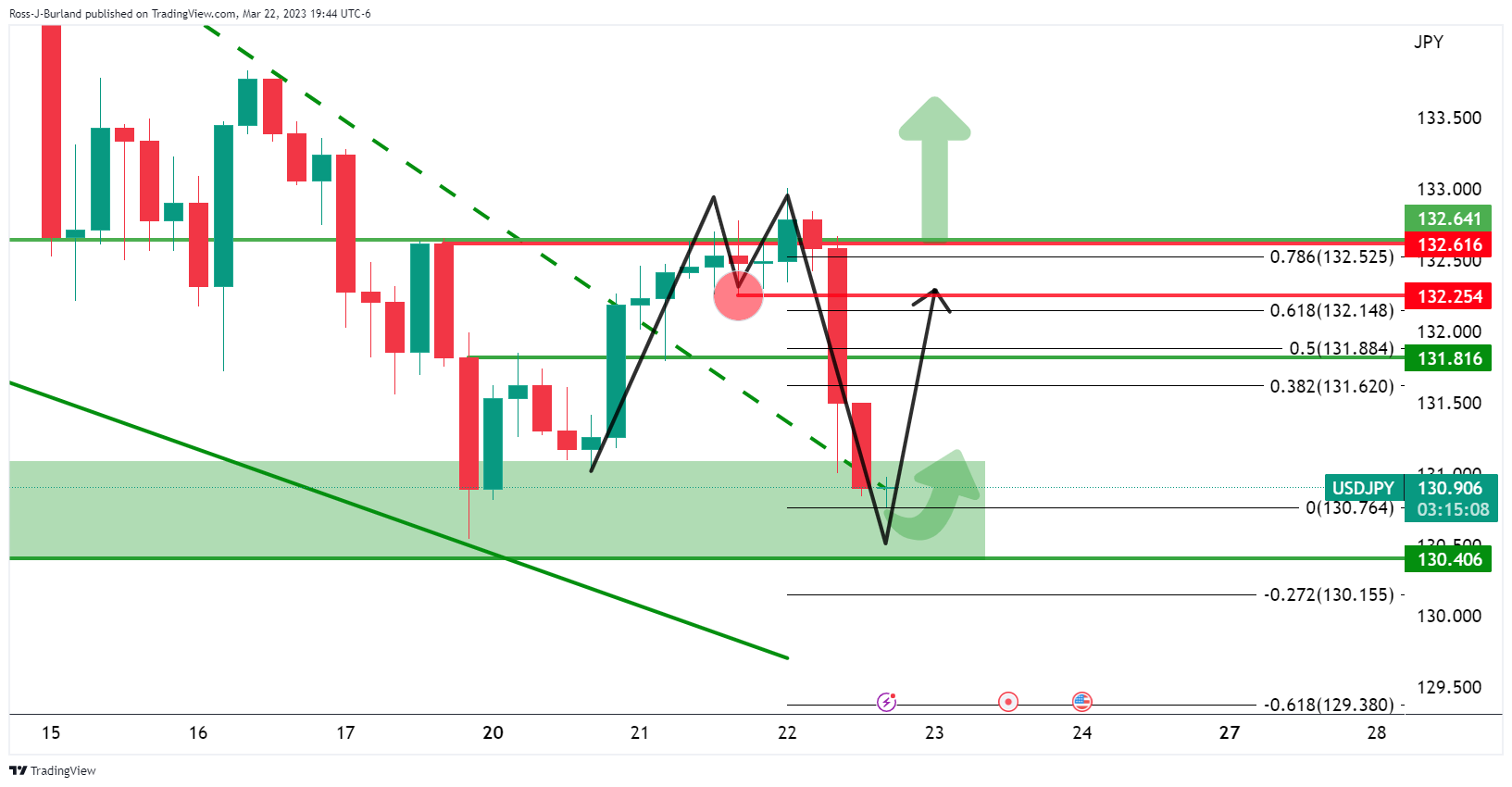
It was explained that the price was moving into the lower support and that the bulls could be committed near the 130.70s for a retest of the prior support.
USD/JPY update
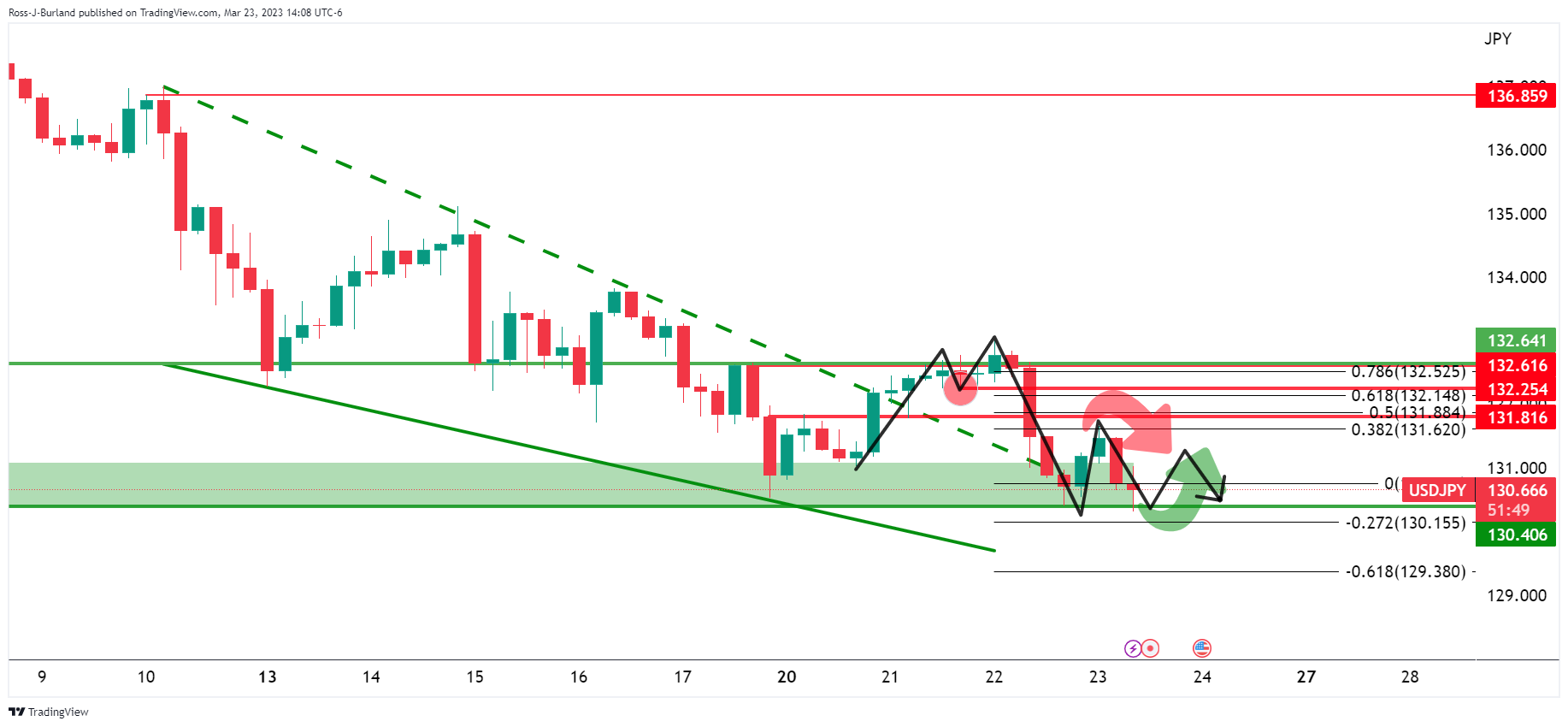
USD/JPY bulls met a 38.2% Fibonacci retracement before the supply came on. at this juncture, there is little bias one way or the other.
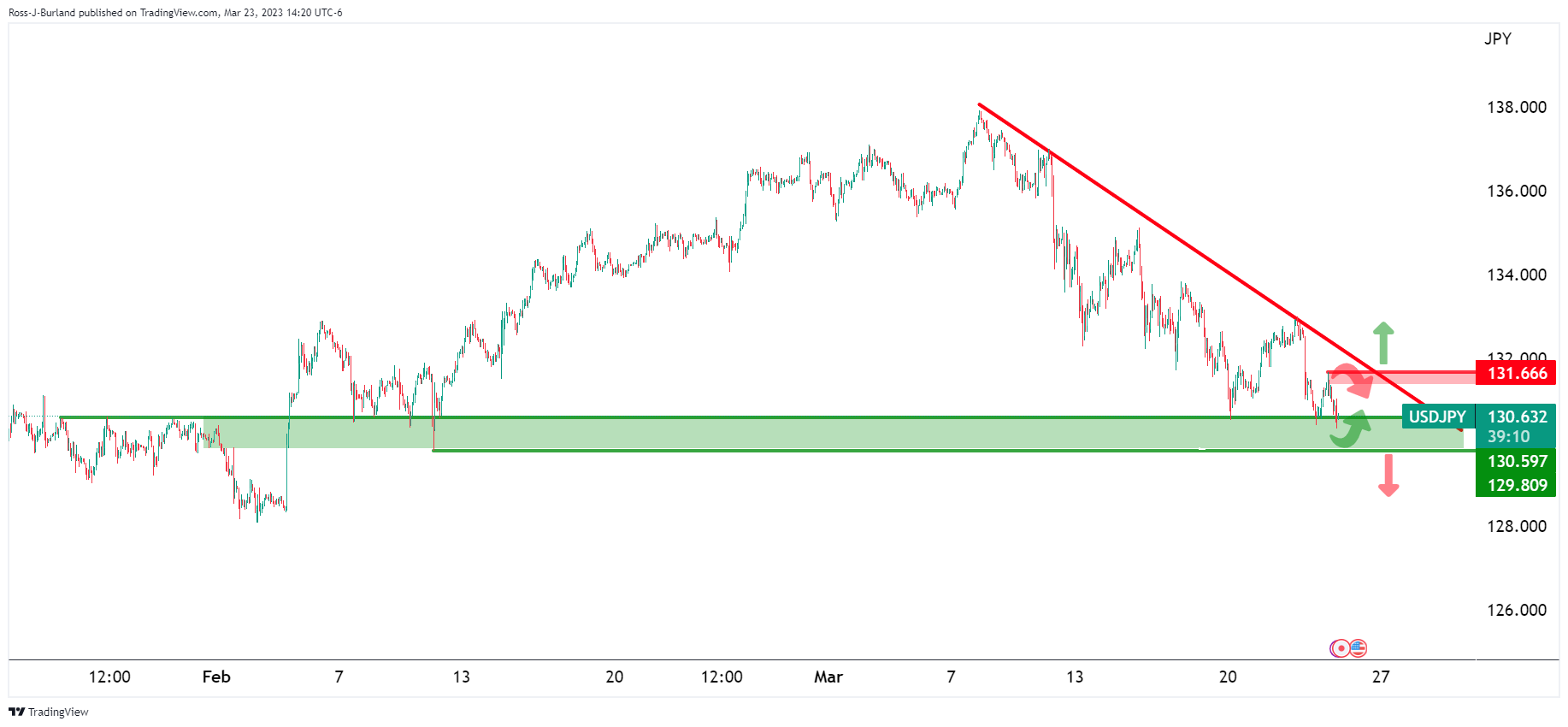
In the hourly chart above, 129.80 and 131.66 are the extremities of the current range and there is a neutral/bearish bias while between there.
Treasury Secretary Janet Yellen, Council of Economic Advisers Chair Cecila Rouse, and Office of Management and Budget Director Shalanda Young are delivering their testimony before the House Appropriations Financial Services Subcommittee.
Treasury futures are climbing higher across the board in late trade as a result.
Watch live
The prepared text came out earlier than expected: Yellen was expected to say, "we have used important tools to act quickly to prevent contagion. And they are tools we could use again," she said in prepared testimony to Congress.
"The strong actions we have taken ensure that Americans' deposits are safe. Certainly, we would be prepared to take additional actions if warranted."
Key notes
Prepared for additional deposit actions `if warranted'.
Strong actions have been taken to ensure deposits are safe.
Important anti-contagion tools could be used again.
Seeing reduced pressure on supply chains, lower shipping costs - us house appropriations subcommittee hearing.
Easing supply pressures will eventually pass through to lower inflation.
Front-month 30Y futures tap 132-01, 30Y yield 3.6690% low, while yield curves continue to climb off deeper inverted levels.
Implied rate cuts by year end accelerate with Dec'23 cumulative -86.6 at 3.946%, Fed Terminal slips to 4.89% in May.
Meanwhile, Wednesday's testimony from Treasury Secretary Yellen weighed on stocks after stating the Tsy is "not considering broad increase in deposit insurance", at odds with Chairman Powell's comment supportive of regional banks.
- Wall Street remains mixed across the board despite the US Dollar weakening.
- US Treasury bond yields collapsed after the Fed raised rates by 25 bps.
- Investors focus shifted toward the Federal Reserve’s monetary policy decision.
Wall Street is mixed during Thursday’s session as traders brace for a possible pause in the Federal Reserve (Fed) tightening cycle. Money market futures expect three rate cuts by the Fed at the end of 2023 following Wednesday’s 25 bps hike. The S&P 500 losses 0.18%, at 3,932.41, while the Dow Jones followed suit, down 0.20%, at 31,966.32. The Nasdaq Composite is the outlier, boosted by mega-cap companies, up 0.36%, at 11,711.29.
Sentiment improved after US Treasury Secretary Janet Yellen rattled financial markets, expressing that the United States (US) government is not planning to introduce blanket insurance to all depositors on Wednesday. At the same time, the US Federal Reserve Chair Jerome Powell emphasized that the banking system is solid after the Fed took steps to provide liquidity to the markets.
Additionally, traders shrugged off a 25 bps rate hike by the Fed, even though Jerome Powell expressed that inflation is too high and the labor market remains tight. Regarding the latter, US Initial Jobless Claims for the last week rose less than estimates, reaching 191K, below forecasts of 201K. Therefore, further tightening is expected by the US central bank.
The Chicago Fed National Activity Index for February plunged to -0.19 vs. the prior’s month 0.23
US Treasury bond yields continue to fall, weighed by investors expecting an additional rate hike by the Fed and then a pause. The 2-year bond yield dropped to 3.833%, down nine bps, while the 10-year bond yield fell one bps to 3.428%.
Sector-wise, Communication Services, Technology, and Real Estate led the pack, each up 1.66 %, 1.38%, and 0.01%. Contrarily, Energy, Utilities, and Financials, finished with losses of 1.47%, 0.87%, and 0.51%m respectively.
In the FX space, the US Dollar Index (DXY), which tracks the buck’s value against a basket of six currencies, lost 0.01%, down at 102.528, after hitting a weekly low of 101.910.
S&P 500 Daily chart

- West Texas Intermediate crude is sinking on Thursday.
- Investors fear a recession in the aftermath of the Fed.
West Texas Intermediate crude oil is lower on Thursday despite risk-on markets that continued to digest the more dovish guidance from the Federal Open Market Committee. However, the prediction from the central bank of more to come renewed recession concerns and has weighed on the oil price. West Texas Intermediate is currently down by some 1% after falling from a high of $71.63 and printing a low of $69.24 so far.
The drop came after the Federal Reserve on Wednesday raised interest rates as expected by 25 basis points and said more hikes are likely on the way. However, a clouded outlook due to the risks associated with the banking sector troubles is weighing on the oil price also. Additionally, US Treasury Secretary Janet Yellin warned that the United States government will not automatically insure all deposits in future bank rescues.
Meanwhile, the rise in US oil inventories was seen in the report from the Energy Information Administration. There was a rise of 1.1-million barrels in stock the prior week vs. the estimate of a 1.8-million barrel drop.
Analysts at TD Securities argued that the spring is coiled in energy markets. ´´While CTA short acquisitions helped to fuel downside before a technical break catalyzed a large-scale stop-out, buying activity is unlikely to gain steam until WTI crude prices break the $78.50/bbl range,´´ the analysts argued.
´´With every single trend indicator on our screen already pointing to the downside, selling activity has run out of steam and algos stand ready to lift some offers. Strong crack spreads associated with refinery outages dampening supply and resilient demand could potentially act as a catalyst.´´
- GBP/USD bulls are tiring following the recent run to fresh bull cycle highs.
- US Dollar, DXY, is consolidating the slide in a support area.
As per the prior analysis, GBP/USD Price Analysis: Bulls are in the market and eye a bullish extension, the currency pair has indeed rallied as being supported on the front side of the bullish trend.
Since the prior analysis, both the Federal Reserve and the Bank of England have made their interest rate decisions, the former forcing some observers to reconsider their US Dollar forecasts as the currency slides to the lowest levels last seen at the end of January in the DXY index:
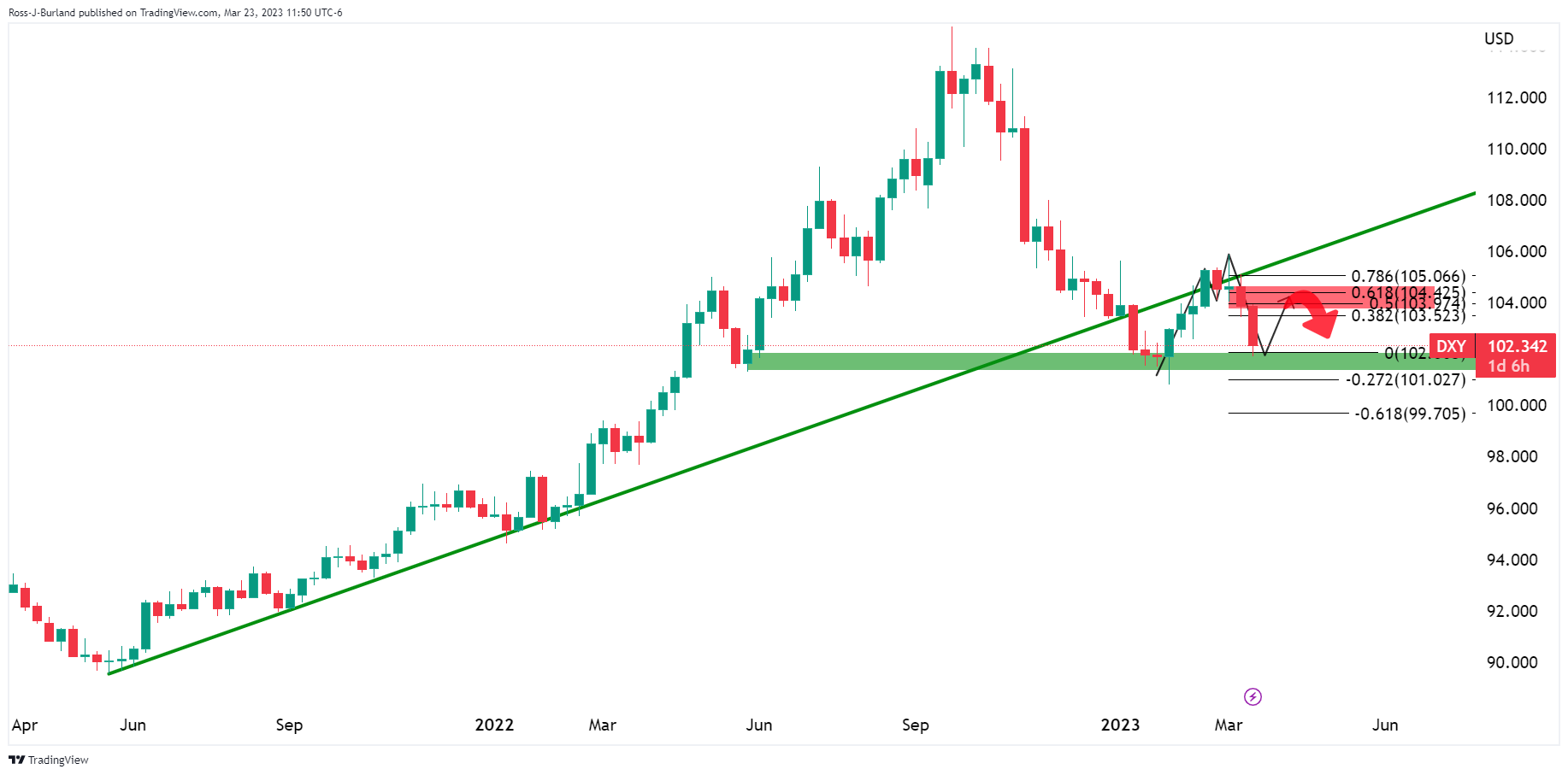
The weekly chart for DXY shows the price plummeting this week so far into a support area and the M-formation is a reversion pattern that could draw the index back towards the neckline in the foreseeable future.
Nevertheless, the bears are in the market still but there is some deceleration of the slide taking place currently as per the following 4-hour chart:
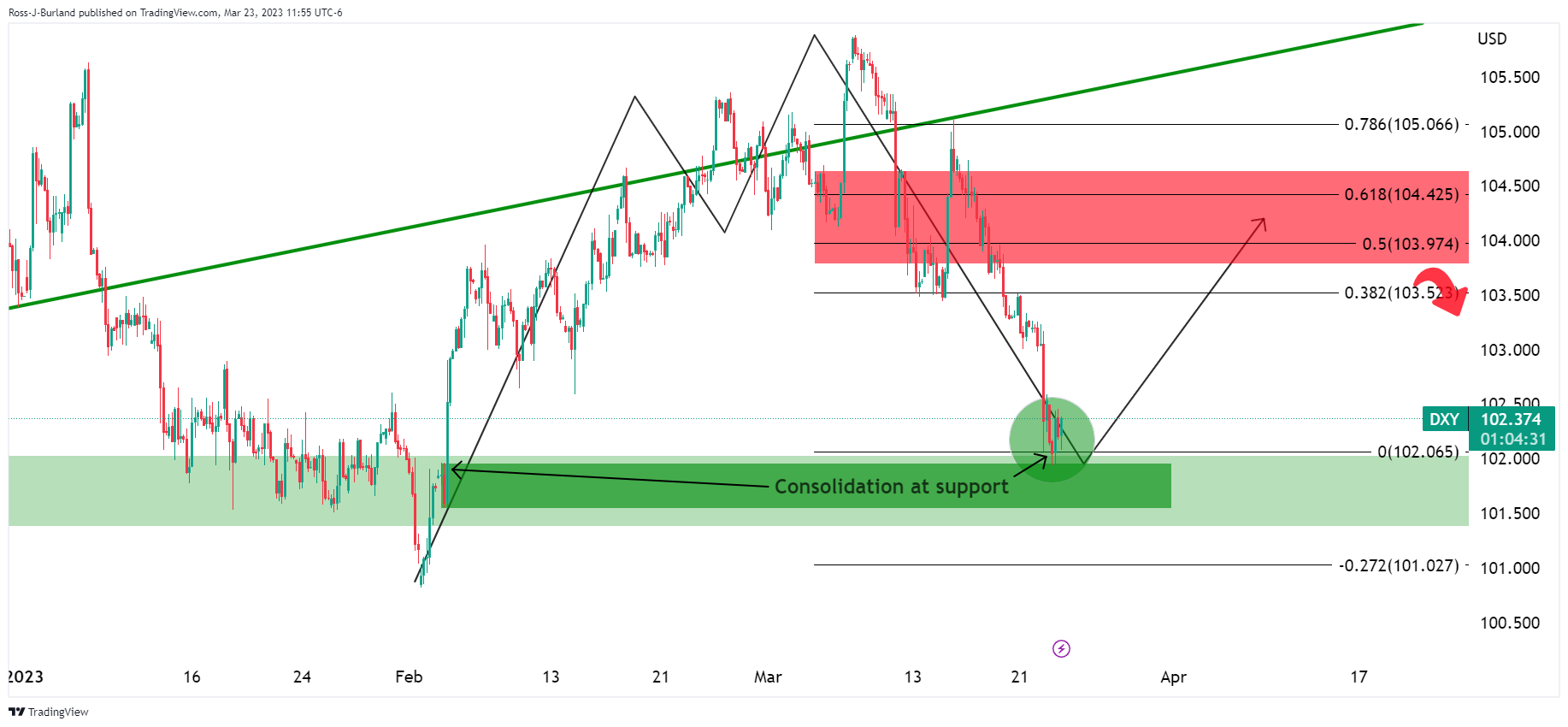
GBP/USD technical analysis
Meanwhile, GBP/USD is also consolidating fresh corrective highs.
GBP/USD prior analysis
it was explained that there were inverse head and shoulders on both the daily and 4-hour charts
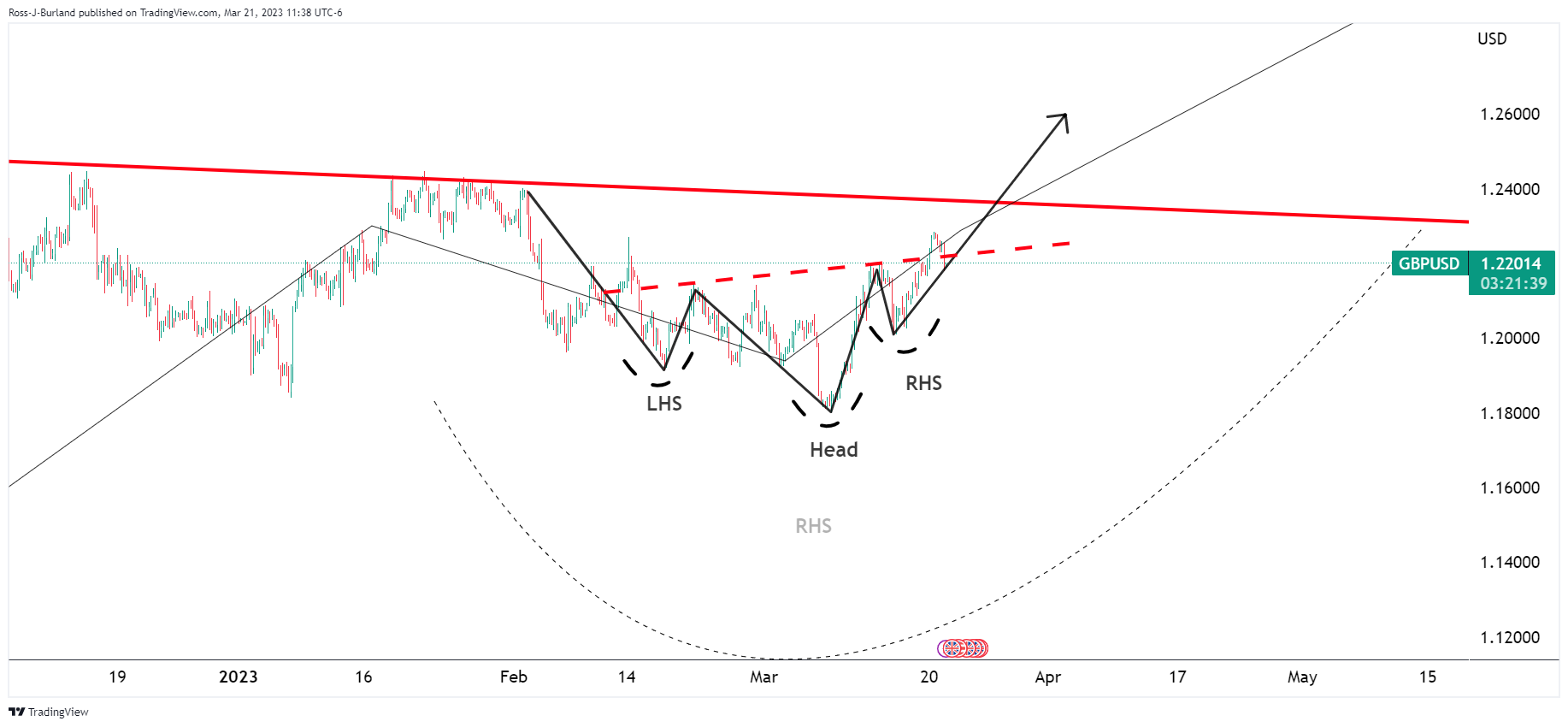
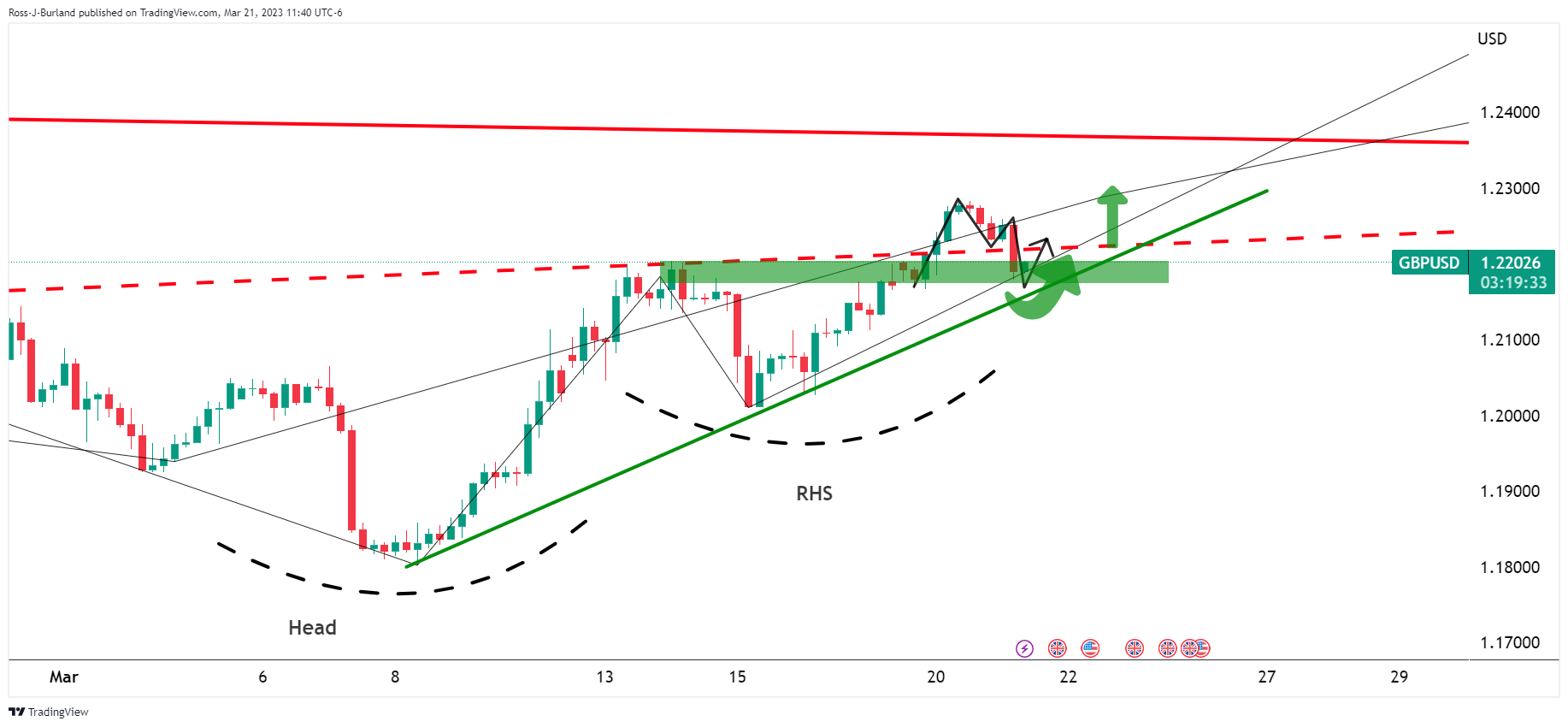
Given the 4-hour neckline was already broken, and owing to the M-formation being a reversion pattern, the bias was bullish with the price on the front side of the trend.
GBP/USD update

GBP/USD rallied as per the bullish bias and is moving in on the longer-term chart´s head shoulders neckline:
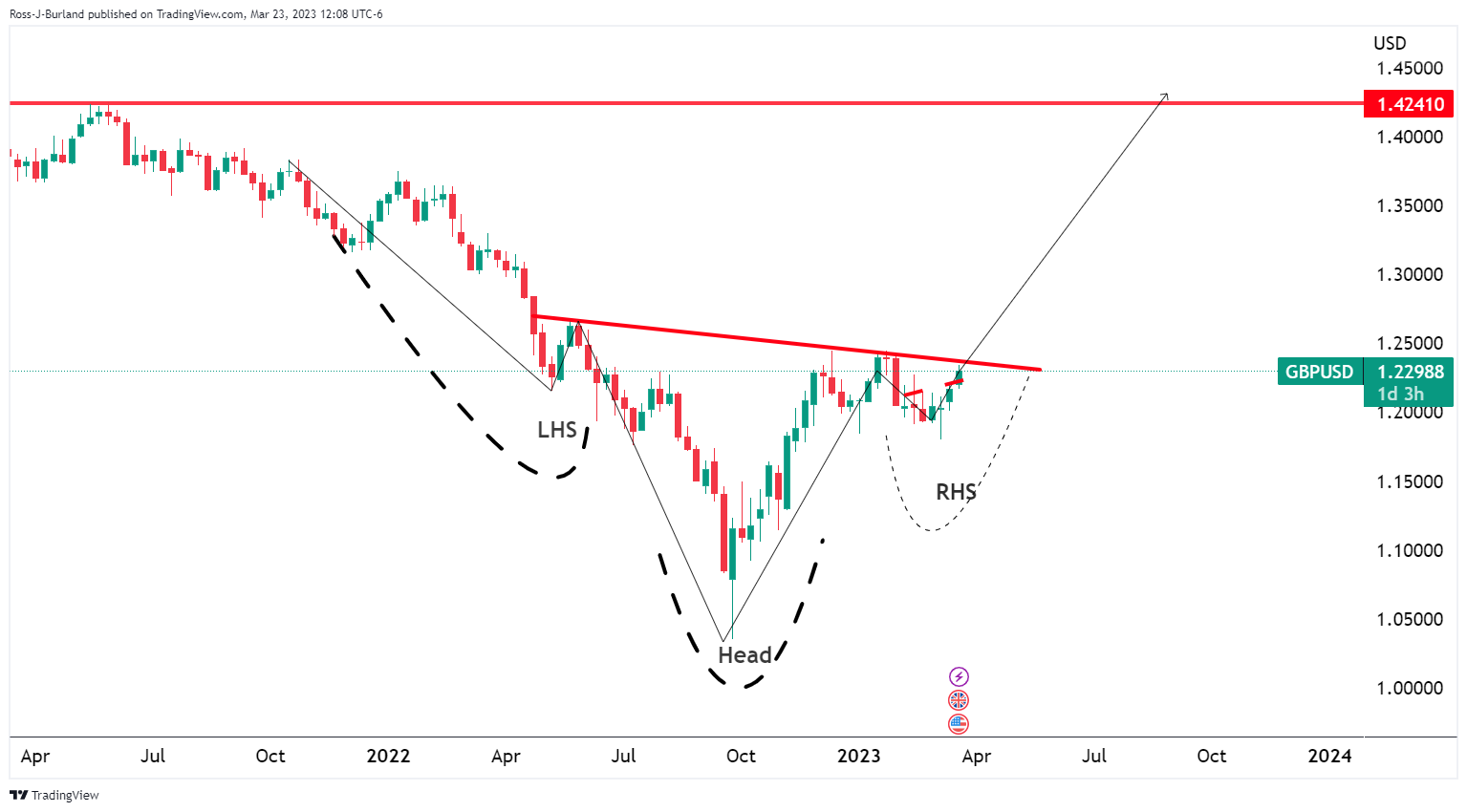
- Silver price remains underpinned by a soft US Dollar and depressed US bond yields.
- XAG/USD Price Analysis: A daily close above $23.00 could exacerbate a rally toward YTD highs.
Silver price advances sharply to fresh six-week highs in the North American session, courtesy of a weak US Dollar (USD), which remains downward pressured by falling US Treasury bond yields. Hence, the XAG/USD is trading at $23.12 after hitting a daily low of $22.76.
XAG/USD Price action
During the Federal Reserve’s (Fed) monetary policy decision, the XAG/USD traded sideways around the $22.20s area before the US Treasury bond yields tumbled. After that, Silver rallied and tested the $23.00 figure before pulling back and closing at $22.97. However, Thursday’s price action resumed upwards, with buyers piling around the $22.70 area, and lifted XAG/USD price above the $23.00 mark.
Although the XAG/USD bias is neutral, the 20-day Exponential Moving Average (EMA) at $21.87 exceeded the 200-day EMA at $21.83. That could exacerbate another leg-up in Silver prices, and the white metal could test the YTD high at $24.63.
The XAG/USD first resistance would be the February 3 daily high at $23.59. Once cleared, the XAG/USD will be headed toward the $24.00 mark. Once broken, Silver will be poised to test the YTD high at $24.63.
In an alternate scenario, the XAG/USD first support would be $23.00. A daily close below the latter will keep XAG/USD price downward pressured.
XAG/USD Daily chart
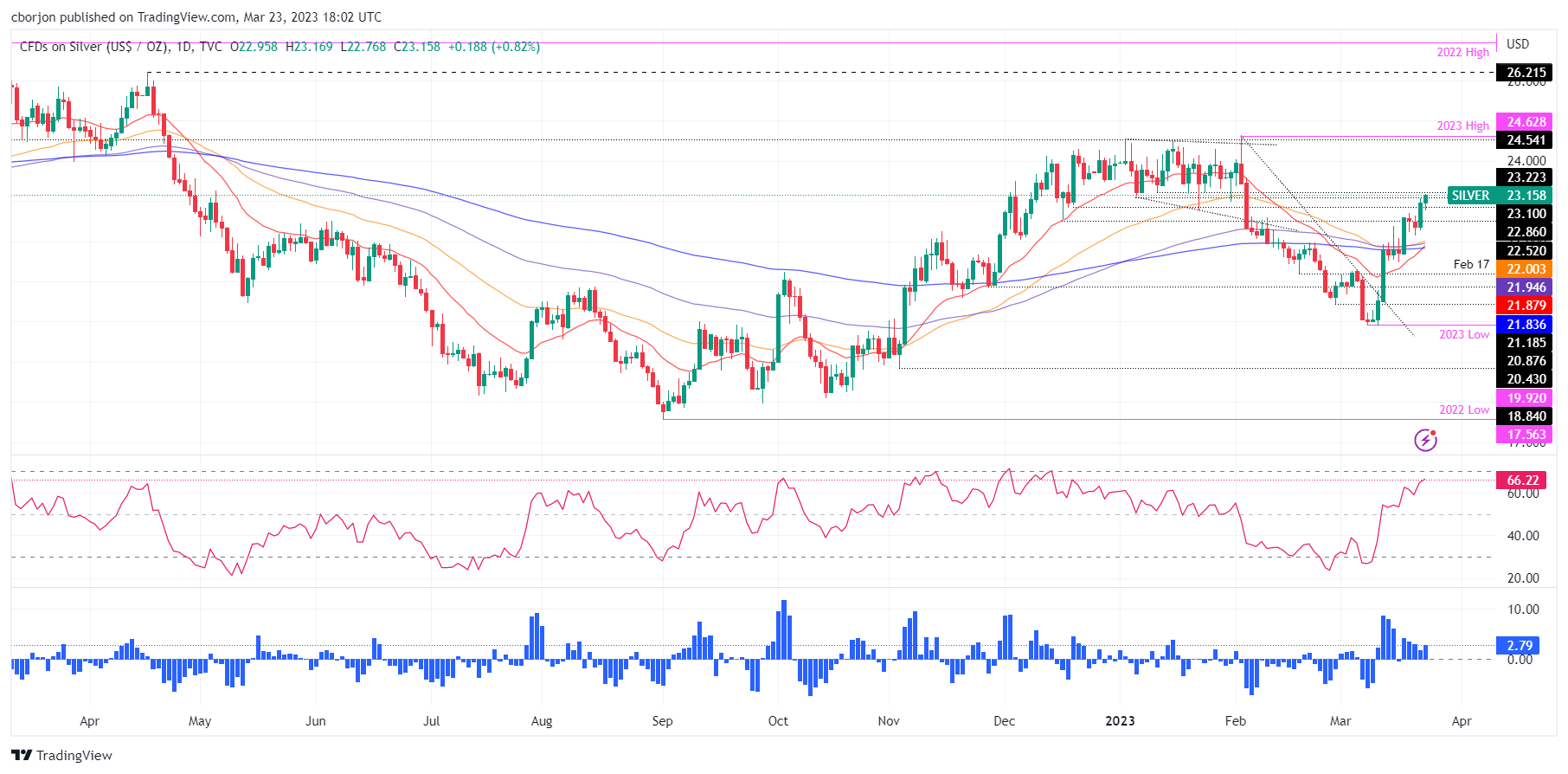
XAG/USD Technical levels
On Thursday, the Bank of England (BoE) announced a 25 basis point rate hike to 4.25% as expected. Analysts at Danske Bank consider that with both growth and domestic inflation having surprised to the upside and given BoE’s message, they pencil in an additional 25 bps hike in May 2023.
BoE rate to peak at 4.50%
“As the 25bp hike was fully priced in by markets, the market reaction upon announcement was limited. 10-30Y was close to unchanged while 2Y rates were a few basis points lower. The market pricing of the peak policy rate was pushed slightly lower to 4.5% in August (from 4.6%).”
“We revise our call to expect the BoE to deliver a final 25bp hike in May. Our expectations are in line with current market pricing (currently 30bp priced until August 2023) as we expect the rest of the BoE committee to increasingly turn less hawkish amid a weakening growth backdrop and easing labour market conditions. Markets are pricing in 30bp of cuts during H2. We still believe that the first rate cuts will not be delivered before the beginning of 2024.”
- USD/CAD creeps lower below the 1.3700 figure on sentiment improvement and falling UST bond yields.
- US jobs data continues to justify further tightening by the Federal Reserve.
- USD/CAD Price Analysis: Once it falls below 1.3600, the 100-DMA is eyed.
USD/CAD sellers moved in on Thursday after being kept at the sidelines on a risk-on impulse. Although the US Federal Reserve (Fed) raised rates as expected, market participants perceived Powell and Co.’s move as dovish. That said, the USD/CAD has fallen 0.56% or 76 pips, exchanging hands at 1.3654.
Unemployment claims in the US remain depressed as the Fed battles inflation
Wall Street remains bolstered by an upbeat mood. Investors had digested words from Janet Yellen, the US Treasury Secretary, who said that the United States (US) government is not planning to introduce blanket insurance to all depositors. However, a dovish rate hike by the Fed improved risk appetite.
Data-wise, the US economic docket featured Initial Jobless Claims for the week ending on March 18, which fell by 1,000, to 191,000 below estimates of 201,000. That reinforced the Fed’s view of a tight labor market and warranted further action by the US central bank. At the same time, the Chicago Fed National Activity Index for February plunged to -0.19 vs. the prior’s month 0.23
In the meantime, the US Dollar Index, a gauge of the buck’s value against a basket of six currencies, continues to stumble and is down 0.31% at 102.213, undermined by falling US Treasury bond yields.
Therefore, the Canadian Dollar (CAD) is being boosted by a softer US Dollar and high oil price, with Western Texas Intermediate (WTI) rising above the $70.00 a barrel threshold, for the first time since March 15. Therefore, the USD/CAD is set to continue to fall as the US Dollar continues to weaken.
USD/CAD Technical levels
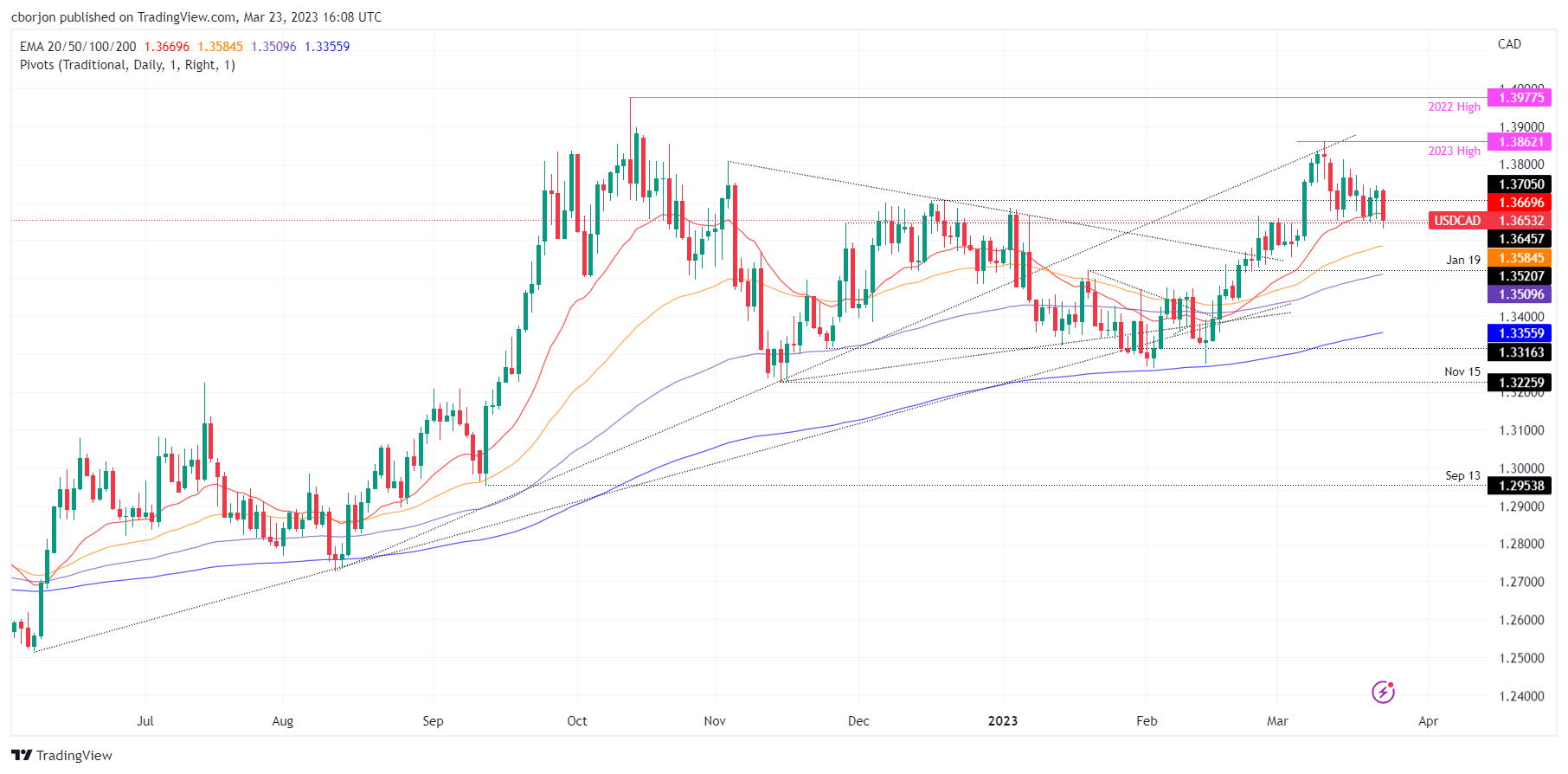
After sliding below the 1.3700 figure, the USD/CAD is extending its losses past the 20-day Exponential Moving Average (EMA) at 1.3668. Additionally, the pair is trading at two-week new lows, with sellers eyeing a test of the March 3 low at 1.3550. But firstly, the USD/CAD needs to conquer the 1.3600 figure. A breach of the latter will expose the 50-day EMA at 1.3584 before testing 1.3550, ahead of dropping to the 100-day EMA at 1.3509.
Dollar’s dominance is losing momentum with recent geopolitical events. De-dollarisation is a secular process and is likely to benefit Gold, economists at Société Générale report.
Central banks diversifying into Gold
“Ahead of the next US general elections, the risks are growing that the US will stay tough, and with a war backdrop, this should mean a continuation of geopolitical tensions.”
“The longer the Russia-Ukraine conflict endures, the faster countries not aligned with the west will be willing to isolate themselves from the USD. This will encourage central banks to continue their strong Gold purchases.”
“The central banks of non-aligned countries should continue to de-dollarise their portfolios and keep buying Gold (6% of our allocation, unchanged) which, at a later stage, will be backed by lower real yields.”
The FOMC unanimously decided to raise the target range for the federal funds rate by 25 bps to 4.75-5.00% from 4.50-4.75%. Economists at Rabobank remove the June rate hike of 25 bps from their forecasts. However, they still believe that the Fed will keep rates unchanged for the remainder of the year.
Fed to raise the FFR one more time and keep it there for the remainder of the year
“The FOMC unanimously decided to raise the target range for the federal funds rate by 25 bps. However, the FOMC does not want to go much higher and expects only one more 25 bps rate hike this year. Instead, the FOMC expects credit tightening by banks to do the rest of the inflation fighting for the central bank. During the Q&A you could easily get the idea that credit tightening is the Fed’s new monetary policy tool.”
“We lower our forecast for the target range of the fed funds rate to 5.00-5.25% from 5.25-5.50%. In other words, we now expect only one more hike of 25 bps instead of two. However, we stick to our forecast that the FOMC will not pivot this year.”
Japan is set to release February Consumer Price Index data on Thursday, March 23 at 23:30 GMT and as we get closer to the release time, here are the forecasts by the economists and researchers of four major banks regarding the upcoming Japanese inflation data.
Headline is expected at 3.3% year-on-year vs. 4.3% in January, core (ex-fresh food) is expected at 3.1% YoY vs. 4.2% in January, and core ex-energy is expected at 3.4% YoY vs. 3.2% in January.
Standard Chartered
“We expect headline CPI inflation to have expanded to 3.3% YoY, down from 4.3% in January. Similarly, core CPI inflation excluding fresh food may also have increased to 3.2%, less than 4.2% prior. However, core CPI excluding food and energy likely grew by 3.4% YoY in February, higher than 3.2% prior. The moderation in headline and core CPI inflation is mainly due to the base effect of oil prices, in our view. Tokyo CPI inflation, which is a leading indicator of national CPI inflation, increased to 3.4%, down from 4.4% in January. Tokyo core CPI inflation also dropped to 3.3% from 4.4% prior. However, core Tokyo CPI inflation rose to 3.2% from 3.0% prior, indicating that CPI inflation is sticky and headline CPI may take time to fall below the Bank of Japan's 2% target level.”
ING
“Consumer inflation in Japan is expected to cool to 3.5% YoY in February (vs 4.3% in January) due to the government’s energy subsidy programme, helped along by the base effects of a slowdown.”
SocGen
“We forecast nationwide core CPI of 3.2% YoY in February, significantly down from the 4.2% YoY seen in January. However, there is considerable uncertainty about the future.”
CitiBank
“Citi Forecast: 3.1% YoY, Previous: 4.3% YoY; Excluding Fresh Food: Citi Forecast: 3.0% YoY, Previous: 4.2% YoY; Excluding Fresh Food and Energy: Citi Forecast: 3.4% YoY, Previous: 3.2% YoY. We expect nationwide core CPI measures to rise from the previous month but fall sub 2% YoY from early autumn as the impact of past rises of commodity prices and Yen depreciation diminishes.”
- Consumer Confidence Indicator came in weaker than expected in March's flash estimate.
- EUR/USD continues to trade in positive territory slightly below 1.0900.
Consumer sentiment in the Eurozone weakened modestly with the Consumer Confidence Indicator edging lower to -19.2 in March's flash estimate from -19.1 in February. This reading came in weaker than the market expectation of -18.3. For the EU, the Consumer Confidence Indicator stood unchanged at -20.7.
Market reaction
This data doesn't seem to be having a noticeable impact on the Euro's performance against its major rivals. As of writing, the EUR/USD pair was trading at 1.0890, rising 0.33% on a daily basis.
- US Initial Jobless Claims continued their downward trend, portraying a tight labor market.
- Retail Sales in Mexico exceeded estimates and bolstered the Mexican Peso.
- USD/MXN Price Analysis: Could resume its bearish bias below $18.50.
The Mexican Peso (MXN) recovers against the US Dollar (USD) as the USD/MXN registers losses of 0.57% and stumbles below the 20-day EMA. Following the US Federal Reserve’s (Fed) decision to tighten monetary conditions, a risk-on impulse keeps the emerging country currency underpinned at around $18.50. At the time of writing, the USD/MXN is trading at 18.4868.
US bond yield fall as investors expect a less hawkish Fed
Wall Street is trading with solid gains after the US Treasury Secretary Janet Yellen rattled investors after saying that the United States (US) government is not planning to introduce blanket insurance to all depositors. Contrarily, Fed Chair Jerome Powell said that the banking system is solid after the Fed took steps to provide liquidity to the markets.
Unemployment claims for the week ending on March 18 fell by 1,000, warranting further tightening by the Fed amidst a tight labor market. The US Department of Labor (DoL) revealed that 191,000 Americans filled for aid after being laid off, contrary to the expected jump of 201,000 as reported by the consensus. At the same time, the Chicago Fed National Activity Index for February plunged to -0.19 vs. the prior’s month 0.23
Consequently, US Treasury bond yields continue to fall, weighed by investors expecting an additional rate hike by the Fed and then a pause. The 2-year bond yield dropped to 3.90%, down one bps, while the 10-year bond yield climbed to 3.464%. That undermined the greenback, with the US Dollar Index (DXY) falling 0.33% at 102.187.
On the Mexican front, Retail Sales in January jumped 1.6% from December, as the national statistics agency (INEGI) reported. Annually based, sales rose 5.3%.
Additionally, Mid-month inflation for March rose 0.15% MoM, less than estimates of 0.28%, while the YoY reading decelerated to 7.12%, from the prior’s 7.76%. Core inflation on its annual and monthly readings was unchanged for the same period.
USD/MXN Technical analysis
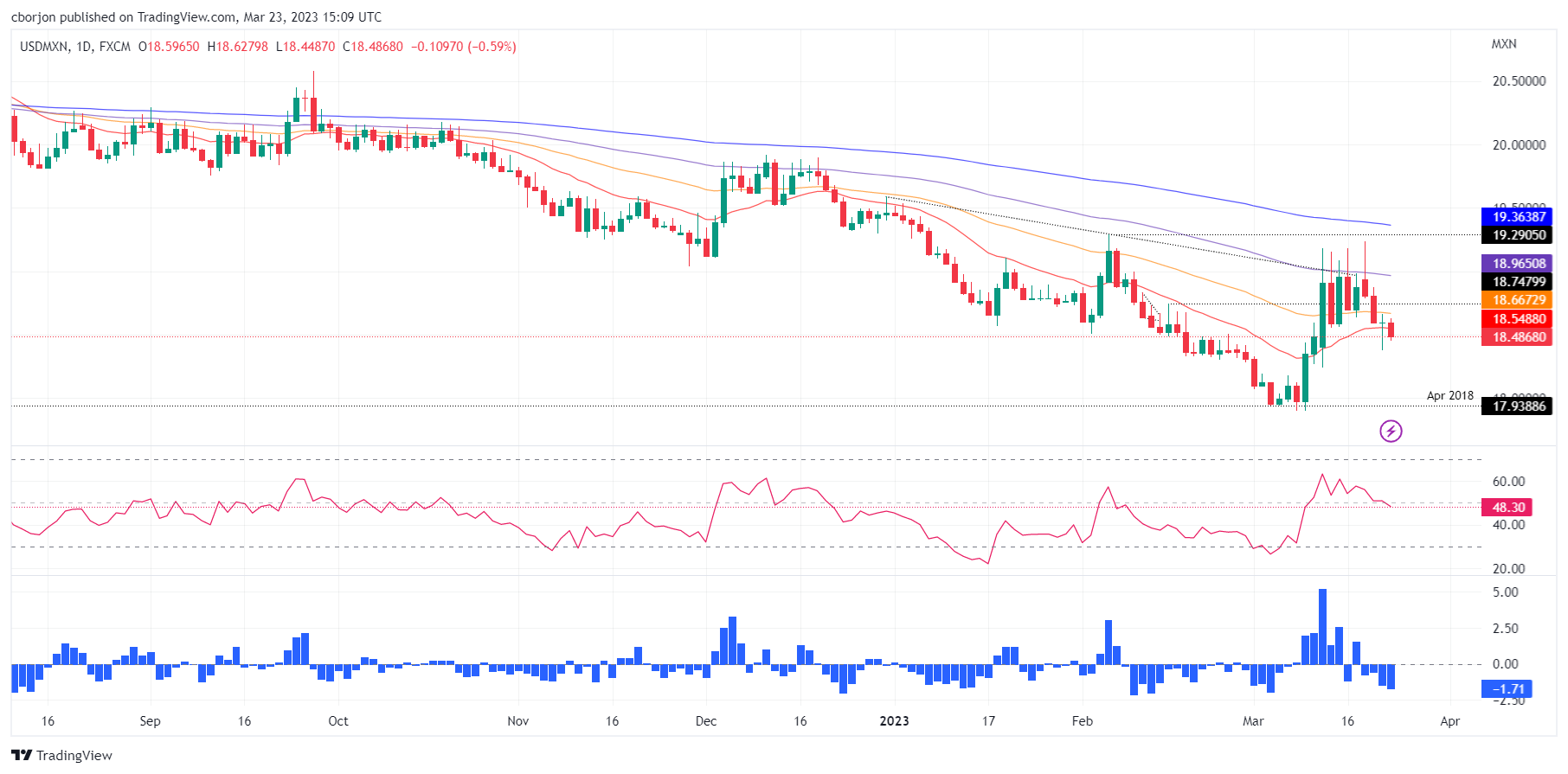
On Wednesday, the USD/MXN failed to close below the 20-day Exponential Moving Average (EMA) of 18.5524 and formed a dragonfly doji, which could open the door for further upside. Though USD/MXN traders need to reclaim the 18.8769, the pair could head up toward the $19.00 barrier. On the other hand, if the USD/MXN closes below $18.50, that would pave the way for further losses. The USD/MXN first support would be the March 23 low of 18.3776, followed by the March 13 low of 18.4487, ahead of testing the YTD low at 17.8967.
The FX market is well-advised not to base too much USD weakness on this new FOMC approach and to wait and see first. There are three reasons for that, according to economists at Commerzbank.
USD-positive risks exist
“Nobody can say with any certainty to what extent credit conditions will be tightened medium-term. Not even the Fed. If for example, everything is sunny and happy again the Fed might revise yesterday’s approach towards a steeper rate path. What is of particular relevance over the coming weeks is to what extent lending by US banks will change.”
“The ‘dots’ have shifted slightly to the upside compared with December. Without the currently expected tighter credit conditions, the FOMC would be much more aggressive. That is why there are risks towards USD strength too.”
“In the end, there is still a large discrepancy between market and FOMC expectations. It has increased as a result of last week’s events and was confirmed yesterday by the FOMC: the market expects rapid rate cuts; the FOMC does not expect that it will do that.”
- EUR/USD keeps the bid bias unchanged near the 1.0900 region.
- Further upside could see the 2023 peak near 1.1030 revisited.
EUR/USD manages to clear the 1.0900 barrier and advance to fresh multi-week highs on Thursday.
The continuation of the strong uptrend appears on the table for the time being. That said, the pair now needs to clear the March high at 1.0929 (March 23) to allow for a probable challenge of the 2023 top at 1.1032 (February 2) in the short-term horizon.
Looking at the longer run, the constructive view remains unchanged while above the 200-day SMA, today at 1.0331.
EUR/USD daily chart

Commodities are linked with currencies, especially the USD, and they usually share an inverse relationship. A weaker USD should provide some support to commodity prices in 2023, strategists at ANZ Bank report.
Supply-side issues are now subsiding
“The likely return of the traditional inverse relationship between commodity prices and the US dollar has important implications for commodity markets. With inflation easing, a weaker USD should be a tailwind for the sector.”
“Supply-side issues are now subsiding. Energy shortages in Europe have eased, and the number of disruptions to metal and oil supplies is also past its peak. So, the commodity price-USD relationship should re-emerge in 2023.”
“With the Fed’s aggressive rate hike cycle nearing its end, we expect the USD to weaken, which is likely to be a strong tailwind for commodity markets.”
- DXY remains under pressure, albeit off earlier lows in the sub-102.00 zone.
- Below the 102.00 region, the index could retest the 2023 low.
DXY retreats for the sixth consecutive session and keeps navigating the multi-week zone in the low-102.00s.
The bearish mood appears unabated for the time being. Against that, the breach of the March low at 101.91 (March 23) should put a potential test of the 2023 low near 100.82 (February 2) back on the investors’ radar.
Looking at the broader picture, while below the 200-day SMA, today at 106.60, the outlook for the index is expected to remain negative.
DXY daily chart
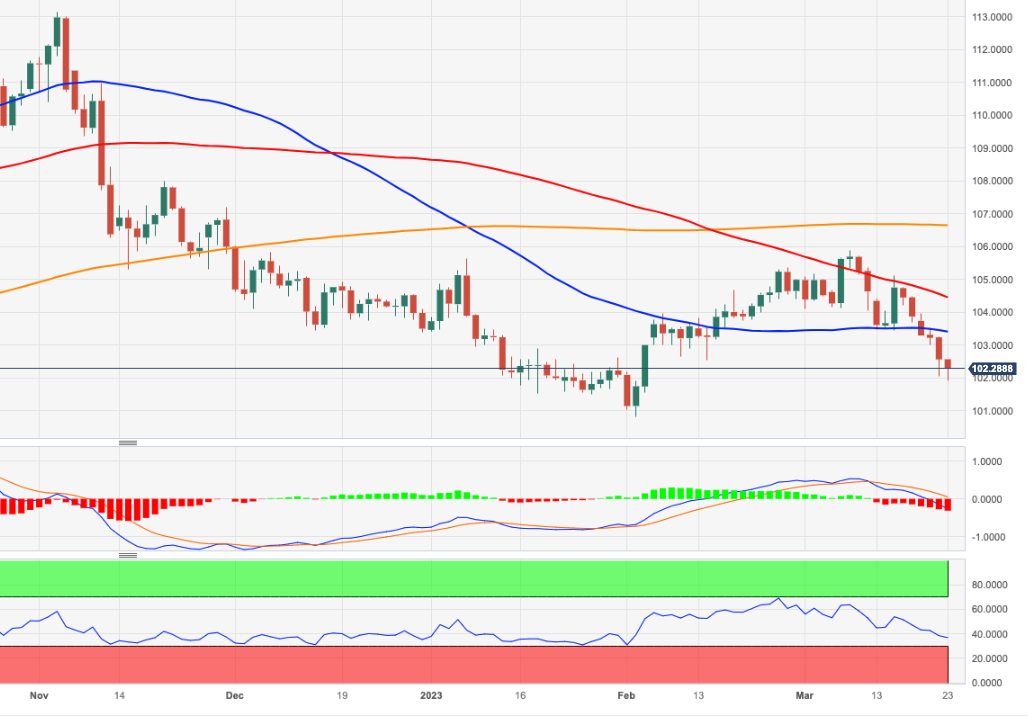
- Australian Dollar falls against G10 rivals during the European session.
- US Initial Jobless Claims drops unexpectedly, helping DXY.
- AUD/USD reverses again from 0.6750, finds support at 0.6690.
The AUD/USD was rejected again from above 0.6750 and retreat to as low as 0.6690, before bouncing back above 0.6700 after Wall Street’s opening.
Data from the US showed a larger-than-expected decline in Jobless Claims, helping the US Dollar gained some ground. Still the greenback remains under pressure after the FOMC meeting. The Federal Reserve raised it key interest rate by 25 basis points but did not commit to further rate hikes.
The US Dollar rose after the data but is weakening again after a positive opening in Wall Street. Equity prices are recovering after Wednesday’s sell-off. At the same time, US yields are moving off daily highs, adding bearish pressure to the greenback.
The Aussie was among the worst performers of the European session, with AUD/NZD reaching fresh three-day lows under 1.0700. The recovery in AUD/USD is being driven by higher equity prices and a weaker US Dollar, as the Aussie still remains weak.
From a technical perspective, AUD/USD was again rejected from above 0.6750 and pulled back. The pair is showing difficulties in extending the rally but corrections are limited, reflecting that the bullish bias is still intact.
Technical levels
- New Home Sales in the US rose at a softer pace than expected in February.
- US Dollar Index stays in negative territory but holds above 102.00.
Sales of new single‐family houses rose by 1.1% in February to a seasonally adjusted annual rate of 640,000, the data published jointly by the US Census Bureau and the Department of Housing and Urban Development showed on Thursday.
This reading followed January's growth of 1.8% came in weaker than the market expectation for an increase of 1.6%.
Market reaction
This data failed to trigger a noticeable market reaction and the US Dollar Index was last seen losing 0.3% on the day at 102.22.
Kit Juckes, Head of FX Strategy at Société Générale, analyzes the Swiss Franc outlook. He believes that the CHF is an interesting currency.
EUR/CHF is lagging EUR/USD – a feature this time, not a bug
“The speed with which the Swiss banking system was stabilised reinforces Franc’s safe-haven status. That suits the SNB now, more than usual.”
“Whereas in the past, EUR/CHF would fall when EUR/USD did (the Swiss Franc falling by less than the euro against the Dollar) and rise when EUR/USD did, EUR/CHF has decoupled from EUR/USD, allowing the CHF to rise as fast against a falling Dollar, as the Euro does.”
“The SNB appears to be more tolerant of a stronger Swiss Franc than in the past; at the same time as being less tolerant of a weaker currency in these inflationary times. Which makes the Franc a rather interesting currency.”
- EUR/JPY loses some upside momentum around 143.20.
- Further recovery looks likely above 141.81 so far.
EUR/JPY leaves behind Wednesday’s irresolute price action and advances past the 143.00 barrier, where it has so far met some decent resistance.
Despite the weekly rebound seems to have run out so steam, further upside should not be ruled out. Against that, the 2023 high at 145.56 (March 2) emerges as the next target of note prior to a potential visit to the December 2022 peak at 146.72 (December 15).
In the meantime, extra gains remain in store while the cross trades above the 200-day SMA, today at 141.81.
EUR/JPY daily chart
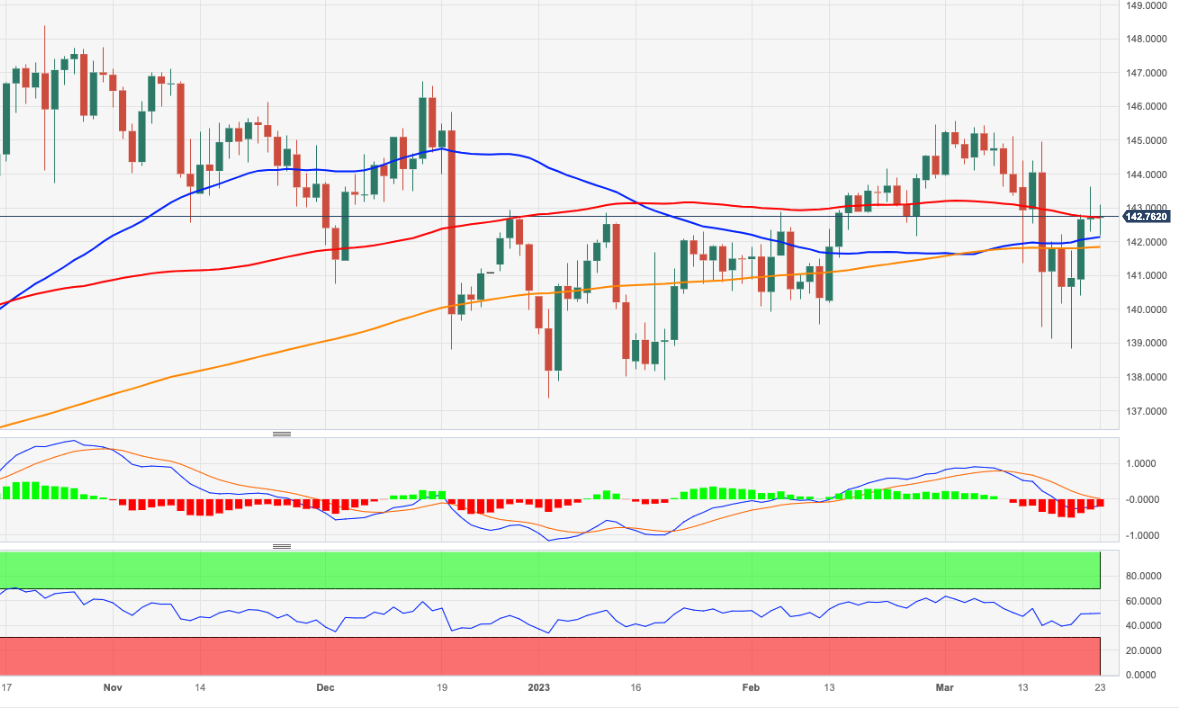
The Bank of England hiked Bank Rate today by 25 bps which triggered a fairly muted GBP response. TD Securities' bearish medium-term USD view should support GBP regardless of the BoE outlook.
GBP on a lower tier relative to EUR and JPY
“While we expect another hike in May, we don't think it will provide too much upside impetus to GBP.”
“A deeper correction in the USD should support GBP but we still think it underperforms on key crosses.”
“EUR has more upside on the links to China reopening and has seen a nice shift in the current account dynamics linked to the terms of trade reversal. EUR/GBP trades near the midpoint of the 60d range, so we would look to buy dips below 0.88.”
“Rate compression and a likely BoJ shift should boost the JPY, favoring relative outperformance versus GBP.”
“Regarding GBP/USD, we think the Fed reinforces our medium-term bearish USD outlook, increasing downside risks to our current USD forecasts. That would support GBP, but that theme favors others just a bit more.”
"We have raised interest rates a lot already, we believe inflation will fall quite rapidly before the summer," Bank of England (BoE) Governor Andrew Bailey said on Thursday.
"February inflation data means we need to see a fall in inflation happen," Bailey added. "We will go on making decisions needed for sustained low inflation."
Market reaction
These comments don't seem to be having a significant impact on Pound Sterling's performance against its rivals. As of writing, GBP/USD was up 0.4% on the day at 1.2313.
From September 2022 to January, the Dollar weakened by over 6%. Where will the USD go from here? Economists at JP Morgan expect to see a cycle of Dollar weakness.
Expensive starting point vs. fair value
“After ten years of strength, the Dollar is close to its highest level since 2001 and expensive versus long-term variables that define its ‘fair value’, such as the current account.”
Widening growth differentials
From 2012-2022, the rest of the world only grew 0.5% more than the US, a stark difference versus the 2.3% from 2001-2011. This gap is set to widen again in favor of the rest of the world to 1.2% over the next five years. This year’s positive upgrades to growth in Europe and China versus rising probabilities of a US recession is a move in that direction.”
Shrinking interest rate differentials
“By October, US 10-year yields were 2.2% higher than other developed markets. Since then, yield differentials shrank to 1.7% as other central banks joined the tightening trend. This gap is set to shrink further should the Fed pause and soon start cutting rates, as seems more likely after the regional banking stress.”
Flows returning to non-US markets
“Over the past decade, due to US economic and earnings resilience and higher interest rates, global capital flocked to US markets. However, we seem to be at the beginning of a turnaround given the change in the international growth and interest rate backdrop, together with a potential shift in market leadership.”
Sentiment is key short-term
“During risk-off moments, a flight to US safe-haven assets can overwhelm other variables. Since the regional banking stress began, bond volatility has surged. A short-term period of Dollar strength versus emerging markets currencies may follow.”
- USD Dollar gains momentum ahead of Wall Street opening bell.
- US Jobless Claims dropped more than expected.
- USD/JPY is up more than a hundred pips from the monthly low it reached earlier on Thursday.
The USD/JPY extended the rebound following the release of US economic data and printed a fresh daily high at 131.65. On Asian hours, the pair bottomed at 130.39, the lowest since February 10.
Data helps DXY’s rebound
The US Dollar was attempting to stabilize and following the release of US data it gained some momentum, helping the greenback. The DXY is down by just 0.10%, near 102.50, after hitting earlier levels below 102.00.
Initial Jobless Claims dropped by 1,000 during the week of March 18 to 191,000, against expectations of an increase to 201,000. Continuing Claims dropped by 14,000 in the week ended March 11 to 1,694,000. The numbers show the labor market remains tight.
The Chicago Fed National Activity Index (CFNAI) came in at –0.19 in February, down from 0.23 in January; forecasts were for 0.
USD/JPY rebounds
US yields printed fresh highs after the latest economic reports, although they are significantly below yesterday’s levels. The yield on the US 10-year bond rose above 3.50% while the 2-year approached 4%. The Japanese Yen was modestly impacted by the rebound in yield.
USD/JPY is hovering around 131.50, in positive ground for the day, after bouncing from monthly lows. The pair is attempting to remain above the critical support of 130.50. The bias is still to the downside.
Technical levels
S&P 500 has recovered, but economists at Credit Suisse remain biased to fade strength.
Break above 4078/90 to reassert an upward bias
“Whilst capped below the downtrend from the beginning of February and price/gap resistance at 4078/90, we continue to view the broader risk as marginally lower for a fall back to 3809, then support next at the 61.8% retracement at 3764/60 with the key 200-week average now at 3736. Our bias would then be to look for the market to stabilize around 3764/36.”
“A weekly close below 3736 would be seen to re-expose the 2022 low and 50% retracement of the 2020/2022 bull trend at 3505/3492.”
“Above 4078/90 would suggest we have seen a ‘false’ break lower to reassert an upward bias for strength back to 4195, possibly even 4312/4325.”
European Central Bank (ECB) policymaker Klaas Knot said that the ECB is unlikely to be done with rate hikes and added that the still thinks that they need to raise the policy rate in May. Knot, however, refrained from mentioning the size of the hike, as reported by Reuters.
Additional takeaways
"Core inflation shows no sign of abating; wages and services are its main drivers."
"Inflation risks clearly tilted to upside; second round wage effects increasingly visible."
"Bank turbulence must have significant permanent impact to alter inflation baseline."
"Could gradually move to full stop in AOO reinvestments if there is no more market turmoil."
Market reaction
EUR/USD continues to trade in positive territory slightly below 1.0800 following these comments.
The US Dollar is sharply weaker. FOMC shift in tone is set to undermine USD, economists at MUFG Bank report.
US banking sector substantially underperforming Europe
“The overall tone of both the statement following the expected 25 bps rate hike and the press conference by Fed Chair Powell was clearly more dovish.”
“The S&P Bank Index fell 5.6% yesterday. The sector in the US is clearly underperforming Europe which we believe will reinforce EUR/USD support.”
“The US Dollar low from early February is in sight and with banking sector confidence fragile once again we see high risks of that low for the Dollar being tested. It is really a matter of monitoring US banking sector stocks for now.”
- Chicago Fed National Activity Index declined more than expected in February.
- The US Dollar Index recovers toward 102.50 after the data.
The Federal Reserve Bank of Chicago's National Activity Index (CFNAI) declined to -0.19 in February from 0.23 in January. This reading came in weaker than the market expectation of 0.
"The CFNAI Diffusion Index, which is also a three-month moving average, moved up to +0.02 in February from –0.07 in January," the Chicago Fed noted in its publication. "Thirty-eight of the 85 individual indicators made positive contributions to the CFNAI in February, while 47 made negative contributions."
Market reaction
The US Dollar Index stages a modest rebound in the early American session and was last seen losing 0.12% on the day at 102.40.
- Initial Jobless Claims in the US decreased by 1,000 in the week ending March 18.
- US Dollar Index stays in negative territory below 102.50.
There were 191,000 initial jobless claims in the week ending March 18, the weekly data published by the US Department of Labor (DOL) showed on Thursday. This print followed the previous week's print of 192,000 and came in better than the market expectation of 201,000.
Further details of the publication revealed that the advance seasonally adjusted insured unemployment rate was 1.2% and the 4-week moving average was 196,250, a decrease of 250 from the previous week's unrevised average.
"The advance number for seasonally adjusted insured unemployment during the week ending March 11 was 1,694,000, an increase of 14,000 from the previous week's revised level," the DOL noted.
Market reaction
The US Dollar Index showed no immediate reaction to this report and was last seen losing 0.2% on the day at 102.30.
The Swiss Franc rose after the SNB hike. Economists at ING expect the EUR/CHF pair to stabilise above the 1.00 level.
Franc gains likely to emerge versus the Dollar
“The SNB actively favours a stronger CHF to limit imported inflation, but the ECB-SNB policy differential and an improvement in European sentiment are tilting the bias towards a stronger EUR/CHF at the moment, where a stabilisation above parity seems likely in light of recent developments.”
The channel where we could see the SNB hawkishness play in favour of CHF is probably through USD/CHF, where we may see a break below the 0.9080 early-February lows, also aided by the generalised USD weakness.”
Solid Euro gains saw EUR/USD extend through the low 1.09s before slipping back. Economists at Scotiabank believe that a pause and correction in the rally is due out.
Intraday price action looks weak
“Broader EUR gains look solid and well supported by bullish-leaning trend oscillators. But intraday price action looks weak and warns of a squeeze higher in the USD.”
“Short-term signals suggest a top/reversal (bearish ‘evening star’) is developing around the daily high at 1.0930.”
“Spot has gained relentlessly from last week’s low just above 1.05 so a pause and correction in the rally may be appropriate.”
“We look for support around 1.08 and (firmer) at 1.0750/75.”
- Gold price bulls come back after Federal Reserve triggers dovish interest rate hike.
- Silver price makes seven-week highs as precious metals appreciate.
- US Treasury yields fall below 3.5%, sink US Dollar value.
Gold traders are again rejoicing after the Federal Reserve (Fed) confirmed expectations of a modest 25 basis points interest rate hike on Wednesday. The bright metal has re-gained the $1,970 mark, back on the uptrend after having retraced from year-to-date highs on Monday and Tuesday. Precious metals have all benefited from the super-important central banking decision, as Silver triggered a seven-week high just short of $23 to continue with its uptrend.
The fall of the US Treasury bond yields, with the benchmark 10-year bond netting below 3.5% after the Fed decision, is behind this move, as the US Dollar, the measure of all commodity markets, including Gold and Silver, is highly correlated to it.
Gold price technicals suggest more gains to come for the bulls
Gold price still has some way to go before testing the levels above $2,000 seen on early Monday peak, a trend that is likely to continue according to market analysts.
Pablo Piovano, News Editor at FXStreet, deems another visit to the psychological round mark “on the cards”. Piovano analyzes open interest data from the CME Group in the Gold futures market to support that bullish thesis:
“The uptick in the precious metal was on the back of a small build in open interest, which remains supportive of the continuation of the upside momentum in the very near term.”
Anil Panchal, Technical Analyst at FXStreet, looks deep at the technicals of the XAU/USD price action, seeing room for a consistent rise, as Gold price remains out of overbought territory despite the uptrend seen in recent weeks:
“Gold price extends bounce off the 50-bar Simple Moving Average (SMA), backed by the looming bull cross on the Moving Average Convergence and Divergence (MACD) indicator and upbeat Relative Strength Index (RSI) line, not overbought.”
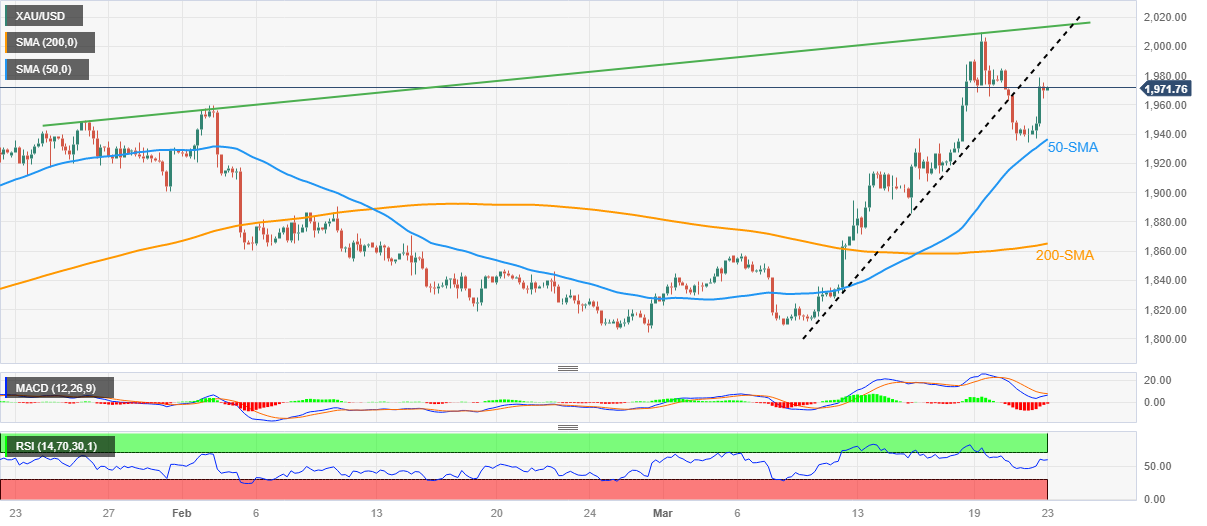
Gold price technical analysis by Anil Panchal, News Editor at FXStreet
According to Panchal, the “two-month-old upward-sloping resistance line, near $2,015, acts as the last defense of the Gold bears”.
Silver price rises to seven-week highs, but bulls face multiple hurdles ahead
The price of Silver has made even more strides than its shinier counterpart, as XAG/USD triggered a seven-week high on the back of the Federal Reserve meeting, shortly reaching the $23 mark before retracing just below it. Silver price had not rallied as abruptly last week, but it is now making more gains than Gold.
The upside of the precious metal number two is a bit more capped than Gold’s, though, as the year-to-date highs set in January are still away and remain a thick resistance cluster. According to Anil Panchal, it will not be easy for the Silver metal to make new year-to-date highs:
“Multiple hurdles marked during early 2023 guard the XAG/USD’s immediate upside near $23.30, $24.00 round figure and the $24.30 levels before challenging the Year-To-Date (YTD) high surrounding $24.65.
“Meanwhile, the aforementioned horizontal resistance-turned-support appears a tough nut to crack for the Silver bears as it comprises multiple levels marked since June 2022, as well as the 50-DMA and 100-DMA, while challenging the bears near $22.25-55.”
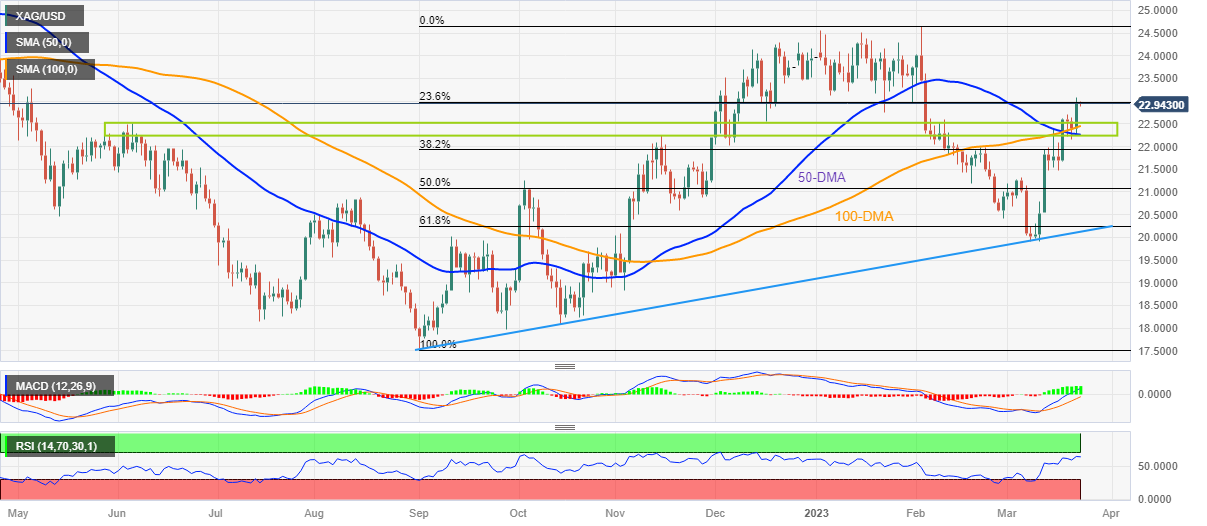
Silver price technical analysis by Anil Panchal, News Editor at FXStreet
- GBP/USD maintains the bullish bias beyond 1.2300.
- The BoE raised the policy rate by 25 bps, as expected.
- The MPC voted 7-2 to lift the key rate to 4.25%.
The upbeat note around the Sterling remains in place and motivates GBP/USD to maintain the daily bullish tone above the 1.2300 region in the wake of the BoE’s decision on rates.
GBP/USD remains bid post-BoE
GBP/USD recedes from earlier tops near 1.2340 and revisits the 1.2300 neighbourhood after the BoE raised the policy rate by 25 bps to 4.25%, as widely expected on Thursday. The vote to hike rates was 7-2, with members Tenreyro and Dhingra favouring an unchanged stance.
From the statement, the central bank still expects inflation to drop significantly in Q2 2023, while it sees the economic activity to increase slightly during the same period.
Regarding the recent effervescence in the banking sector, the Financial Policy Committee (FPC) stressed that the UK banking system remains resilient and maintained robust capital and strong liquidity positions.
GBP/USD levels to consider
As of writing, the pair is gaining 0.40% at 1.2312 and the breakout of 1.2343 (monthly high March 23) would open the door to 1.2447 (2023 high January 23) and then 1.2666 (monthly high May 27 2022). On the other hand, the next support aligns at 1.2146 (55-day SMA) followed by 1.2082 (100-day SMA) and finally 1.2010 (weekly low March 15).
- Bank of England raises key rate by 25 bps to 4.25%.
- Pound Sterling relatively steady after the decision.
- EUR/GBP prints fresh daily low at 0.8819, then climbs back to 0.8840.
The EUR/GBP dropped to 0.8819, hitting a fresh daily low after the Bank of England (BoE) raised interest rates by 25 bps; however, the cross quickly rose back to the 0.8840 area, erasing all losses.
Bank of England rises as expected
“At its meeting ending on 22 March 2023, the MPC voted by a majority of 7–2 to increase Bank Rate by 0.25 percentage points, to 4.25%. Two members preferred to maintain Bank Rate at 4%,” the BoE said. According to the BoE, “CPI inflation increased unexpectedly in the latest release, but it remains likely to fall sharply over the rest of the year.” They added “the extent to which domestic inflationary pressures ease will depend on the evolution of the economy, including the impact of the significant increases in Bank Rate so far. Uncertainties around the financial and economic outlook have risen.”
BOE hikes policy rate by 25 bps to 4.25% in March as expected - LIVE COVERAGE
Prior to the BoE, EUR/GBP was hovering around 0.8840 after rising sharply during two days in a row, from monthly lows near 0.8700. Hawkish comments from European Central Bank speakers gained credibility over the last sessions as the banking crisis eased. Monetary policy divergence could favor the Euro, but the BoE refrained to mention that it's done with monetary tightening.
The EUR/GBP is hovering around 0.8840, in negative territory for the day, but holding on to strong weekly gains. Earlier on Thursday it reached at 0.8860, the highest level in ten days.
Technical levels
Following its March policy meeting, the Bank of England (BOE) announced that it raised the policy rate by 25 basis points (bps) to 4.25% as expected. Two policymakers, Tenreyro and Dhingra, vote to keep the policy rate on hold at 4%.
"If there were to be evidence of more persistent pressures, then further tightening of monetary policy would be required," the BOE said in its policy statement.
Follow our live coverage of the BOE policy announcements and the market reaction.
Market reaction
GBP/USD is struggling to make a decisive move in either direction following the BOE's policy announcements. As of writing, the pair was trading modestly higher on the day at around 1.2300.
Key takeaways from the policy statement
"Staff forecast Q2 GDP to increase slightly (Feb forecast: -0.4%), Q1 GDP forecast unchanged at -0.1%."
"Q2 CPI likely to be lower than forecast in Feb, due to longer energy price cap and lower wholesale prices."
"CPI remains likely to fall sharply over remainder of 2023, despite upward surprise in Feb."
"Surprising strength in Feb core goods prices reflects volatile clothing prices, may not be persistent."
"UK banking system is well-placed to support economy, including in a period of higher interest rates."
"UK banking system maintains robust capital and liquidity, remains resilient."
"Will continue to monitor UK credit conditions closely."
"Fiscal support in March budget to increase GDP level by around 0.3% over coming years."
"Extended energy price guarantee to lower Q2 CPI by around 1 percentage point vs Feb forecast, other measures to lower CPI by around 0.33 percentage points."
"Wage growth likely to fall back somewhat faster than forecast in Feb due to lower inflation expectations."
"Staff expect 0.2% Q2 employment growth (Feb forecast: -0.4%), no rise in unemployment."
"Businesses see year-ahead inflation of 5.6% in 3 months to Feb vs 6.2% in 3 months to Nov."
"Businesses see year-ahead wage growth of 5.7% in Feb vs 5.8% in Nov."
EUR/NOK has moved lower following Norway’s central bank surprise on the hawkish side. However, the pair is unlikely to break under the 11.00 level, in the view of economists at ING:
EUR/NOK will remain highly volatile
“NOK is the least liquid currency in G10 and was therefore very exposed to the tightening in global financial conditions, market volatility, and lately the turmoil in the banking sector. A hawkish Norges Bank cannot counter those characteristics of the Krone, but should European sentiment continue to stabilise, it can offer a breeding ground for recovery that can ultimately help Norges Bank limit imported inflation.”
“Still, we think EUR/NOK will remain highly volatile, and a sustainable return below 11.00 will require a more substantial return of market confidence in the financial system: something that we may not see in the very near term.”
In the view of economists at Scotiabank, the GBP/USD pair is set to move back lower and test the 1.22 area.
Losses through 1.22 to trigger a more serious correction
“Short-term price action suggests some scope for a USD rebound against the GBP.
“Intraday price signals reflect a bearish development in the form of a bearish ‘evening star’-like pattern. Trend momentum signals are leaning strongly GBP-bullish at present, however, which suggests the Pound should remain well-supported on dips. But Cable could dip back to the low 1.22 zone intraday.”
“Losses through 1.22 could suggest a more serious correction is developing (towards 1.20).”
EUR/USD extends its gains on Thursday. Economists at OCBC Bank expect the pair to continue its race higher.
Is the ECB the only hawk in town?
“EUR continued to trade higher amid softer USD, dovish Fed hike while hawkish comments from ECB officials suggest that ECB may be the only hawk in town.”
“Daily momentum is bullish bias while RSI rose. Upside risks ahead.”
Resistance at 1.0940, 1.1030 (2023 high).”
“Support at 1.08, 1.0730 (50- DMA) and 1.0680 (21-DMA, 23.6% fibo retracement of Sep low to Feb high).”
SNB raises policy rate by 50 bps to 1.50%. Economists at Société Générale expect the EUR/CHF pair to regain the 1.00 level.
Additional rate rises cannot be ruled out
“The SNB raised the policy rate by 50 bps to 1.50 as expected and did not rule out additional tightening, following in the footsteps of the ECB last week. It narrows the spread vs the Euro policy rate to 150 bps, but our base case is for this to widen in the coming months if market volatility subsides. This in theory augurs well for a sustained return of EUR/CHF above parity.”
“EUR/CHF resistance at 1.0015/40.”
“Measures announced by the federal government, FINMA and the SNB have put a halt to the banking crisis.”
“The central bank revised up the inflation forecast to 2.6% for 2023 and 2.0% for 2024 and 2025.”
Sterling is trading modestly higher on the USD ahead of the BoE policy decision. Signals of a rate pause could draft the GBP down, economists at Scotiabank report.
25 bps hike expected
“The BoE is widely expected to hike 25 bps, with a 1/4 point move more or less fully priced in. Guidance will be key for the GBP’s short-term reaction.”
“We think the BoE tightening cycle is likely completed after today’s move to 4.25% so it risks sounding dovish; markets are pricing in a bit more tightening, however. Closing the door on more hikes could drive the GBP lower.”
See – BoE Preview: Forecasts from eight major banks, final 25 bps hike
EUR/NOK has slid toward the 11.20 mark. Economists at Société Générale expect the 11.00 level to floor the pair.
A move beyond 11.48 should result in extension of up move
“Last week's high of 11.48 has resulted in a brief pause however the trend line since last August at 11.00 should be an important support near term.”
“A move beyond 11.48 should result in extension of up move towards next potential hurdle at 11.70/11.75 representing peak of April 2020 and perhaps even towards 12.30, the 76.4% retracement of the whole 2020-2022 downtrend.”
The Swiss National Bank (SNB) has hiked the key deposit rate by 50 basis points to 1.50%. Economists at Commerzbank expect a further 25 bps increase in the key interest rate in June.
SNB is determined to get inflation back under control
“The Swiss central bank is showing its determination to get inflation back under control. At its meeting today, it raised its key interest rate by a further 50 basis points to 1.5%. In view of the recent market turbulence, this was not a foregone conclusion.”
“The SNB does not rule out the possibility that additional rate hikes will be necessary to ensure price stability in the medium term.”
“We expect a further rate hike of 25 bps in June.”
The Bank of England’s decision is coming up. Any hints of a pause could drag the Pound down, but at lower levels, GBP would quickly draw in fresh buying to limit the scale of decline, according to economists at MUFG Bank.
Maybe a guidance shift to hint at a pause
“We would certainly argue that a hike today is unnecessary and a close call could be reflected in further division within the MPC. We will be watching the wording on policy guidance. In February the MPC stated that ‘if there were to be evidence of more persistent pressures, then further tightening in monetary policy would be required’. The conditionality of this guidance could be flipped to signalling a pause based on the condition that inflation pressures subside as the BoE expected.
“A signal of a pause at this juncture would see rates lower and take GBP lower too although we suspect at lower levels GBP would quickly draw in fresh buying to limit the scale of decline.”
“Any decline for GBP is likely a good buying opportunity.”
See – BoE Preview: Forecasts from eight major banks, final 25 bps hike
- EUR/NOK extends the weekly leg lower to the 11.25/2000 zone.
- The Norges Bank hiked rates by 25 bps to 3.00% on Thursday.
- The central bank justified its decision on the still elevated inflation.
The Norwegian kroner gathers extra steam and forces EUR/NOK to recede to multi-day lows near 11.2000 on Thursday.
EUR/NOK weaker on NB rate hike
EUR/USD added to the ongoing weekly leg lower and revisited the 11.2500/2000 band after the Norges Bank (NB) raised the policy rate by 25 bps at its gathering earlier in the session.
In fact, the Nordic central bank said the move higher in rates comes in response to the elevated inflation – which remains stubbornly above the bank’s target – and amidst rising wage growth and the persistent tight labour market, while the weaker currency has been also playing its role.
The NB, in addition, noted that the economic activity remains healthy despite the growth in the Scandinavian economy appears to be losing some momentum.
The central bank also left the door open to another hike at the May meeting in case developments play out as the bank’s expect and sees rates at around 3.5% by the summer.
EUR/NOK significant levels
As of writing the cross is retreating 0.61% at 11.2872 and a drop below 10.9694 (55-day SMA) would open the door to 10.7963 (monthly low February 10) and finally 10.7238 (100-day SMA). On the upside, the next hurdle comes at 11.4820 (2023 high March 16) followed by 11.6965 (monthly high April 22 2020) and then 13.1492 (all-time high March 19 2020).
The Dollar weakened on the back of the moderate dovish surprise by the Fed yesterday. Economists at ING expect the US Dollar to come under more pressure.
Market’s pricing and the Dollar will remain a function of banking stress
“With a market not trusting the more ambiguous Fed communication and the US regional banking crisis far from resolved, it looks like investor bias on the Fed may stay on the dovish side. This should translate into a continued bearish bias for the Dollar, primarily against European currencies should the stabilisation in European sentiment continue.”
“Still, we see a high chance of seeing small USD upside corrections on the way, rather than a straight-line USD depreciation.”
Economists at TD Securities discuss the Bank of England interest rate decision and its implications for the EUR/GBP pair.
Hawkish Hike (5%): Hike, guidance that cycle not done
“The MPC hikes 25 bps and signals that inflation and wage persistence means that it has likely not reached its terminal rate. Emphasis is placed on the different mandates of the FPC and MPC, leaving the MPC to focus on inflation-fighting. EUR/GBP 0.8700.”
Base Case (45%): Hike, guidance roughly unchanged
“The MPC hikes 25 bps, and leaves its guidance largely unchanged, though the conditions for a further hike are tightened a little on the margin. After Wed's strong inflation, the vote is likely 2/6/1 for 0/25/50. EUR/GBP 0.8900.”
Dovish Hike (15%): MPC signals conditional pause
“The MPC signals a BoC-style ‘conditional pause’, wherein they say that rates may not necessarily rise any further (barring large surprises in the data), and it's time to take stock of the impact of past rate increases. The vote to hike is close (eg 5-4). EUR/GBP 0.8950.”
Hawkish Hold (35%): No hike, but signals intention to continue
“The MPC does not hike rates, but signals that banking sector uncertainty was the principal cause of the pause, and that if volatility settles, it may not have reached terminal yet. The vote to hold is close (eg 5-4). EUR/GBP 0.8950.”
- EUR/USD keeps the bid bias unchanged on Thursday.
- The pair tests 1.0930 and prints fresh 7-week tops.
- Flash EMU Consumer Confidence comes next in the docket.
The single currency keeps its relentless march north unabated for yet another session and motivates EUR/USD to climb to the 1.0925/30 band and record new multi-week tops on Thursday.
EUR/USD firmer post-Fed
EUR/USD advances for the sixth session in a row so far on Thursday on the back of the persevering selling pressure around the greenback, which in turn morphed into a new multi-week lows for the USD Index (DXY) just below the 102.00 yardstick earlier in the session.
The pair’s upside, in the meantime, appears reinforced by tailwinds following the dovish hike by the Fed at its Wednesday’s gathering along with the equally downbeat message from Chair Powell at his press conference in the wake of the bank’s decision to raise rates by 25 bps.
The domestic calendar will only include the flash gauge of the Consumer Confidence for the current month measured by the European Commission.
In the US, usual weekly Claims are due along with the Chicago Fed National Acitvity Index and New Home Sales.
What to look for around EUR
EUR/USD maintains the optimism well and sound and now looks to consolidate the strong rebound past the 1.0900 barrier and with the immediate target at the so far 2023 highs near 1.1030.
In the meantime, price action around the European currency should continue to closely follow dollar dynamics, as well as the potential next moves from the ECB in a context still dominated by elevated inflation, although amidst dwindling recession risks for the time being.
Key events in the euro area this week: EMU Flash Consumer Confidence, European Council Meeting (Thursday) - European Council Meeting, EMU, Germany Flash PMIs (Friday).
Eminent issues on the back boiler: Continuation, or not, of the ECB hiking cycle. Impact of the Russia-Ukraine war on the growth prospects and inflation outlook in the region. Risks of inflation becoming entrenched.
EUR/USD levels to watch
So far, the pair is gaining 0.29% at 1.0886 and the break above 1.0929 (monthly high March 23) would target 1.1032 (2023 high February 2) en route to 1.1100 (round level). On the flip side, there is initial support at 1.0730 (55-day SMA) followed by 1.0606 (100-day SMA) and finally 1.0516 (monthly low March 15).
EUR/USD has reached its highest level in nearly eight weeks above 1.0920. 1.1000 is a key benchmark level for the pair, economists at ING report.
EUR/USD to hit 1.15 in the second half of 2023
“The next key handle for EUR/USD is 1.1000: that is an important benchmark level that may see some significant resistance unless markets feel substantially confident the worst of the banking shock – especially in Europe – is past us.”
“But even if the Fed has pushed ahead with tightening, its rhetoric compared to the ECB is appearing more dovish, particularly when it comes to rate cuts. All this points to a supported EUR/USD in the remainder of this year and we target 1.15 in the second half of 2023.”
- Gold bulls drive price back up after Federal Reserve signals less future rate hikes likely.
- Federal Reserve Chairman Powell highlights banking risks, suggesting these may do the work of tightening for the Fed.
- US Dollar weakens on the news, and negatively correlated Gold rises.
Gold price shot higher after the March FOMC meeting on Wednesday, reaching a peak of $1,978, close to where it still trades on Thursday at the start of the European Session. The ore beloved of king Midas of Phrygia rose after the US Federal Reserve (Fed) suggested tighter credit conditions due to banking stress might do the job of bringing down inflation on its behalf and that it would, therefore, probably not have to raise rates as much as expected in the future.
Gold rose because the expectations of lower interest rates are viewed as bullish for the metal since it doesn’t yield holders a return unlike cash (deposits) or cash equivalents.
Gold news: Dovish hike from the Fed
At its FOMC meeting on Wednesday, March 22, the US Federal Reserve increased the Fed Funds Rate a quarter of a percent to a target range of 4.75%-5.00%, in line with market expectations, raising the base interest rate at which banks lend to each other.
Whilst this would have normally been expected to be bearish for the Gold price, it had already been priced in by markets as a base case scenario.
The Fed’s Summary of Economic Projections (SEP), published at the same time as the decision, however, showed a lower-than-previous future rate hike trajectory in the dot plot. The Fed now forecasts a terminal rate of only 5.10%, just above the current range, and it was this that began pushing Gold price higher.
In addition, the Chairman of the Federal Reserve, Jerome Powell, stated in the press conference after the meeting that it was possible the Fed might not need to raise rates as much as expected, because the credit crunch caused by the banking crisis would do the work for them. This further drove Gold higher.
"Possible tightening in credit conditions may mean monetary tightening has less work to do," said Powell.
US Dollar falls under weight of Powell’s statements
The US Dollar, which has an inverse relationship to Gold price, fell after the Fed meeting, since the expectation of lower interest rates tends to be negative for the currency.
The Dollar Index, which measures the value of the USD against a weighted basket of counterparts fell 0.14% on Wednesday to close at 101.97.
Gold is priced in Dollars on international markets, so a weaker US Dollar buys less Gold and vice-versa for a stronger USD, all other things being equal.
Gold price technical analysis: The trend is bulls’ friend
Gold price has recovered and risen back up in line with the dominant short-term uptrend, shown clearly on the 4-hour chart below.
Since ‘the trend is your friend’, as the saying goes, the probabilities support a continuation higher, with a break above the $1,984 highs of the previous bar signaling an extension higher.
The underside of the just-broken trendline is likely to present an initial target and resistance at $1,991 and the Gold price will probably pullback at that level, however, an eventual rally all the way to the yearly highs at $2,009 is quite possible.
The Relative Strength Index (RSI) is mirroring price action, supporting the recovery.
-638151603924340885.png)
Gold price: 4-hour Chart
Considering advanced prints from CME Group for natural gas futures markets, open interest dropped by around 7.5K contracts after four consecutive daily builds on Wednesday. Volume followed suit and shrank by around 7.5K contracts, reversing the previous daily uptick.
Natural Gas: The $2.00 region emerges as the next target
Prices of natural gas retreated on Wednesday, although the negative price action was in tandem with diminishing open interest and volume. Against that, the likelihood of a deeper drop appears somewhat curtailed in the very near term. The commodity, in the meantime, faces the next support of note around the $2.00 mark per MMBtu.
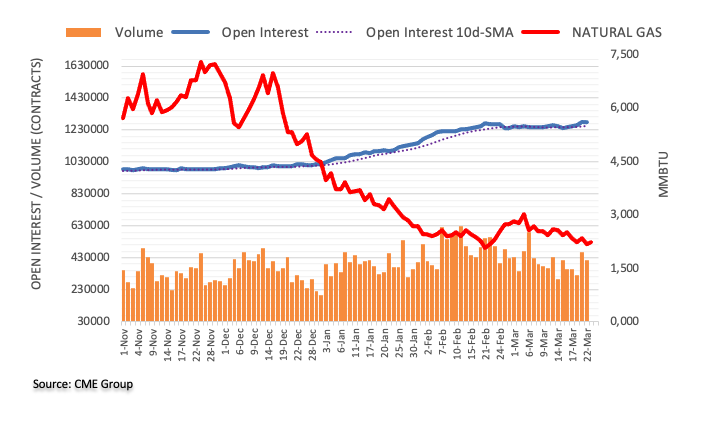
The Central Bank of Brazil (BCB) remained on hold and disappointed dovish longings. Economists at TD Securities expect the rates curve (OD futures curve) and BRL to react to a hawkish BCB by delaying prospects for first cuts towards Q3 and strengthen against the USD towards 5.15 levels, respectively.
BCB remains hawkish and vigilant
“BCB remained on hold and disappointed dovish longings, as we expected. The central bank kept its hawkish profile justified by higher inflation forecasts, unanchored inflation expectations, and financial-market volatility.”
“We expect markets to partially fade prospects of rate cuts in Q1 and Q2. As of the March 22 closing, the OD futures curve was pricing in nearly 50bps of cuts for H1 2023. We think such expectations will be pushed towards Q3 — in line with our own forecast.”
“In the case of the BRL, we think a hawkish BCB should imply stronger levels against the USD. We expect the BRL to travel towards 5.15 from the current 5.24 as a response to the BCB decision.”
Swiss National Bank governing board member Andrea Maechler said on Thursday, “tension on the financial markets has markedly increased following the collapse of Silicon Valley Bank.”
"US dollar liquidity is particularly sought after," added Maechler, in remarks prepared after the SNB’s 50 bps rate hike decision.
Related reads
- SNB’s Jordan: Taking a risk on a Credit Suisse bankruptcy would have been irresponsible
- SNB hikes key deposit rate by 50 bps to 1.50%, as widely expected
Swiss National Bank (SNB) Chairman Thomas Jordan is addressing a press conference after the central bank announced a 50 basis points (bps) rate hike, lifting the key rate to 1.50% in the March quarter.
Key takeaways
“Taking a risk on a Credit Suisse bankruptcy would have been irresponsible.”
“Our liquidity measures are not gifts.”
“Measures taken by the federal government, FINMA and SNB have put a halt to the crisis.”
“We raising rates to counter the renewed increase in inflationary pressure.“
“Further rate rises cannot be ruled out to ensure price stability.”
“Are also willing to be active in forex markets; recent focus has been on selling forex.”
“Swiss inflation is still clearly above the range for price stability.“
“Inflationary pressure has risen since December.”
“In Q4 2022 SNB sold forex worth around 27 billion Francs.”
“We will sell forex in the future and also remain willing to buy to counter excessive appreciation pressure on Franc.”
Market reaction
USD/CHF consolidates losses near 0.9135 on the above comments, shedding 0.45% on the day.
The Bank of England (BoE) is forecast to hike its key rate by 25 bps to 4.25%. In the view of economists at ING, GBP/USD is set to climb toward 1.25 in the coming days.
BoE to hike
“Markets are now fully pricing in a 25 bps scenario and will therefore look for some indications that the further 40 bps currently embedded in the GBP OIS curve is warranted.”
“The division within the BoE’s MPC may be nothing but exacerbated by the recent market turmoil, the risk is that markets may receive very little guidance on future policy paths.”
“Ultimately, the Pound may rapidly default to being driven by external factors: primarily the banking situation and global risk sentiment. A test of 1.25 in Cable in the coming days is looking quite likely.”
See – BoE Preview: Forecasts from eight major banks, final 25 bps hike
- EUR/CHF abandons the area of 3-week highs near 1.0000.
- The SNB hiked rates by 50 bps, matching consensus.
- The SNB leaves the door open to extra hikes in the near future.
The Swiss franc regains traction and drags EUR/CHF to the 0.9930 region in the wake of the SNB interest rate decision on Thursday.
EUR/CHF: Gains look limited near 1.0000
EUR/CHF comes under pressure and retreats from earlier 3-week highs in levels just shy of the parity following the 50 bps rate hike by the SNB at its meeting on Thursday.
The central bank revised up its inflation projections and now sees consumer prices rising 2.6% this year and 2.0% in 2024 vs. previous forecasts at 2.4% and 1.8%, respectively.
Regarding the GDP, the SNB suggests the economic growth is likely to remain modest for the remainder of the year and the economy is seen expanding 1.0% in 2023 (vs. the December forecast at 0.5%).
The SNB also hinted at the view that inflation could return yo more moderate levels over the medium term in response to the current monetary policy stance and the slower pace of the economic activity.
EUR/CHF significant levels
As of writing the cross is losing 0.02% at 0.9950 and the breach of 0.9836 (200-day SMA) would expose 0.9705 (2023 low March 15) and then 0.9643 (weekly low October 12 2022). On the flip side, the next resistance appears at 0.997 (weekly high March 23) seconded by 1.0041 (monthly high March 2) and finally 1.0097 (2023 high January 13).
In its monetary policy statement, the Swiss National Bank (SNB) highlights the persistent risks to Switzerland’s real estate sector while noting that more tightening could be on the cards.
Also read: SNB hikes key deposit rate by 50 bps to 1.50%, as widely expected
Key quotes
Does not rule out further interest rate rises.
It cannot be ruled out that additional rises in the snb policy rate will be necessary to ensure price stability over the medium term.
Remains ready to intervene in currency markets.
To provide appropriate monetary conditions, the SNB also remains willing to be active in the foreign exchange market as necessary.
Inflation has risen again since the beginning of the year, and stood at 3.4% in february.
The latest rise in inflation is principally due to higher prices for electricity, tourism services and food.
Stronger second-round effects and the fact that inflationary pressure from abroad has increased again mean that, despite the raising of the snb policy rate, the new forecast is higher through to mid-2025 than in december.
Without today’s policy rate increase, the inflation forecast would be even higher over the medium term.
The growth outlook for the global economy in the coming quarters remains subdued.
In the short-term, the main risks are an economic downturn abroad and adverse effects of the turmoil in the global financial sector.
Over the medium-term inflation should return to more moderate levels, not least thanks to monetary policy and due to the economic slowdown.
Market reaction
At the time of writing, USD/CHF is holding the lower ground near 0.9130, losing 0.48% on the day.
In its quarterly monetary policy assessment, the Swiss National Bank (SNB) raised its benchmark sight deposit interest rate by 50 basis points (bps) from 1.0% to 1.50% in March, as widely expected.
The SNB raises rates for the fourth straight meeting, with markets now expecting the final hike to come in June.
Summary of the statement
The SNB is tightening its monetary policy further.
In doing so, it is countering the renewed increase in inflationary pressure.
It cannot be ruled out that additional rises in the snb policy rate will be necessary to ensure price stability over the medium term.
To provide appropriate monetary conditions, the SNB also remains willing to be active in the foreign exchange market as necessary.
For some quarters now, the focus has been on selling foreign currency.
SNB sees 2023 swiss growth at around 1 % vs dec forecast for growth around 0.5%.
SNB sees 2023 inflation at 2.6 % (previous forecast was for 2.4%).
SNB sees 2024 inflation at 2.0 % (previous forecast was for 1.8%).
SNB sees 2025 inflation at 2.0%.
SNB sees Q4 2025 inflation at 2.1%.
Market reaction
In a knee-jerk reaction to the SNB rate hike decision, the USD/CHF pair dropped nearly 40 pips to test 0.9120, down 0.52% on the day.
About SNB Rate Decision
The Swiss National Bank conducts the country’s monetary policy as an independent central bank. It is obliged by the Constitution and by statute to act in accordance with the interests of the country as a whole. Its primary goal is to ensure price stability, while taking due account of economic developments. In so doing, it creates an appropriate environment for economic growth.
The FOMC delivered a 25 bps increase in the Fed Funds target range to 4.75%-5.00%. A policy messaging wedge with the ECB allows scope for the Euro to exercise some monetary dominance, economists at TD Securities report.
EUR to perform against currencies where central banks have committed to a pause
“Tone from the Fed is decisively different than the ECB, which is now celebrating the idea that they successfully averted contagion and financial system turmoil. Moreover, they seem to suggest that they can keep hiking. That may be the case (we expect some additional tightening), but it allows scope for EUR to exercise some monetary dominance.”
“There is less room for adjustment on the curve versus SOFR into the late whites and up to the mid-reds. We think this will be particularly impactful on crosses and against currencies whose central banks have already expressed or committed to move itself to the sidelines. That means that EUR/CAD and EUR/AUD should have more room to the upside.”
CME Group’s flash data for crude oil futures markets noted traders increased their open interest positions for the second session in a row on Wednesday, this time by nearly 24K contracts. On the other hand, volume went down for the third straight session, now by around 128.8K contracts.
WTI: Gains remain capped by the $80.00 region
Prices of the WTI extended the rebound on Wednesday amidst rising open interest, which is indicative that further gains remain in store in the very near term. Against that, the commodity seems under pressure while below the February/March peaks just above the $80.00 mark per barrel.
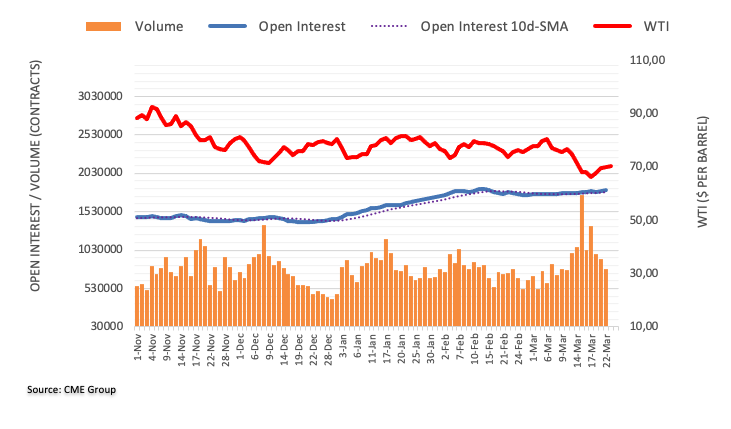
Economists at ING expect Norges Bank to hike the policy rate by 25 bps to 3.00% as they have been signalling. The Norwegian Krone is set to enjoy gains today.
NB could revise the peak rate higher
“We expect a hike in Norway by 25 bps as previously announced and widely expected. Norges Bank will also publish the updated rate projections, which currently embed only another 10bp worth of tightening.
“We think NB could revise the peak rate higher on the back of higher inflation and despite the recent turmoil, if nothing else to counter the recent NOK weakness. We expect gains in the Krone today.”
See – Norges Bank Preview: Forecasts from five major banks, 25 bps hike, but there could be a hawkish surprise
The Swiss National Bank (SNB) decision is on the agenda for today. Economists at Commerzbank analyze how the SNB Monetary Policy Announcement could impact the Franc.
SNB might also be considering that the medium-term damage can be reduced
“If the SNB were to implement only a 25 bps rate step or refrain from one altogether that would not immediately be good news for the Franc. However, the SNB might also be considering that the medium-term damage can be reduced.”
“If the SNB were to credibly communicate to the market today that no step or 25 bps are nothing else but a wait-and-see approach until the effects of the recent turbulence can be gauged and if it were to communicate credibly that the rate step not taken today would be made up for in the near future, the result would not have to be as awful for CHF as one might think. In that case, everything would depend on SNB Chair Thomas Jordan’s communication skills in today's SNB press conference.”
See – SNB Preview: Forecasts from six major banks, acting with caution
Economist at UOB Group Lee Sue Ann suggests the BoE could be approaching the end of its tightening cycle with the expected 25 bps rate hike later on Thursday.
Key Takeaways
“Headline CPI unexpectedly jumped in Feb, to 10.4% y/y, the first increase in four months, after a 10.1% y/y gain in Jan. On a monthly basis, headline CPI was up 1.1%, exceeding a forecast of 0.6%, and against the fall of 0.6% in Jan. Core inflation rose to 6.2% y/y from 5.8% y/y in Jan.”
“Prior to the release of Feb’s CPI readings, we had argued that the upcoming Bank of England (BOE) decision for Mar was a close call. With this latest inflation snapshot and ongoing worries about a tight labour market, we think the banking turmoil will likely be more of a background concern for the BOE, tipping the balance in favour of a rate hike.”
“We are thus looking for a 25bps rate hike when the BOE announces its latest monetary policy decision at 8pm SGT later this evening (23 Mar). The minutes of the meeting will be published alongside the decision. This, however, could be the final hike of the current tightening cycle. We bear in mind that the rise in interest rates is taking place against a backdrop of difficult economic conditions in the UK.”
The Fed raised its policy rate by 25 basis points (bps) to the range of 4.75-5%. EUR/USD jumped to 1.09 – the highest level since the beginning of February. However, economists at Danske Bank still expect the pair to move downward over the coming months.
A cautious 25 bps hike
“Fed hiked by 25 bps in line with our expectations but sent a dovish signal by emphasizing that Fed is ready to pause if credit conditions tighten markedly.”
“We stick to our call for a final 25 bps hike in May. We expect the Fed to maintain the policy rate at 5.00-5.25% through 2023.”
“We still see EUR/USD moving lower to 1.02 in 6M horizon. Relative rates have favoured EUR after the more hawkish ECB last week, but a prolonged rally in EUR/USD could support a renewed uptick in commodity prices and inflation expectations, and thus hinder a return to 2% inflation.”
The Federal Reserve hiked its benchmark rate by 25 basis points (bps) in a unanimous decision but softened its tone on further increases. We are getting very close to terminal, in the opinion of economists at RBC Economics.
Dovish 25 bps hike
“25 bps hike was largely anticipated, but only after market expectations whipsawed in recent weeks.”
“Fed says recent developments will tighten credit conditions and weigh on the economy.”
“Statement flags ‘some additional policy firming’; dot plot median points to one more hike.”
Open interest in gold futures markets resumed the uptrend and increased by just 554 contracts on Wednesday, according to preliminary readings from CME Group. Volume, instead, shrank for the third consecutive session, now by around 9.6K contracts.
Gold: Another visit to $2000 appears on the cards
Gold prices reversed two consecutive daily pullbacks and printed a marked bounce in the wake of the FOMC event on Wednesday. The uptick in the precious metal was on the back of a small build in open interest, which remains supportive of the continuation of the upside momentum in the very near term. That said, bullion could now attempt another move to the key $2000 mark per ounce troy.

Senior Economist at UOB Group Alvin Liew reviews the latest FOMC event, where the Federal Reserve hiked rates by 25 bps, as widely expected.
Key Takeaways
“The Federal Reserve (Fed) in its 21/22 Mar 2023 Federal Open Market Committee (FOMC) meeting, unanimously agreed to keep to its rate hike pace of 25bps, same as Feb FOMC, lifting the Fed Funds Target Rate (FFTR) to 4.75%5.00%. This is the highest level of FFTR since Sep 2007.”
“In the monetary policy statement (MPS), the Fed kept its text on the economy, was more bullish on labor market but it included a mention about the US banking system and more importantly, a key part of the FOMC statement has been adjusted to: ‘the Committee anticipates that some additional policy firming may be appropriate in order to attain a stance of monetary policy that is sufficiently restrictive to return inflation to 2 percent over time’ which sounded less assertive compared to the previous statement that ‘ongoing increases in the target range will be appropriate’ (in the Feb FOMC).”
“For the Dotplot, the median terminal rate forecast was unchanged at 5.1%, and only one Fed official put his/her dot below 5%, with most of the members’ dots coalescing just above 5%, suggesting expectations of at least one more 25-bps hike at this juncture, while seven members expect 50 to 75 bps of hikes. And for the Summary of Economic Projections (SEP), while the FOMC members remained concerned about near term inflation pressures, growth outlook is increasingly weighted on the downside, implying more negative impact from its rate hiking cycle.”
“FOMC Outlook – One More and Done At 5.25%? In light of the ‘less assertive’ language change in the FOMC statement and Powell’s comments (on possible tightening in credit conditions may mean monetary tightening has less work to do), we are adjusting our terminal FFTR level lower to 5.25% (previous: 5.75%), factoring in a final 25bps hike at the May 2023 FOMC meeting. We expect no rate cuts this year and this terminal rate of 5.25% to last through 2023.”
The Bank of England (BoE) will announce its interest rate decision on Thursday, March 23 at 12:00 GMT and as we get closer to the release time, here are the expectations forecast by the economists and researchers of eight major banks.
The BoE will likely deliver a 25 basis points (bps) rate hike, raising the key policy rate from 4.0% to 4.25%. It will be the eleventh straight hike and probably the final one before the central bank adopts a wait-and-see approach.
TDS
“The BoE was one of the first G10 central banks to start this hiking cycle, and we expect it to be one of the first to end the cycle, with a 25 bps hike to 4.25%. The decision, however, is finely balanced. We do not expect the MPC to formally announce that it has reached terminal, leaving the door open to further hikes. The BoE will be overshadowed by the Fed, which will be far more consequential. That said, the last 25 bps hike of this cycle may have more significance for EUR/GBP. Barring another major shock, 0.8700/50 should be solid support and a case to leg into topside. We also see downside risks to Cable given GBP's tactically rich valuation.”
Danske Bank
“We expect the BoE to hike the Bank Rate by 25 bps. We expect this to mark the peak in the Bank Rate of 4.25% as the BoE is set to signal a pause in the hiking cycle. We expect EUR/GBP to move slightly lower upon announcement. Overall, we regard the relative central bank outlook to be a positive for EUR/GBP but with other factors acting as a headwind, we increasingly see a case for continued range trading in the cross.”
ING
“We lean towards a 25 bps increase as the impact of past hikes has yet to feed through.”
Rabobank
“We expect the BoE to slow down its tightening cycle and stick to our call of a 25 bps increase to 4.25%. Although global financial instability risks have widened the range of potential outcomes, we do not believe the MPC’s decision-making has changed in response. Our view remains that the balance is tilted towards inflation risk, while non-interest rate tools could be used to mitigate the impact of financial contagion.”
Nomura
“We stick with our long(ish)-held view that the BoE will raise rates by a final 25 bps. After peaking at 4.25% we see the Bank keeping rates on hold for around a year before cutting by 75 bps around the middle of 2024 (leading rates back to 3.50%).”
SocGen
“We conclude that the MPC has further to tighten but in smaller steps of 25 bps. In the absence of a further flare-up of liquidity concerns, we expect this next move of 25 bps to be at the 23 March meeting, probably followed by a final 25 bps in May. The vote is likely to be 7-2.”
Wells Fargo
“We expect the BoE to hike rates 25 bps to 4.25%, smaller than the 50 bps hike delivered in January. With inflation also now more clearly on a slowing trend, we believe that this week could also prove to be the final rate hike of the current cycle.”
Credit Suisse
“We expect the BoE to vote 1-6-2 for a 25 bps hike but it is a very close call. We expect one member to vote for a 50 bps hike, six for a 25 bps hike, and two for unchanged rates.”
- The index extends the bearish move below the 102.00 mark.
- Markets continue to adjust to the Fed’s dovish hike.
- Weekly Claims, New Home Sales, takes centre stage later on Thursday.
The greenback, in terms of the USD Index (DXY), remains well on the defensive and breaks below the 102.00 yardstick for the first time since early February.
USD Index weaker post-FOMC
The last time the index retreated for six consecutive sessions was in mid-October 2021.
The dovish hike by the Federal Reserve on Wednesday in combination with the equally disheartening message from Chief Powell at his press conference lent further legs to the downtrend in the buck and dragged the index to new multi-week lows.
The lack of traction in US yields across the curve, in the meantime, accompanies the marked move lower in the index for the time being.
In the US data space, usually weekly Initial Claims, New Home Sales and the Chicago Fed National Activity Index will be in the limelight later in the NA session.
What to look for around USD
The index remains well under pressure and slips back to multi-week lows in the sub-102.00 region, as investors continue to digest the latest Fed’s gathering.
In the meantime, diminishing banking jitters continues to lend support to the risk complex and keeps the price action around the buck well depressed for the time being.
So far, speculation on a potential Fed’s pivot in the short-term horizon should weigh on the dollar, although the still elevated inflation, the resilience of the US economy and the hawkish narrative from Fed speakers is seen playing against that view.
Key events in the US this week: Initial Jobless Claims, Chicago Fed National Activity Index, New Home Sales (Thursday) – Durable Goods Orders, Advanced PMIs (Friday).
Eminent issues on the back boiler: Rising conviction of a soft landing of the US economy. Persistent narrative for a Fed’s tighter-for-longer stance. Terminal rates near 5.5%? Fed’s pivot. Geopolitical effervescence vs. Russia and China. US-China trade conflict.
USD Index relevant levels
Now, the index is retreating 0.44% at 102.07 and the breach of 101.93 (monthly low March 23) would open the door to 100.82 (2023 low February 2) and finally 100.00 (psychological level). On the other hand, the next resistance emerges at 105.88 (2023 high March 8) seconded by 106.60 (200-day SMA) and then 107.19 (weekly high November 30 2022).
Here is what you need to know on Thursday, March 23:
After having suffered heavy losses against its rivals after the US Federal Reserve's (Fed) policy announcements late Wednesday, the US Dollar continues to weaken early Thursday. The Swiss National Bank (SNB) and the Bank of England (BOE) will announce interest rate decisions later in the session. The US economic docket will feature weekly Initial Jobless Claims, Chicago Fed National Activity Index and New Home Sales data for February. Finally, Eurostat will publish preliminary Consumer Confidence for March.
As expected, the Fed raised its policy rate by 25 basis points (bps) to the range of 4.75-5% following its March policy meeting. In its policy statement, the Fed dropped the reference to "ongoing increases" in rates and said that some additional policy firming may be appropriate. Additionally, the revised Summary of Economic Projections revealed that the terminal rate projection remained unchanged at 5.1%. Regarding the Silicon Valley Bank's collapse and its implications, FOMC Chairman Jerome Powell noted that they were likely to see tighter financing conditions and noted that this would assist them in cooling down the economy. Finally, Powell told reporters that they have not talked about making any changes to the balance sheet implementation.
Meanwhile, US Treasury Secretary Janet Yellen told the Senate Appropriations Committee on Wednesday that they are not considering or discussing anything to do with blank insurance or guarantees for bank assets.
Following Tuesday's rebound, the benchmark 10-year US Treasury bond yield turned south and fell nearly 5% on Wednesday. In turn, the US Dollar Index came under bearish pressure late Wednesday and extended its slide early Thursday, falling below 102.00 for the first time since early February. Wall Street's main indexes fell sharply and closed deep in negative territory on Wednesday but US stock index futures are up between 0.5% and 0.8% early Thursday.
USD/CHF continues to push lower following Wednesday's drop and was last seen trading slightly below 0.9150. The SNB is widely expected to raise its policy rate by 50 basis points to 1.5%.
GBP/USD capitalized on the broad-based US Dollar weakness and gathered bullish momentum. The pair clings to its gains above 1.2300 early Thursday. The BOE is forecast to hike its key rate by 25 bps to 4.25% following Wednesday's hot inflation figures from the UK. Since there will not be a press conference, the vote split could drive Pound Sterling's performance against its major rivals.
BoE Interest Rate Decision Preview: Preparing ground for a rate hike pause in May.
Following Wednesday's impressive upsurge, EUR/USD stretched higher in the Asian session on Thursday and reached its highest level in nearly eight weeks above 1.0920.
USD/JPY came under renewed bearish pressure after the Fed event and broke below 131.00. In the early European session, the pair stays on the back foot and trades in negative territory at around 130.70.
Gold price capitalized on plummeting US yields and gained more than 1% on Wednesday. XAU/USD preserves its bullish momentum and trades higher on the day near $1,980.
Bitcoin turned south late Wednesday and lost more than 3%. BTC/USD, however, found its footing early Thursday and started to climb toward $28,000. After having lost nearly 4% on Wednesday, Ethereum is up 1% early Thursday, trading slightly above $1,750.
- EUR/USD picks up bids to extend six-day uptrend towards two-month high.
- Multiple hurdles marched since late January challenge Euro pair buyers.
- Sellers need validation 200-SMA, weekly support line restricts immediate downside.
- MACD favors bulls but RSI (14) line suggests limited room towards the north.
EUR/USD bulls occupy the driver’s seat for the sixth consecutive day as they prod 1.0930 mark to renew a seven-week high during early Thursday.
In doing so, the Euro pair extends the Federal Reserve (Fed) inspired gains during the one-week-old upward trajectory, as marked by an ascending trend line from March 15, amid bullish MACD signals.
However, a two-month-old horizontal resistance area surrounding 1.0930-35 joins the overbought RSI (14) line to challenge the EUR/USD buyers.
Hence, it becomes necessary for the pair to provide a successful break of 1.0930 to keep the bulls in dominating position otherwise the bears could cheer good profits on a U-turn.
It should be noted that a downward-sloping resistance line from May 2022, around 1.0950 by the press time, also acts as a short-term upside filter for the EUR/USD pair.
That said, a sustained break of 1.0950 could quickly propel the EUR/USD price toward the monthly high of 1.1033. However, the 1.1000 psychological magnet may act as an intermediate halt during the run-up.
On the flip side, a one-week-old ascending support line, close to 1.0800, puts a floor under the EUR/USD price.
However, the pair sellers should remain cautious unless the quote remains beyond the 200-SMA support of 1.0665.
EUR/USD: Four-hour chart
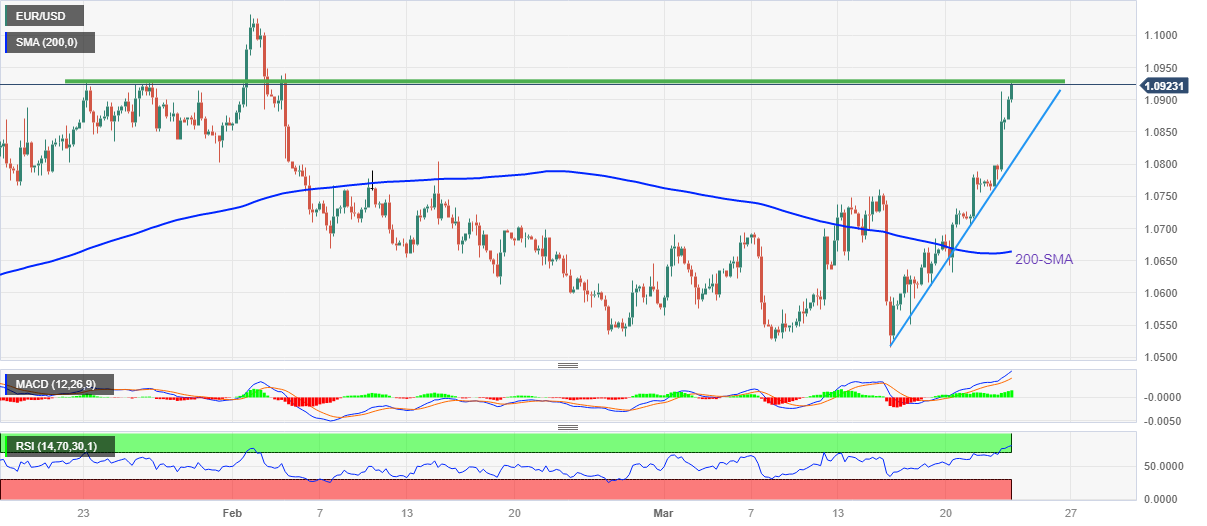
Trend: Limited upside expected
Gold price is building on Wednesday’s upsurge this Thursday. XAU/USD is set to retake $2,000, FXStreet’s Dhwani Mehta reports.
Gold price is forming a bull pennant on the daily chart
“Gold price is charting a potential bull pennant on the daily chart. Gold buyers need a daily candle stick close above the falling trendline resistance at $1,975 to validate the bullish continuation pattern. An upside break will call for a test of Tuesday’s high at $1,985, above which the $2,000 round figure will get challenged.”
“On the other side, if Gold bulls fail to sustain at higher levels, any retracements could prod the intraday low at $1,965, below which the static support at $1,960 will be threatened. Deeper declines will expose the $1,950 demand area, opening floors for a test of the falling trendline support at $1,926.”
See – Gold Price Forecast: XAU/USD on course to retest its $2,070/2075 record highs – Credit Suisse
European Central Bank (ECB) Governing Council member Madis Muller said on Thursday, “the ECB should likely raise rates by a little.”
Additional quotes
“Inflation is a bigger problem than the rise in borrowing costs.”
“It is vital for us to get inflation under control.”
Market reaction
Amidst a fresh round of the US Dollar selling in early Europe, EUR/USD is extending gains above the 1.0900 level, despite the dovish comments from Muller. The pair is trading at 1.0923, up 0.63% on the day.
- Gold price remains firmer as US Dollar, Treasury bond yields stretch post-Fed losses.
- Fed’s dovish rate hike, banking turmoil keep XAU/USD buyers in the driver’s seat.
- Gold price stays firmer unless breaking $1,960 support confluence, $1,990 prods immediate upside.
Gold price (XAU/USD) eyes another battle with the $2,000 mark by extending the Federal Reserve (Fed) induced gains amid downbeat US Treasury bond yields and the US Dollar. It’s worth noting that the receding fears of the banking turmoil, despite US Treasury Secretary Janet Yellen’s rejection of “blanket insurance” for deposits, also seem to propel the XAU/USD prices of late.
That said, the Fed delivered 25 basis points (bps) of a rate hike but the Rate Statement and dot-plot raised concerns of dovish moves in the future, which in turn drowned the US Dollar even if Fed Chair Powell ruled out calls for a rate cut in 2023. Elsewhere, US stock futures print mild gains and Asia-Pacific equities also grind higher as China-linked optimism joins downbeat yields.
Looking forward, second-tier statistics and monetary policy moves of the Bank of England (BoE), as well as the Swiss National Bank (SNB), may entertain Gold traders as bulls expect more dovish rate hikes amid the looming banking crisis.
Also read: Gold Price Forecast: XAU/USD set to retake $2,000 on dovish Federal Reserve outlook
Gold Price: Key levels to watch
As per our Technical Confluence Detector, Gold price trades successfully beyond the $1,962 support confluence comprising Fibonacci 38.2% on one-day and 100-HMA.
Also acting as the short-term key support is the $1,960 mark that encompasses the 5-DMA, previous monthly high and Fibonacci 23.6% on one-week.
Should the quote drops below $1,960, the odds of its fall towards the latest swing low surrounding $1,930 can’t be ruled out.
Meanwhile, the previous weekly high and upper band of Bollinger on hourly play highlights $1,992 as an immediate upside hurdle.
Following that, the $2,000 psychological magnet and upper band of Bollinger on four-hour play, close to $2,002, may act as an extra filter towards the north.
Here is how it looks on the tool

About Technical Confluences Detector
The TCD (Technical Confluences Detector) is a tool to locate and point out those price levels where there is a congestion of indicators, moving averages, Fibonacci levels, Pivot Points, etc. If you are a short-term trader, you will find entry points for counter-trend strategies and hunt a few points at a time. If you are a medium-to-long-term trader, this tool will allow you to know in advance the price levels where a medium-to-long-term trend may stop and rest, where to unwind positions, or where to increase your position size.
- AUD/USD has climbed to near 0.6750 as Fed signaled a pause in the rate-hiking spree.
- The Fed has not surrendered its weapons in front of stubborn inflation yet as it won’t look for any rate cuts this year.
- More downside in the USD Index cannot be ruled amid an absence of blanket insurance for all deposits in collapsed banks.
The AUD/USD pair has scaled higher to 0.6750 in the early European session. The Aussie asset has been strengthened after the Federal Reserve (Fed) chair Jerome Powell delivered cues about pausing the rating-hiking spree after hiking rates by 25 basis points (bps) to 4.75%-5.00%. The street is expecting that Fed Powell has considered a pause amid fears of a banking debacle after the collapse of three mid-size United States banks.
However, the Fed has not surrendered its weapons in front of stubborn inflation yet as one more rate is still in pipeline and the central bank won’t look for any rate cuts this year.
S&P500 futures have stretched their recovery dramatically as investors are shifting their focus to rate-hiking pause signals from expectations of tight credit conditions by US banks for advances. Fed Powell in his commentary about the condition of the US banking sector claimed that US banks are strong and resilient, however, recent events of financial instability could not rule out more filter execution from banks while disbursement of advances.
Tight credit conditions by US banks would lead to delays in advances to households and businesses, which could impact inflation, overall demand, and economic activities. Firms could witness a working capital crisis if advances get delayed and would get prone to an operating loss.
The US Dollar Index (DXY) is an inch far from the 102.00 cushion in the early European session. More downside in the USD Index cannot be ruled as an absence of assurance of blanket insurance for all deposits by US Treasury Secretary Janet Yellen has dented the confidence of investors in the US administration.
On the Australian Dollar front, investors are awaiting the release of preliminary S&P Global PMI (March) data. As per the consensus, Manufacturing PMI will contract to 50.3 and Service PMI will decline to 49.9.
- USD/TRY picks up bids to pare Fed-induced losses ahead of CBRT Interest Rate Decision.
- Fed’s dovish hike, banking sector rout weigh on yields and US Dollar but hopes of CBRT inaction prod pair bears.
- Turkish Consumer Confidence for March may offer immediate directions.
- Central Bank of the Republic of Türkiye is expected to hold benchmark rate unchanged at 8.5%.
USD/TRY prints mild gains around 19.05 as it consolidates the Federal Reserve (Fed) induced losses ahead of the monetary policy announcement of the Central Bank of the Republic of Türkiye (CBRT). In doing so, the Turkish Lira (TRY) pair struggles to justify the latest fall of the US Dollar, as well as the Treasury bond yields, amid dovish hopes from the Turkish central bank.
CBRT is expected to keep the benchmark rate unchanged at 8.5%, following the 50 basis points (bps) rate cut in the last monetary policy meeting, as Turkish inflation eases for the fourth consecutive month. That said, the Turkish Consumer Price Index (CPI) for February dropped to 55.18% YoY at the latest, versus 55.50% expected and 57.68% prior. It should be noted that the CBRT resisted rate hikes even when inflation jumped to a record high of 85.51 in October.
On the other hand, Fed confirmed the market’s expectations of announcing a 0.25% rate hike but failed to convince the policy hawks and drowned the yields, as well as the US Dollar. The reason could be linked to the statements saying, “Some additional policy firming may be appropriate,” instead of previous remarks like “Ongoing increases in the target range will be appropriate.”
Also weighing on the US Treasury bond yields and the US Dollar are comments from Fed Chair Jerome Powell and US Treasury Secretary Janet Yellen. Fed’s Powell said that officials do not see rate cuts for this year, which in turn allowed breathing space to the greenback bears but failed to last long. Further, US Treasury Secretary Janet Yellen ruled out considering “blanket insurance” for bank deposits. Recently, Bloomberg also came out with the news suggesting that the Federal Deposit Insurance Corporation (FDIC) is said to delay the bid deadline for a Silicon Valley private bank.
Amid these plays, US 10-year and two-year Treasury bond yields stay pressured around 3.46% and 3.89% at the latest, licking their wounds after falling the most in a week whereas the US Dollar Index (DXY) renews a seven-week low near 102.00.
However, Citibank CEO Jane Fraser’s efforts to placate market fears seem to have allowed bears to take a breather as she said, “This is not a credit crisis. This is a situation where it's a few banks," per Bloomberg. It should be noted that multiple central bank officials have also tried their hands to rule out fears of the 2008 crisis earlier but have failed so far. However, their swift reaction to the fallouts of the Silicon Valley Bank (SVB), Signature Bank and Credit Suisse gains applause and pushes back the odds of the market’s collapse.
Looking ahead, Turkish Consumer Confidence for March, prior 82.5, could act as immediate direction ahead of the CBRT verdict. That said, USD/TRY is likely to remain pressured unless the CBRT surprises market with a rate hike, which is least expected.
Technical analysis
Unless breaking the 100-DMA support, around 18.75 by the press time, USD/TRY remains capable of refreshing the all-time high. In doing so, the Turkish Lira (TRY) pair could aim for the one-month-old ascending resistance line of around 19.20.
FX option expiries for Mar 23 NY cut at 10:00 Eastern Time, via DTCC, can be found below.
- EUR/USD: EUR amounts
- 1.0650-52 848m
- 1.0800 874m
- 1.0890-05 553m
- 1.0920-25 541m
- USD/JPY: USD amounts
- 130.00 574m
- 130.37-55 1.3b
- 131.00 631m
- 131.50 1.5b
- 132.00 827m
- AUD/USD: AUD amounts
- 0.6640-50 643m
- EUR/GBP: EUR amounts
- 0.8900 1.1b
- USD/CNY: USD amounts
- 6.7500 1.3b
- 6.9500 576m
- GBP/USD has printed a fresh day's high at 1.2330 as the USD index has continued its downside journey.
- The cable is auctioning in a Rising Channel chart pattern in which every pullback is considered as a buying opportunity.
- A range shift move by the RSI (14) into the bullish territory of 40.00-80.00 cement more upside ahead.
The GBP/USD pair has printed a fresh day high at 1.2330 in the early European session. The upside bias for Cable is backed by further weakness in the US Dollar Index (DXY) as the Federal Reserve (Fed) is approaching the phase of policy-tightening. Also, rising hawkish bets for Bank of England (BoE) policy after a surprise jump in the United Kingdom inflation is supporting the Pound Sterling.
Economists at Bank of America Global Research (BoA) are expecting a 25bp BoE rate hike, with dovish guidance.
The USD Index is struggling to sustain above 102.00 and is expected to extend its downside journey as the spotlight has shifted to risk-perceived assets. S&P500 futures have recovered firmly, indicating some revival in the risk appetite of the market participants.
GBP/USD is auctioning in a Rising Channel chart pattern on a four-hour scale in which every pullback is considered as a buying opportunity by the market participants. The Cable is marching towards the horizontal resistance plotted from December 13 high at 1.2444.
The 20-period Exponential Moving Average (EMA) at 1.2245 is providing cushion to the Pound Sterling bulls.
A range shift move by the Relative Strength into the bullish arena of 40.00-80.00 from the bearish region of 20.00-60.00 indicates more upside ahead.
The Cable has already shown a stellar rally, therefore, a mean-reversion move to near 10-period EMA 1.2275 would be an optimal opportunity for making fresh long. This will drive the asset toward December 05 high at 1.2345 followed by the horizontal resistance plotted from December 13 high at 1.2444.
On the flip side, a breakdown below March 21 low at 1.2212 would drag the Cable toward the round-level support around 1.2100 and March 15 low around 1.2000.
GBP/USD four-hour chart
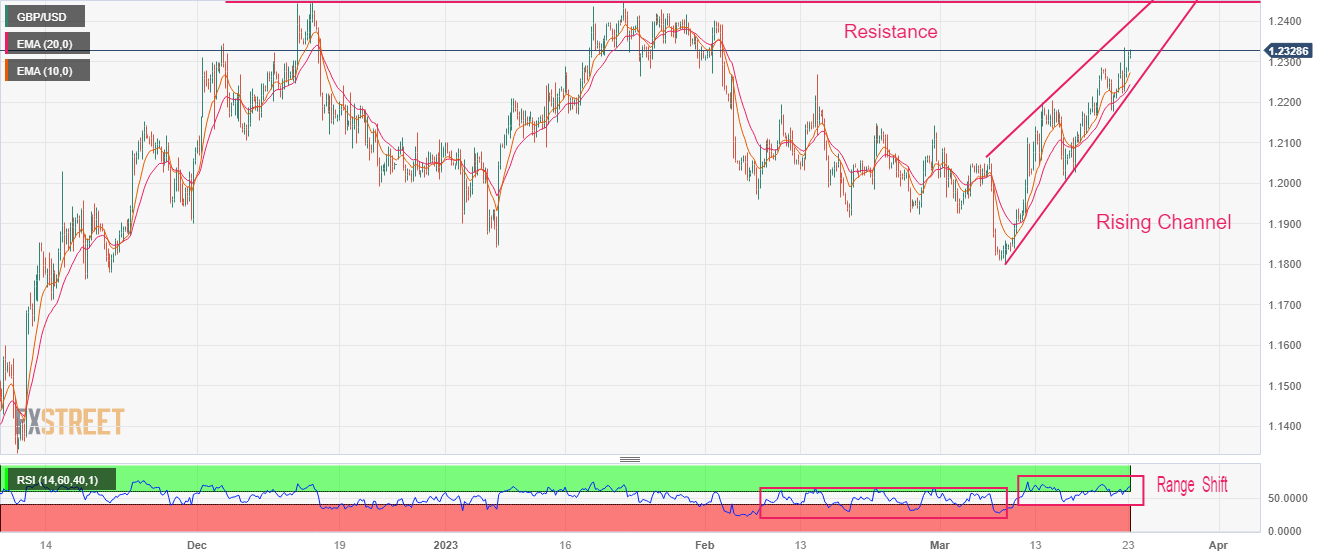
- USD/CHF remains depressed at one-week low during three-day losing streak.
- U-turn from 100-DMA, sustained observance of fortnight-old resistance line favor bears.
- Downbeat oscillators add strength to the south-run targeting seven-week-old support line.
- 50-DMA joins short-term resistance line to highlight 0.9255 as the key upside hurdle.
USD/CHF portrays a three-day downtrend at the lowest level in a week, down 0.25% intraday around 0.9155 heading into Thursday’s European session, as the pair sellers brace for the Swiss National bank (SNB) Interest Rate Decision.
Also read: USD/CHF keeps Fed inflicted losses below 0.9200 ahead of SNB Interest Rate Decision
In doing so, the Swiss Franc (CHF) pair sellers cheer the quote’s sustained trading below the fortnight-old descending resistance line, as well as a U-turn from the 100-DMA. It’s worth noting that the bearish MACD signals and the downbeat RSI (14), not oversold, also exert downside pressure on the USD/CHF prices.
Hence, the pair is well-set to decline towards a seven-week-old ascending support line, near 0.9080 by the press time.
However, the RSI conditions appear closer to the oversold territory and hence the USD/CHF pair’s weakness past 0.9080 becomes elusive.
Should the quote drops below 0.9080, the 0.9000 psychological magnet and the 61.8% Fibonacci Expansion (FE) of the pair’s moves between November 10, 2022, and March 03, 2023, around 0.8915, will gain the market’s attention.
Alternatively, a convergence of the 50-DMA and a two-week-old resistance line, near 0.9255 at the latest, restrict short-term USD/CHF upside ahead of the 100-DMA resistance surrounding 0.9335.
In a case where the Swiss pair buyers keep the reins past 0.9335, the monthly high of near 0.9440 could act as the last defense of the pair bears.
USD/CHF: Daily chart

Trend: Further downside expected
- Asian stocks are demonstrating a subdued performance amid mixed responses toward Fed policy.
- Fed’s battle against inflation continues as it won’t cut rates this year and also claims one more rate hike.
- Oil prices are aiming to sustain above $70.00 despite a build-up of inventories last week.
Markets in the Asian domain are displaying subdued performance on Thursday as investors are still digesting distinct commentaries from Federal Reserve (Fed) chair Jerome Powell while delivering a monetary policy statement.
Asian equities are confused about whether to cheer signals of a rate-hike pause or to outrage on potential credit tightening from US banks to remain cautious after the collapse of three mid-size US banks in one week. Tightening credit conditions from US banks might impact advances to households and businesses. This could also impact the outflow of funds to developing Asian nations.
Fed Powell has continued its heroic battle against persistent inflation claiming that one more rate hike is on cards and the central bank won’t cut rates this year.
At the press time, Japan’s Nikkei225 eased 0.27% while ChinaA50 jumped 0.27% and Hang Seng climbed 0.80%. Meanwhile, Nifty50 remains choppy.
The US Dollar Index (DXY) looks vulnerable above 102.00 and is likely to display more downside as safe-haven assets are losing charm led by expectations of a few rate hikes are further required by the Fed to scale US Consumer Price Index (CPI) to 2%.
Japanese stocks are likely to remain on tenterhooks ahead of the inflation data, which will release on Friday. According to the consensus, annual headline CPI is expected to decline to 4.1% from the former release of 4.3%. While the core CPI that strips off oil and food prices is seen higher at 3.4% against the prior release of 3.2%.
On the oil front, oil price is aiming to sustain above $70.00 amid optimism about fewer rate hikes from the Fed. This has receded fears of deep recession but further contraction in economic activities cannot be ruled out. Apart from that, investors have ignored the build-up of oil inventories last week. The US Energy Information Administration (EIA) reported a build-up of oil stockpiles by 1.117 million barrels for the week ending March 17.
- USD/JPY portrays corrective bounce after refreshing 1.5-month low during two-day fall.
- Yields remain pressured amid dovish Fed hike, banking sector turmoil.
- Downbeat Reuters Tanks survey details, comments from Citibank CEO seem to underpin latest rebound.
- Second-tier data, risk catalysts can entertain Yen pair sellers ahead of Friday’s Japan inflation.
USD/JPY picks up bids to pare intraday losses around 130.80 amid early Thursday morning in Europe. In doing so, the Yen pair bounces off a six-week low marked earlier in the day as traders seek more clues to extend the Federal Reserve (Fed) induces moves. Adding strength to the corrective bounces could be the key policymakers’ rejection of the financial crisis, as well as the downbeat details of Japan’s Reuters Tankan survey.
“Big Japanese manufacturers remained pessimistic about business conditions for a third straight month in March,” the closely watched Reuters Tankan survey showed early Thursday. “The sentiment index for big manufacturers stood at minus 3, slightly up from minus 5 seen in the previous month, according to the survey conducted March 8-17,” reported Reuters.
On the same line are Citibank CEO Jane Fraser’s efforts to placate market fears while saying, "This is not a credit crisis. This is a situation where it's a few banks," per Bloomberg. It should be noted that multiple central bank officials have also tried their hands to rule out fears of the 2008 crisis earlier but have failed so far. However, their swift reaction to the fallouts of the Silicon Valley Bank (SVB), Signature Bank and Credit Suisse gains applause and pushes back the odds of the market’s collapse.
Even so, the US 10-year and two-year Treasury bond yields stay pressured around 3.46% and 3.89% at the latest, licking their wounds after falling the most in a week, which in turn exerts downside pressure on the USD/JPY prices. It should be noted that the yields dropped heavily after the Federal Reserve announcements on Wednesday, snapping a two-day rebound.
Fed confirmed the market’s expectations of announcing a 0.25% rate hike but failed to convince the policy hawks and drowned the yields, as well as the US Dollar. The reason could be linked to the statements saying, “Some additional policy firming may be appropriate,” instead of previous remarks like “Ongoing increases in the target range will be appropriate.”
It should be noted that Fed Chair Jerome Powell and US Treasury Secretary Janet Yellen’s comments triggered the market’s pessimism. Fed’s Powell said that officials do not see rate cuts for this year, which in turn allowed breathing space to the greenback bears but failed to last long. Further, US Treasury Secretary Janet Yellen ruled out considering “blanket insurance” for bank deposits. Recently, Bloomberg also came out with the news suggesting that the Federal Deposit Insurance Corporation (FDIC) is said to delay the bid deadline for a Silicon Valley private bank.
Against this backdrop, S&P 500 Futures print mild gains around 3,980, up 0.13% intraday following the biggest daily slump in two weeks.
Looking ahead, monetary policy announcements from the Bank of England (BoE) and Swiss National Bank (SNB) may entertain USD/JPY traders by way of the central bankers’ reaction to the banking crisis. However, major attention will be given to Friday’s Japan National Consumer Price Index data for February amid hawkish bias surrounding the Bank of Japan (BoJ).
Technical analysis
An ascending support line from the mid-January, around 130.40 by the press time, restricts immediate USD/JPY downside. However, the Yen pair buyers remain off the table unless witnessing clear break of a fortnight-old resistance line, close to 131.85 at the latest.
- USD/CAD holds lower ground near intraday bottom during the first loss-making day in three.
- Convergence of 21-EMA, horizontal resistance-turned-support from early January challenges sellers.
- Bearish MACD signals, downbeat RSI (14) suggests further downside of the Loonie pair towards monthly low.
USD/CAD reverses from a two-week-old resistance line to print the first daily loss in three around 1.3675 heading into Thursday’s European session. In doing so, the Loonie pair pokes a key support confluence comprising the 21-day Exponential Moving Average (EMA) and a horizontal line stretched from early January, the previous resistance.
Not only the failure to cross a short-term descending resistance line but bearish MACD signals and downward-sloping RSI (14) line, not oversold, also favors the Loonie pair sellers as they poke the 1.3660-65 support confluence.
Considering the aforementioned catalysts, the USD/CAD bears appear all-set to witness a near 100 pips of south-run on breaking the 1.3660 level, which in turn highlights the monthly low of 1.3555 that comprises the 50% Fibonacci retracement of the pair’s February-March upside.
During the quote’s weakness past 1.3555, the January 19 swing high and 61.8% Fibonacci retracement level, also known as the golden Fibonacci ratio, could challenge the USD/CAD bears around 1.3520 and 1.3490 in that order.
Meanwhile, recovery moves depend upon the Loonie pair’s ability to provide a daily closing beyond the aforementioned resistance line, close to 1.3725 by the press time.
Following that, the 1.3755-65 zone may act as an extra check towards the north before directing USD/CAD bulls to the monthly high of 1.3861.
USD/CAD: Daily chart
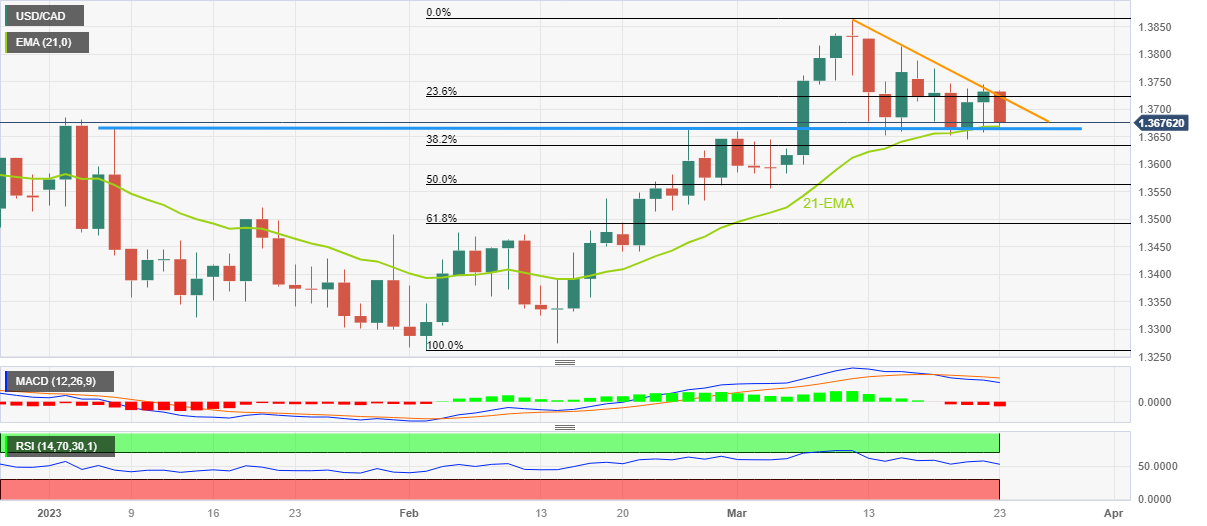
Trend: Further downside expected
- EUR/USD is oscillating near 1.0900 as USD Index has extended its downside after Fed signals rate pause.
- Federal Reserve sees tightening credit conditions from US banks after banking fiasco.
- European Central Bank would continue to hike rates further as global financial stability to propel inflation further.
- EUR/USD has comfortably established above the 61.8% Fibo retracement, which cements more upside ahead.
EUR/USD is hovering near the round-level resistance of 1.0900 in the Asian session. The major currency pair is looking to surpass the same as the Federal Reserve (Fed) has delivered signs of pausing the policy-tightening process ahead.
The commentary from Federal Reserve chair Jerome Powell, “some additional policy firming may be appropriate” was sufficient to infuse confidence into the risk-perceived currencies. This indicates that Federal Reserve Powell is considering that the current monetary policy has come a long way and will be restrictive enough to ease the United States Consumer Price Index (CPI) to 2%.
The US Dollar Index (DXY) has refreshed its six-week low at 102.61 as investors see no further room for more rate hikes from the Federal Reserve. The USD Index is expected to continue its downside momentum further as fears of the US banking crisis have refreshed.
Treasury Yields plunge as US not assures blanket insurance for all deposits
US equities were having a ball in the first two days of the week as investors were considering that Federal Deposit Insurance Corp (FDIC) insures all consumer deposits in the First Republic, which will recede fears of the banking crisis and would restore the confidence of investors. However, US Treasury Secretary Janet Yellen commented on Wednesday that there is no discussion on insurance for all bank deposits without approval from the US Congress. She further added, the government "is not considering insuring all uninsured bank deposits."
The rollback of assurance led to a plunge in US Treasury yields and S&P500 as demand for US government bonds went rooftop. The 10-year US Treasury yields have dropped to near 3.45%. The two-year US Treasury yields that move closer to S&P500 have dropped further to near 3.89%.
Apart from the absence of insurance for all uninsured deposits, US Treasury yields have heavily plunged as Fed is considering a pause to the rate-hiking spree.
Fed confirms tight credit conditions from US banks to maintain financial stability
Federal Reserve Powell has said a big no to rate cuts in 2023 as the battle against stubborn inflation is on and will remain in effect till US inflation gets restored to desired levels. However, his commentary remained to favor extremely less room for a further rate hike. Therefore, the time has ripe now as the Federal Reserve will maintain these higher rates for a longer period.
In spite of the absence of more rate hikes, US inflation will continue to remain under pressure as US banks will tighten their credit conditions for businesses and households to safeguard themselves from delinquency. In his commentary, Federal Reserve Powell cited that US banking is sound and resilient but lends would remain cautionary while disbursing advances. This would cool off heated demand, the scale of economic activities, and inflationary pressures.
European Central Bank reiterates fears of higher inflation
A recent rise in energy costs in Eurozone is accompanying higher wage pressures in keeping inflation at elevated levels. The European Central Bank (ECB) has already pushed rates to 3.5% but has failed in bringing inflation down meaningfully. On Wednesday, Reuters reported, “The recent increase in financial market risks has made it more difficult for central banks to fight inflation,” the five “wise ones” who advise Berlin on economic policy said in their biannual report. The commentary from wise ones got strengthened after European Central Bank (ECB) President Christine Lagarde reiterated "Inflation is still high and uncertainty around its path ahead has increased."
EUR/USD technical outlook
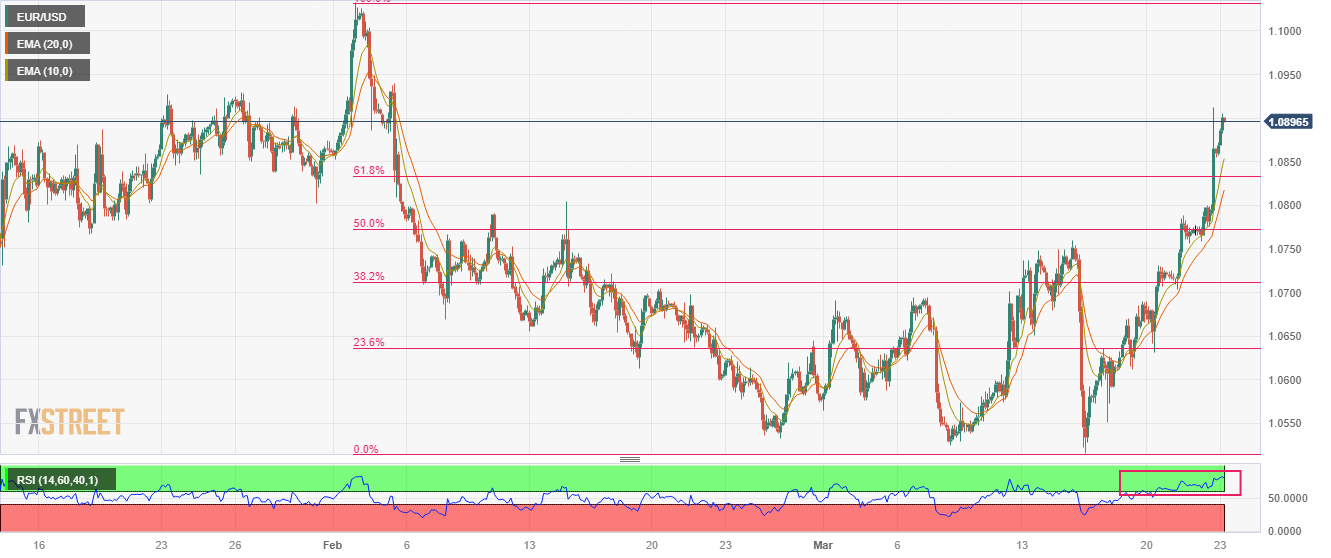
EUR/USD has shifted confidently above the 61.8% Fibonacci retracement (placed from February 01 high at 1.1033 to March 15 low at 1.0516) at 1.0834 on a two-hour scale. Upward-sloping 10-and 20-period Exponential Moving Averages (EMAs) at 1.0854 and 1.0819 indicates that the upside momentum is extremely solid.
The Relative Strength Index (RSI) (14) is hovering in the bullish range of 60.00-80.00, which indicates more upside ahead.
- USD/INR keeps Fed-induced losses around one-week low, depressed of late.
- Fed’s dovish rate hike joins cautious optimism in Asia to underpin Indian Rupee strength.
- Yields remain pressured as bank fears propel market’s rush toward bonds, Gold price.
- Some more central bank decisions, second-tier data to entertain traders but banking sector turmoil keeps USD/INR bears hopeful.
USD/INR drops to 82.30 as it extends the Federal Reserve (Fed) inflicted losses to the lowest levels in eight days during early Thursday. In doing so, the Indian Rupee (INR) pair fades a corrective bounce marked in the day’s start while declining towards the one-week low at the latest.
It’s worth noting that the weaker US Treasury bond yields weigh on the US Dollar amid the Fed’s dovish rate hike and allow the USD/INR bears to keep the reins. Also exerting downside pressure on the pair could be the cautious optimism in Asia, mainly driven by China.
That said, the US central bank confirmed the market’s expectations of announcing a 0.25% rate hike but failed to convince the policy hawks. The reason could be linked to the statements saying, “Some additional policy firming may be appropriate,” instead of previous remarks like “Ongoing increases in the target range will be appropriate.” It should be noted that the US Dollar bears ignored Fed Chair Jerome Powell’s attempt to placate rate cut bias, as well as US Treasury Secretary Janet Yellen’s comments suggesting no “blanket insurance” for bank deposits. Recently, Bloomberg also came out with the saying that the Federal Deposit Insurance Corporation (FDIC) is said to delay the bid deadline for a Silicon Valley private bank.
Hence, the banking debacle underpins the market’s rush towards the traditional safe havens like a bond, Gold and Yen, which in turn drown the US Dollar price and please the USD/INR bears. Furthermore, hopes of China’s gradual recovery, despite the banking rout, join the upbeat fundamentals surrounding India to favor the pair sellers.
Alternatively, firmer prices of Oil, up for the fourth consecutive day around $70.15 by the press time, should have challenged the INR bulls due to the Asian nation’s reliance on energy imports and record Current Account Deficit. It should be observed that holiday in India limits the Pair’s moves.
Amid these plays, S&P 500 Futures print mild gains around 3,980, up 0.13% intraday following the biggest daily slump in two weeks while the US 10-year and two-year Treasury bond yields stay pressured around 3.46% and 3.89% at the latest, licking their wounds after falling the most in a week.
Looking ahead, a holiday in India and a light calendar in Asia may allow the USD/INR to extend the latest moves. However, major attention will be given to the banking sector updates and monetary policy announcements from the Bank of England (BoE) and Swiss National Bank (SNB).
Technical analysis
Despite the latest weakness, the USD/INR bears need validation from a two-month-old ascending support line, as well as the 100-day Exponential Moving Average (EMA), around 82.00 by the press time.
Analysts at Standard Chartered offer a sneak peek at what they expect from Thursday’s Swiss National Bank (SNB) policy announcement.
Key quotes
“We expect the SNB to hike by 50 bps, taking the policy rate to 1.5% from 1.0%.”
“Hawkish policy comments, higher-than-expected February inflation and a widening interest rate differential with other major central banks support our view.”
“We now see a final 25 bps hike in June to a terminal rate of 1.75% (1.5% previously), followed by a pause.”
- Gold price is marching toward $1,980.00 as fears of a US banking crisis renewed.
- The USD Index has been battered as Fed has come extremely close to the terminal rate.
- US bonds have been resilient as the US government is not considering insuring all uninsured bank deposits.
Gold price (XAU/USD) is gathering strength to capture the immediate resistance of $1,980.00 in the Asian session. The precious metal has found demand as the US Dollar Index (DXY) has resumed its downside journey and fears of a US banking crisis have refreshed.
The USD Index is looking to refresh its six-month low below 102.00 as the Federal Reserve (Fed) has come extremely close to the terminal rate, which would be restrictive enough to bring down the United States inflation to 2%. Fed chair Jerome Powell in his commentary stated, “some additional policy firming may be appropriate”.
Investors should be aware of the fact that the US banking fiasco had underpinned Gold as a safe-haven to dodge volatility. However, an assurance of safety for all banking deposits from US Treasury Secretary Janet Yellen had receded fears of the banking crisis.
The situation seems changed now as US Yellen commented on Wednesday that the government "is not considering insuring all uninsured bank deposits." This has also strengthened the demand for US government bonds. The 10-year US Treasury yields have dropped further to near 3.45%.
Meanwhile, S&P500 futures have recovered firmly after a dive move on Wednesday, portraying an improvement in the risk appetite, however, caution still prevails as tight credit conditions from US banks will have a long-term impact. As per Fed’s commentary, US banking is sound and resilient but US banks will be more precautionary while disbursing advances to households and businesses.
Gold technical analysis
Gold price has shown a stellar recovery after sensing significant buying interest around the demand zone placed in a range of $1,933.90-1,938.40 on an hourly scale. The asset is marching towards the critical resistance plotted from March 20 high at $2,009.88.
A bull cross, represented by the 20-and 50-period Exponential Moving Averages (EMAs) at $1,954.39, adds to the upside filters.
The Relative Strength Index (RSI) (14) is oscillating in the bullish range of 60.00-80.00, which indicates more upside ahead.
Gold hourly chart
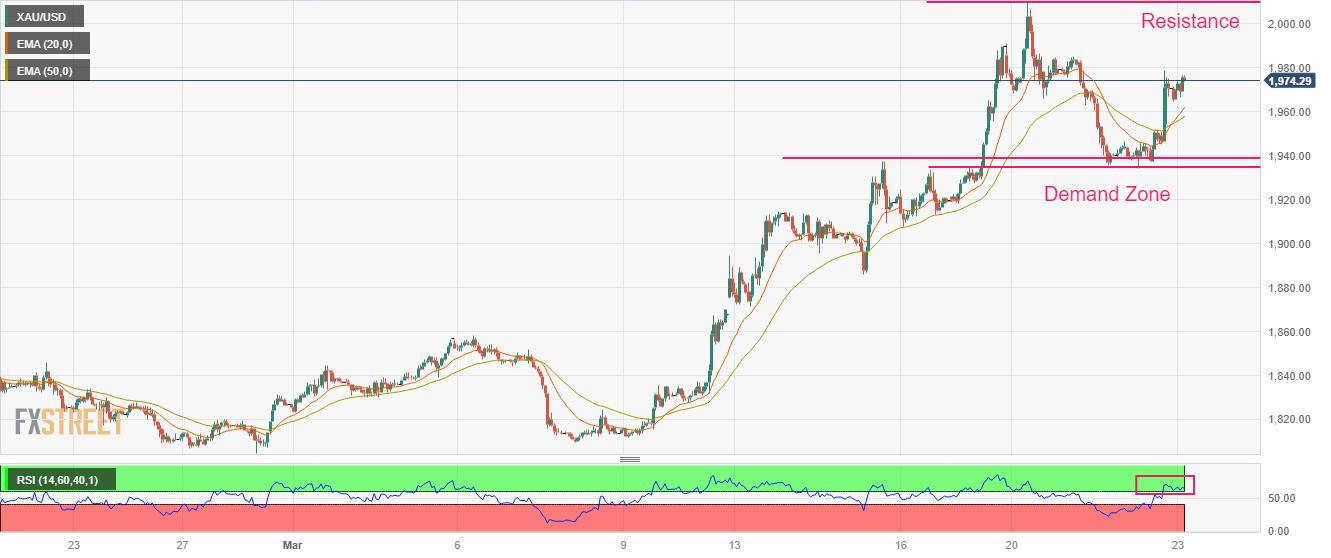
- AUD/USD picks up bids to renew intraday high near 0.6730.
- Bulls keep reins inside two-week-old rising wedge, 200-SMA adds to the upside filters.
- Upbeat RSI, sustained trend line breakout keeps buyers hopeful.
- Key SMA confluence puts a short-term floor under Aussie price.
AUD/USD extends the post-Fed run-up towards refreshing the intraday top near 0.6730 amid early Thursday morning in Europe. In doing so, the Aussie pair grinds higher within a two-week-old rising wedge bearish chart formation.
It’s worth noting, however, that the quote’s successful break of the previous key resistance line from early February, around 0.6620 by the press time, joins the upbeat RSI (14) line to keep the AUD/USD pair buyers hopeful.
However, the stated wedge’s top line, near 0.6760 by the press time, can challenge the Aussie pair’s immediate upside.
Even if the quote manages to cross the 0.6760 hurdle, the 200-SMA level of 0.6775 can challenge the AUD/USD bulls before giving them control.
On the flip side, a convergence of the 100-SMA and 50-SMA appears short-term strong support, around 0.6675 at the latest.
Following that, the stated wedge’s lower line and the resistance-turned-support can please the bears near 0.6660 and 0.6620.
It should be observed that the AUD/USD pair’s sustained break of 0.6660 would confirm the rising wedge bearish chart pattern suggesting the theoretical target of 0.6460.
Overall, AUD/USD is likely to remain firmer but the upside room appears limited.
AUD/USD: Four-hour chart

Trend: Limited upside expected
- GBP/USD picks up bids to seven-week high marked the previous day.
- Fed’s 0.25% rate hike failed to please bulls amid fears of policy pivot, banking turmoil.
- Strong UK inflation, UK PM Sunak’s Brexit success adds strength to the Cable pair’s run-up.
- BoE is all set for 0.25% rate hike but looming bank fallouts, UK’s political chaos may test the bulls.
GBP/USD renews its intraday high near 1.2310 as it rises towards the seven-week high, marked the previous day, while bulls keep the reins ahead of the Bank of England’s (BoE) monetary policy announcements. Adding strength to the Cable pair’s run-up towards the 10-month-old resistance line near 1.2350 is the Brexit optimism and the Federal Reserve’s (Fed) dovish hike, as well as the downbeat US Treasury bond yields.
British Prime Minister Rishi Sunak’s victory in getting the Brexit bill passed through the House of Commons, despite major criticism from Tory rebels seems to underpin the GBP/USD upside. "Rishi Sunak has escaped an overly damaging Commons rebellion over his revised plan for post-Brexit Northern Ireland trade, winning a vote on the measure with 22 of his own MPs voting against the deal,” said The Guardian.
Also keeping the Cable buyers hopeful could be the hawkish hopes from the BoE, especially after the previous day’s strong UK inflation data. That said, Britain’s headline inflation, namely the Consumer Price Index (CPI), rose to 10.4% YoY in February versus 9.8% expected and 10.1% prior while the Core CPI rose to 6.2% compared to 5.8% market forecasts and previous readings.
On the other hand, the US Federal Reserve (Fed) confirmed the market’s expectations of announcing a 0.25% rate hike but failed to convince the policy hawks and drowned the US Dollar. The reason could be linked to the statements saying, “Some additional policy firming may be appropriate,” instead of previous remarks like “Ongoing increases in the target range will be appropriate.” It should be noted that Fed Chair Jerome Powell and US Treasury Secretary Janet Yellen’s comments triggered the market’s pessimism as Fed’s Powell said that officials do not see rate cuts for this year, which in turn allowed breathing space to the greenback bears but failed to last long. Further, US Treasury Secretary Janet Yellen ruled out considering “blanket insurance” for bank deposits. Recently, Bloomberg also came out with the news suggesting that the Federal Deposit Insurance Corporation (FDIC) is said to delay the bid deadline for a Silicon Valley private bank.
Against this backdrop, S&P 500 Futures print mild gains around 3,980, up 0.25% intraday following the biggest daily slump in two weeks while the US 10-year and two-year Treasury bond yields stay pressured around 3.47% and 3.96% at the latest, licking their wounds after falling the most in a week.
Moving on, GBP/USD traders may keep their eyes on the political chaos in the UK’s House of Commons and second-tier US data for additional directions while focusing more on the BoE announcements. That said, the “Old Lady”, as the BoE is casually termed, is expected to roll out a 0.25% rate hike and may not entertain GBP/USD traders much, apart from initial whipsaw, unless the inflation outlook and BoE Minutes suggest further rate lifts.
Also read: BoE Interest Rate Decision Preview: Preparing the ground for a rate hike pause in May
Technical analysis
A two-week-old ascending trend line, around 1.2240 by the press time, directs GBP/USD buyers towards the key resistance line from May 2022, close to 1.2350 at the latest.
| Raw materials | Closed | Change, % |
|---|---|---|
| Silver | 22.936 | 2.48 |
| Gold | 1967.99 | 1.46 |
| Palladium | 1441.12 | 2.98 |
- USD/MXN fades bounce off one-week low as 50-DMA pushes back bullish bias.
- Bullish candlestick formation, clear bounce off 21-DMA challenges sellers.
- MACD, RSI conditions suggest further grinding towards the south.
- Buyers need successful break of 61.8% Fibonacci retracement for conviction.
USD/MXN takes offers to refresh intraday low near 18.57 during early Thursday, reversing the previous day’s rebound from the 21-DMA.
In doing so, the Mexican Peso (MXN) pair fails to justify Wednesday’s Dragonfly Doji bullish candlestick while dropping back towards the lowest levels since March 13 marked on the previous day.
It’s worth noting that the USD/MXN pair’s failure to cross the 50-DMA during late Wednesday’s corrective bounce keeps the sellers hopeful. Adding strength to the downside bias is the downward-sloping MACD line and the RSI (14) retreat.
As a result, the USD/MXN is likely to drop back to the 21-DMA support of 18.44 before highlighting the 18.30 support.
In a case where the Mexican Peso pair drops below 18.30, the 18.00 threshold could act as the last defense of the bulls before highlighting the odds of witnessing a fresh low since 2017, currently 17.90.
Alternatively, recovery moves need validation from the 50-DMA hurdle of 18.60 to renew upside momentum targeting the 50% and 61.8% Fibonacci retracements of the USD/MXN pair’s fall from December 2022 to March, respectively near 18.90 and 19.15.
Should the USD/MXN pair rises past 19.15, February’s high of 19.30 can challenge the buyers for the one last time.
USD/MXN: Daily chart
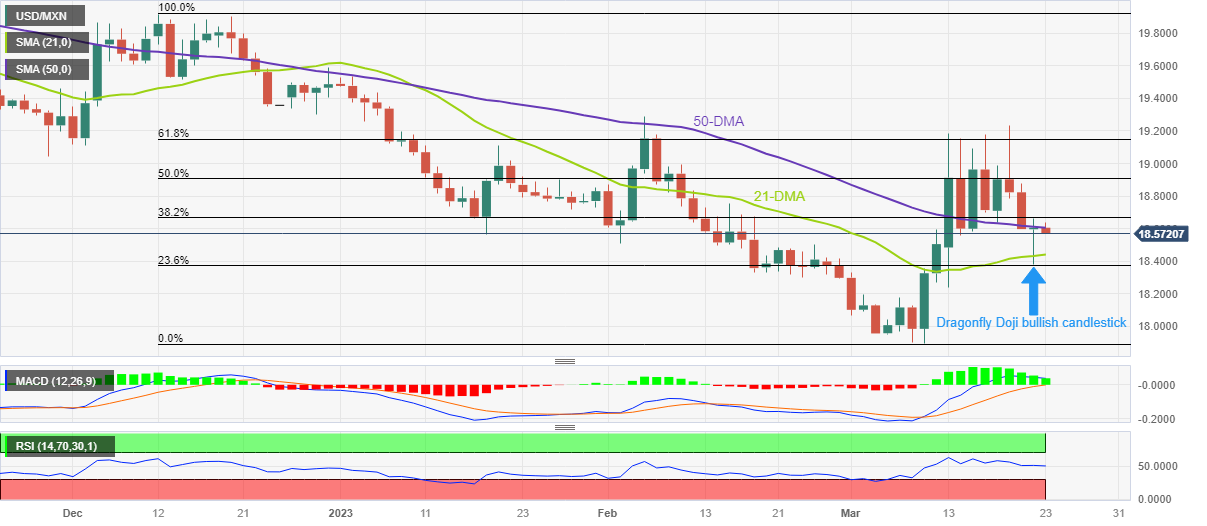
Trend: Further downside expected
- Markets consolidate Fed induced losses ahead of monetary policy announcements from BoE, SNB.
- S&P 500 Futures pare the biggest daily loss in two weeks, yields struggle after falling the most in a week.
- Fears emanating from banking fallouts weigh on sentiment even as Fed marches 0.25% rate hike expectations.
- Comments from US Treasury Secretary Yellen, doubts over SVB renew banking woes.
Global markets pare recent pessimism during Thursday’s sluggish session as Fed-induced moves need validation from the Bank of England (BoE) and Swiss National Bank (SNB). Above all, the banking turmoil challenges the optimists despite the latest cautious optimism in the market, mainly backed by the US Federal Reserve’s (Fed) dovish hike.
While portraying the mood, S&P 500 Futures print mild gains around 3,980, up 0.25% intraday following the biggest daily slump in two weeks. In doing so, the US stock futures pare the previous day’s U-turn from a 12-day high. That said, the US 10-year and two-year Treasury bond yields stay pressured around 3.47% and 3.96% at the latest, licking their wounds after falling the most in a week.
On Wednesday, the Fed confirmed the market’s expectations of announcing a 0.25% rate hike but failed to convince the policy hawks. The reason could be linked to the statements saying, “Some additional policy firming may be appropriate,” instead of previous remarks like “Ongoing increases in the target range will be appropriate.”
It should be noted that Fed Chair Jerome Powell and US Treasury Secretary Janet Yellen’s comments triggered the market’s pessimism as Fed’s Powell said that officials do not see rate cuts for this year, which in turn allowed breathing space to the greenback bears in the last.
On the other hand, US Treasury Secretary Janet Yellen ruled out considering “blanket insurance” for bank deposits. Recently, Bloomberg also came out with the news suggesting that the Federal Deposit Insurance Corporation (FDIC) is said to delay the bid deadline for a Silicon Valley private bank.
Elsewhere, Citibank CEO Jane Fraser tries to placate market fears while saying, "This is not a credit crisis. This is a situation where it's a few banks," per Bloomberg. It should be noted that multiple central bank officials have also tried their hands to rule out fears of the 2008 crisis earlier but have failed so far. However, their swift reaction to the fallouts of the Silicon Valley Bank (SVB), Signature Bank and Credit Suisse gains applause and push back the odds of the market’s collapse.
Looking ahead, strong inflation data from the UK may allow the BoE to keep its hawkish bias and announce a 0.25% rate hike while the SNB is up for 50 basis points (bps) of rate lift despite the banking turmoil.
Although the hawkish central bank actions may probe the optimists for a bit, any negative surprises, either in the form of dovish rate increases or no rate lifts at all, could bolster the market’s risk-on mood and propel the yields.
Also read: Forex Today: USD drops after the Fed, but shows signs of life
- USD/JPY downside decelerates after strong sell-off due to dovish Fed.
- Bulls could target a 61.8% Fibonacci retracement into the neckline of the M-formation.
As per the prior analysis, USD/JPY Price Analysis: Bulls are up to test key resistance near 132.60, 50% reversion and support eyed, the bears stepped in as forecasted according to the W-formation´s draw on the price. However, the move was accentuated during the Federal Reserve event.
USD/JPY prior analysis
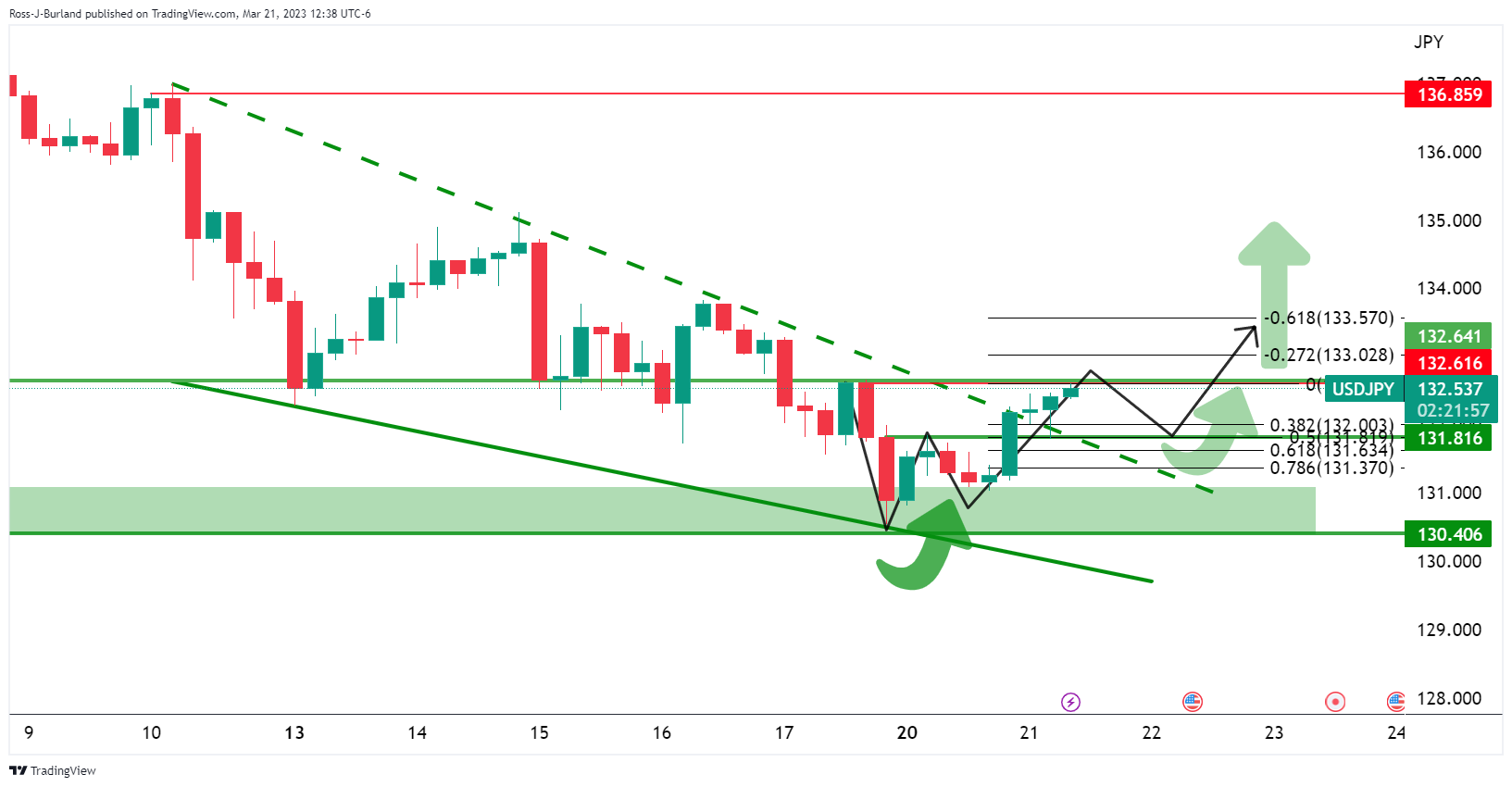
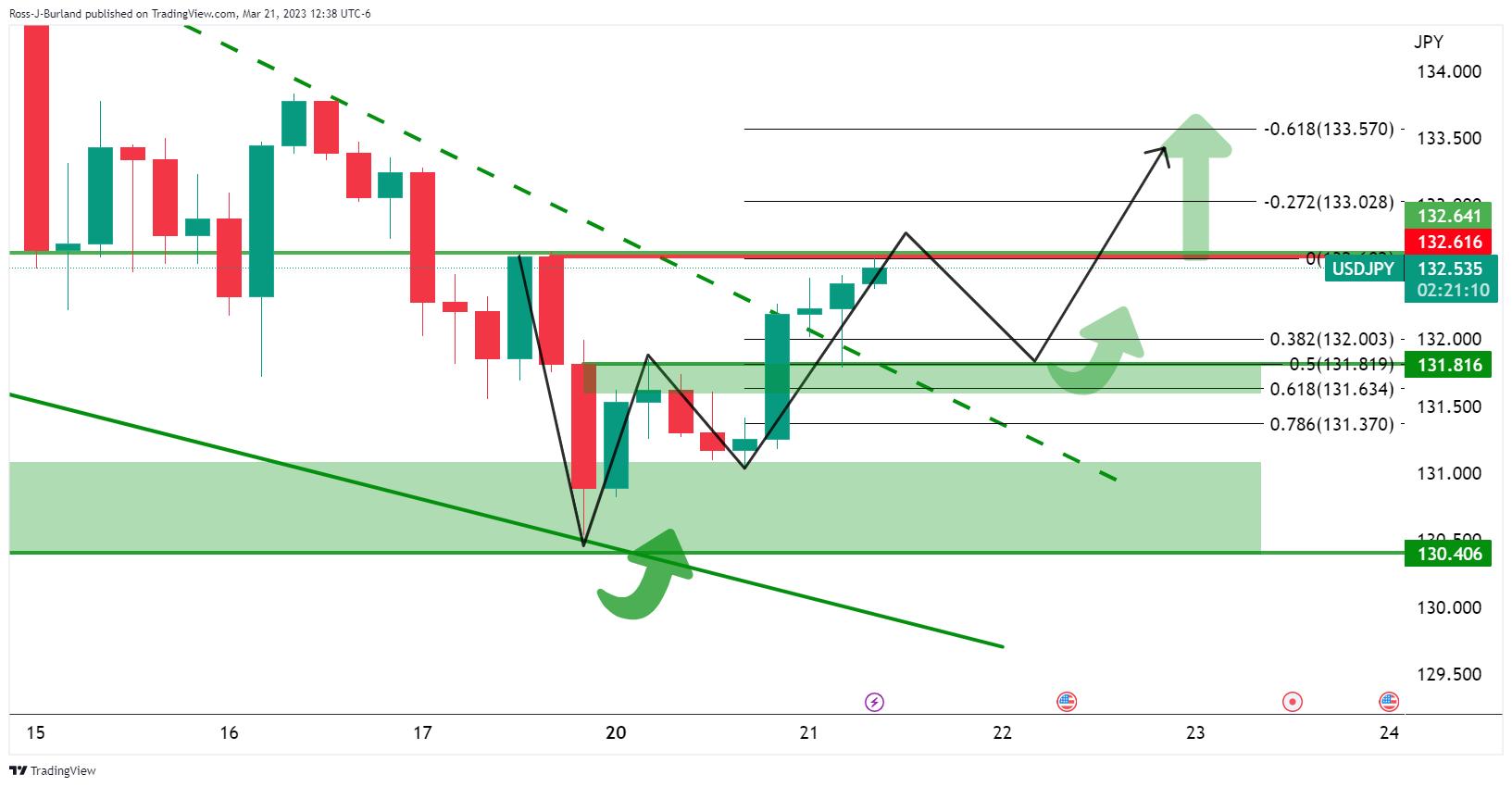
It was stated that ´´the W-formation shows the price meeting prior resistance and a retest of the neckline, which would be expected to act as support, could be the final show from the bears as bulls take control.´´
USD/JPY update
While the price did indeed fall into the neckline, it vaulted the support on the back of a very weak US Dollar during the Fed event:

The price is moving into the lower support and the bulls could be committed near the 130.70s for a retest of the prior support as follows:

Bulls could target a 61.8% Fibonacci retracement into the neckline of the M-formation.
- NZD/USD has moved higher to 0.6250 after a recovery move as USD Index has retreated.
- Tight credit conditions for US businesses and households after the SVB collapse might cool down the overall demand.
- The Fed sees no rate cuts in 2023 as restrictive monetary policy is required to bring down inflation to 2%.
The NZD/USD pair has extended its recovery move to near 0.6250 in the Asian session. The Kiwi asset rebounded firmly from 0.6220 as the US Dollar Index (DXY) showed a short-lived pullback move after dropping to near 102.00. The USD Index is hovering near its six-month low and is expected to continue its downside momentum as the Federal Reserve (Fed) has approached to its terminal rate.
A 25 basis point (bp) rate hike by the Fed was widely anticipated, which pushed rates to 4.75-5.00%. Fed chair Jerome Powell tried harder to maintain his hawkish stance citing that rate cuts in 2023 are not into consideration as restrictive monetary policy is highly required to bring down the inflation rate to 2%. The stage of hawkish stance got de-railed after Fed Powell commented “some additional policy firming may be appropriate”, which indicated that the Fed has come closer to pausing the rate-hiking spell.
United States equities went through a massive sell-off on Wednesday as Fed Powell stemmed fears of a dismal economic outlook due to lower demand and the scale of economic activities. Cues from Fed Powell’s commentary indicate that the US banking system is ‘sound and resilient’ but tight credit conditions for households and businesses cannot be ruled out.
Coming to Asia-Pacific, the New Zealand Dollar is struggling to maintain its feet as the street is anticipating a lower growth rate in the kiwi zone after the flood situation.
Meanwhile, Reserve Bank of New Zealand (RBNZ) Chief Economist Paul Conway on Thursday said interest rates were clearly contracting and causing a welcome slowdown in demand in the economy, though it was not yet clear that inflation expectations were under control, as Reuters reported.
Economists at Bank of America Global Research (BoA) offer their expectations for the Bank of England's (BoE) March policy decision.
Also read: BoE Interest Rate Decision Preview: Preparing ground for a rate hike pause in May
Key quotes
"We expect a 25bp Bank of England rate hike this week, with dovish guidance. But it's a very close call. We would not be surprised to see the BoE keep rates on hold. Either way, we expect no further hikes after this week.”
“Our recent analysis has shown that GBP has been agnostic to UK rate moves in recent years. We do not think this is about to change any time soon.”
“For now, position cleansing, standard market response to a crisis will continue to dominate sentiment. EUR/GBP has been a favored long this year and our momentum indicators have been flashing overbought levels.”
Following a keynote address about inflation earlier this Thursday, Reserve Bank of New Zealand (RBNZ) Chief Economist Paul Conway is now addressing the Q&A session.
Key quotes
Monetary policy is definitely having an effect.
Forecasting the economy is very challenging right now.
Confident that the banks that we regulate here in New Zealand are sound.
If inflation expectations don't fall, will have to do more on interest rates.
Market reaction
The latest hawkish comments from the RBNZ official is helping NZD/USD regain its upside traction. The pair is trading 0.40% higher on the day at 0.6245, at the time of writing.
- WTI grinds near one-week high marked the previous day, up for the fourth consecutive day.
- Successful break of 50-SMA joins upbeat oscillators to underpin bullish bias.
- Fortnight-long descending resistance line guards immediate upside ahead of a horizontal resistance area established since early February.
- One-week-old horizontal support acts as an additional downside filter.
WTI crude oil buyers keep the reins for the fourth consecutive day as the quote rises to $70.25 during early Thursday. In doing so, the black gold prices seesaw around the one-week top marked the previous day while approaching the key descending resistance line stretched from March 07.
The energy benchmark’s latest upside could be linked to a sustained break of a one-week-old horizontal resistance, now support, as well as the 50-SMA. Adding strength to the upside bias could be the bullish MACD signals and upbeat RSI (14) line, not overbought.
With this, the WTI bulls appear all-set to cross the aforementioned resistance line, around $70.85 by the press time. However, the seven-week-old horizontal region surrounding $72.50-70 appears a tough nut to crack for Oil buyers.
In a case where the commodity price rally beyond $72.70, the late February low joins the 100-SMA to highlight $73.85 as the last defense of the bears.
On the contrary, the 50-SMA and one-week-old horizontal support, previous resistance, restrict the short-term downside of the black gold near $69.85.
Following that, $68.00 and $66.50 may prod WTI bears before directing them to the monthly of around $64.40, also the lowest levels since December 2021.
WTI: Four-hour chart
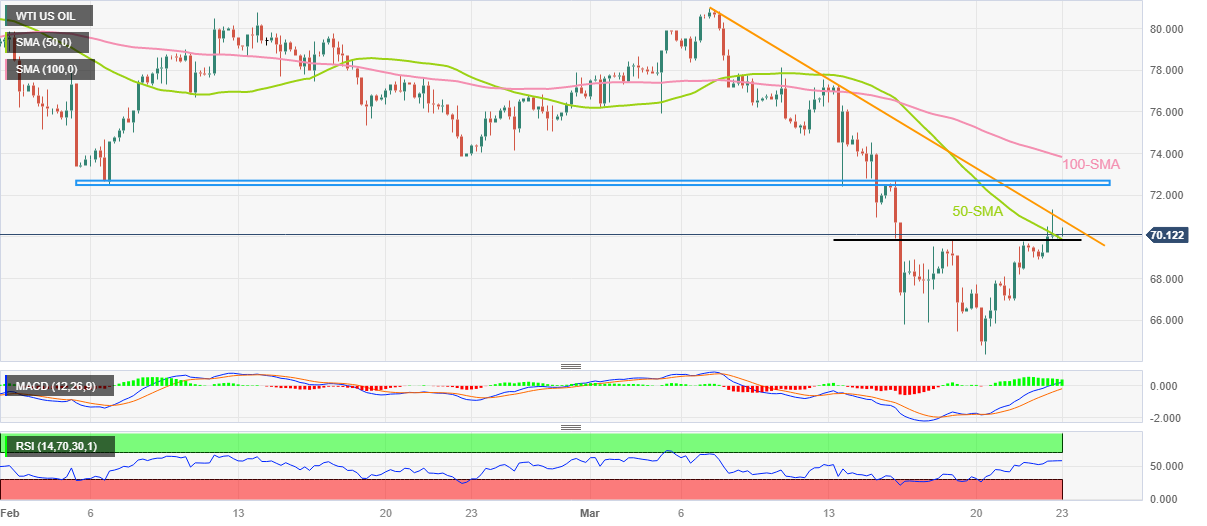
Trend: Further upside expected
- USD/CHF has dropped below the 0.9160 support as Fed has come closer to the terminal rate.
- Fed Powell remained softer on interest rate guidance citing “some additional policy firming may be appropriate”.
- The interest rate decision for SNB Jordan would be incredibly difficult, which is still dealing with the Credit Suisse mess.
The USD/CHF pair has slipped below the immediate support of 0.9160 in the Asian session. The Swiss franc asset has retreated after a recovery attempt to near 0.9180 as the commentary from Federal Reserve (Fed) chair Jerome Powell in his monetary policy statement indicates that the central bank is close to reaching the terminal rate.
After hiking interest rates by 25 basis points (bps) consecutively to 4.75-5.00%, Fed Powell remained softer on interest rate guidance citing “some additional policy firming may be appropriate”.
Dovish guidance on interest rates has weighed heavily on the US Dollar Index (DXY). The USD Index has dropped after a short-lived recovery and is expected to continue its downside journey.
S&P500 futures are showing some gains after a sell-off on Wednesday, however, the appeal for US equities is still weak. Investors seem dissatisfied from US Treasury Secretary Janet Yellen's commentary that the government "is not considering insuring all uninsured bank deposits," The rollback of assurance has receded confidence among investors.
Meanwhile, the demand for US government bonds has soared as tight credit conditions from the banks for households and businesses after the collapse of Silicon Valley Bank (SVB) and Signature Bank would result in cooling demand and inflation.
Thursday’s session is going to remain extremely volatile as investors are awaiting the interest rate decision from the Swiss National Bank (SNB). Analysts from ING cited “Our baseline scenario remains a 50 bps rate hike, but the probability of this has seriously diminished, and neither the status quo nor a 25 bps hike can be ruled out. Unlike the ECB, the SNB has not pre-announced anything, so it is freer in its choices.”
The decision is likely to be incredibly difficult for SNB Chairman Thomas J. Jordan, which is still managing the Credit Suisse mess.
In recent trade today, the People’s Bank of China (PBOC) set the yuan at 6.8709 vs. an estimate of 6.8719.
About the fix
China maintains strict control of the yuan’s rate on the mainland.
The onshore yuan (CNY) differs from the offshore one (CNH) in trading restrictions, this last one is not as tightly controlled.
Each morning, the People’s Bank of China (PBOC) sets a so-called daily midpoint fix, based on the yuan’s previous day's closing level and quotations taken from the inter-bank dealer.
- USD/CAD takes offers to refresh intraday low during the first loss-making day in three.
- US Dollar fails to cheer Fed’s 0.25% rate hike as policy pivot talks gained attention.
- WTI ignores downbeat EIA Crude Oil Stocks Change amid hopes of more energy demand, cheers softer USD.
- Second-tier US, Canada statistics can entertain traders ahead of Friday’s key data.
USD/CAD bears return to the table, after a two-day absence, as broad US Dollar weakness joins the Oil price run-up during early Thursday. With this, the Loonie pair renews its intraday low near 1.3700 during the sluggish Asian session.
That said, the US Dollar Index (DXY) drops for the sixth consecutive day as bears poke the 102.30 mark while staying around the lowest levels since early February, marked the previous day. In doing so, the greenback’s gauge versus six major currencies fails to cheer the Federal Reserve’s (Fed) 25 basis points (bps) rate hike amid dovish concerns surrounding the US central bank’s next move, as well as fears surrounding the US banking sector.
Fed matched the market’s expectations of announcing a 0.25% rate hike but the statements saying, “some additional policy firming may be appropriate,” instead of previous remarks like “ongoing increases in the target range will be appropriate” pushed back the policy hawks.
It should be noted that Fed Chair Jerome Powell and US Treasury Secretary Janet Yellen’s comments were more important as Fed’s Powell said that officials do not see rate cuts for this year, which in turn allowed breathing space to the greenback bears in the last. On the other hand, US Treasury Secretary Janet Yellen ruled out considering “blanket insurance” for bank deposits. Recently, Bloomberg also came out with the news suggesting that the Federal Deposit Insurance Corporation is said to delay the bid deadline for a Silicon Valley private bank.
Elsewhere, WTI crude oil rises for the fourth consecutive day while extending the early-week rebound from the lowest levels since December 2021, up 0.52% intraday near $70.30 by the press time. In doing so, the black gold cheers hopes of more energy demand, driven by optimism surrounding China, while ignoring a surprise build in weekly inventories. That said, the weekly Crude Oil inventory data from the US Energy Information Administration (EIA) signaled that the stockpile grew 1.117M versus expected prints of -1.448M and 1.55M prior.
Against this backdrop, the US 10-year and two-year Treasury bond yields stay pressured around 3.48% and 3.96% at the latest while the S&P 500 Futures print mild gains even after Wall Street’s downbeat performance.
Looking ahead, second-tier numbers from the US and Canada can entertain USD/CAD pair traders ahead of Friday’s key Canadian Retail Sales and the US Durable Goods Orders for January and February respectively.
Technical analysis
USD/CAD stays on the bear’s radar unless providing a daily close beyond the 1.3720-30 resistance confluence, comprising the 10-DMA and a two-week-old descending trend line.
Reserve Bank of New Zealand Chief Economist Paul Conway on Thursday said interest rates were clearly in the contractionary territory and causing a welcome slowdown in demand in the economy, though it was not yet clear that inflation expectations were under control, as Reuters reported.
He was also reported saying that the 450 basis point rise in interest rates over the last 18 months was still "percolating" through the economy and would likely further weigh on consumer spending.
Reuters noted that he said that it was unclear whether inflation expectations were falling fast enough to mean current and projected rate setting were high enough to be disinflationary.
NZD/USD update
The NZ Dollar flew to a fresh high for the month at 0.6282 and was up from a low of 0.6171 on the back of a dovish Federal Reserve on Wednesday.
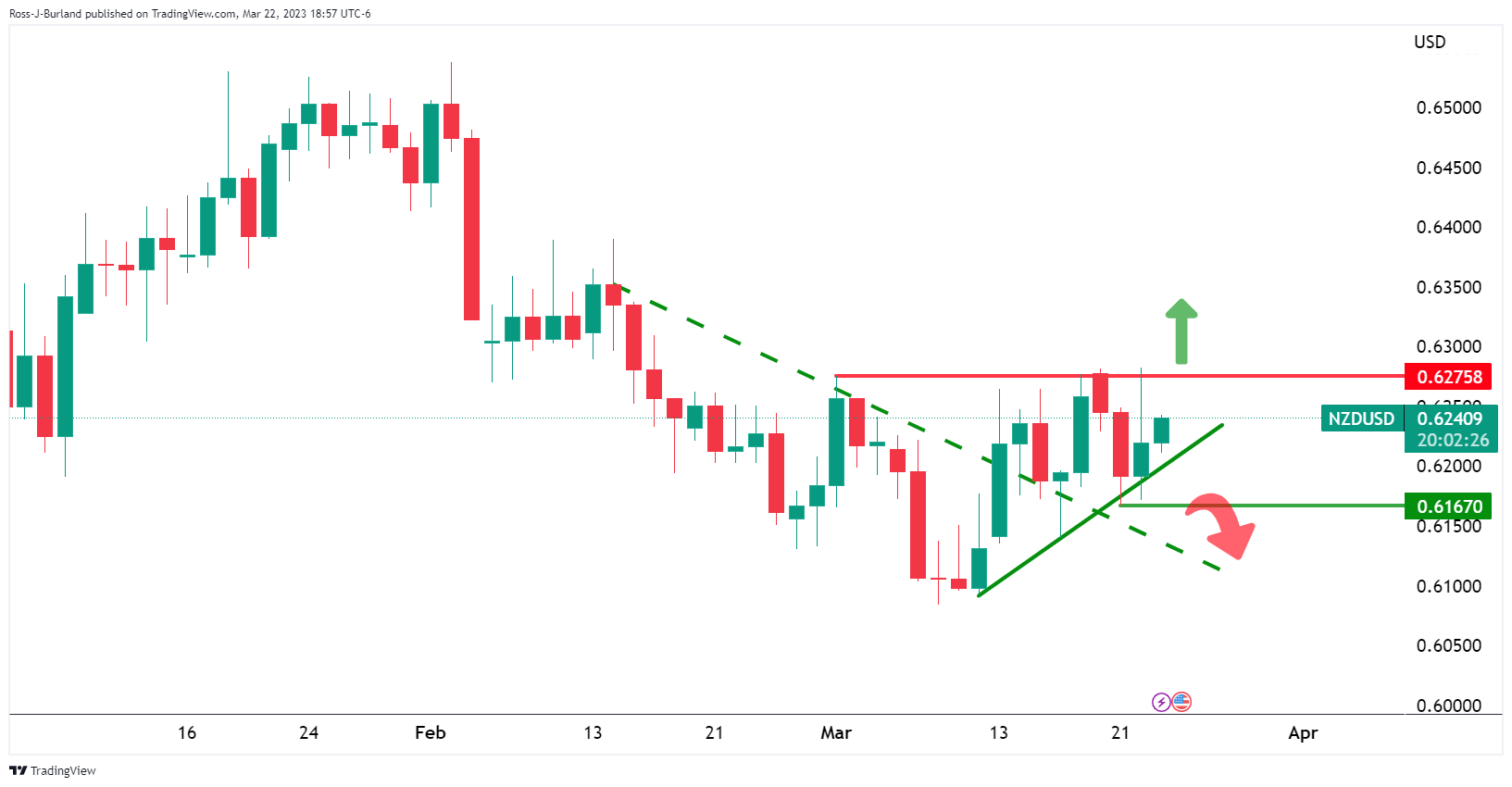
The bulls are moving back in on Thursday and eye a break of the 0.6280s.
- EUR/USD prints six-day winning streak, stays firmer around the highest levels since early February.
- Clear upside break of one-year-long horizontal resistance, now support, joins upbeat oscillators to favor Euro bulls.
- Sustained bounce off 100-DMA, 50% Fibonacci retracement also strength bullish bias.
- Sellers need validation from 200-DMA to retake control.
EUR/USD picks up bids to refresh intraday high near 1.0875 as bulls keep the reins for the sixth consecutive day to early Thursday. In doing so, the major currency pair remains firmer around the highest levels in seven weeks, marked the previous day.
That said, the quote’s upside momentum gains validation from a successful break of the one-year-long horizontal resistance, now support around 1.0805-785.
Also favoring the bulls is the EUR/USD pair’s sustained rebound from the 100-DMA, around 1.0605 by the press time, as well as from the 50% Fibonacci retracement of the pair’s downside from February to September 2022, near 1.0515.
Additionally, bullish MACD signals and the firmer Relative Strength Index (RSI) line, not overbought, also underpin the bullish bias about the EUR/USD pair.
It should be noted that the 200-DMA level surrounding 1.0335 acts as the last defense of the EUR/USD buyers.
On the flip side, a 13-month-old descending resistance line, around 1.0985, lures the EUR/USD bulls ahead of the 1.1000 psychological magnet. Following that, the yearly high of 1.1033 and the March 2022 top surrounding 1.1185 could lure the pair buyers.
EUR/USD: Daily chart
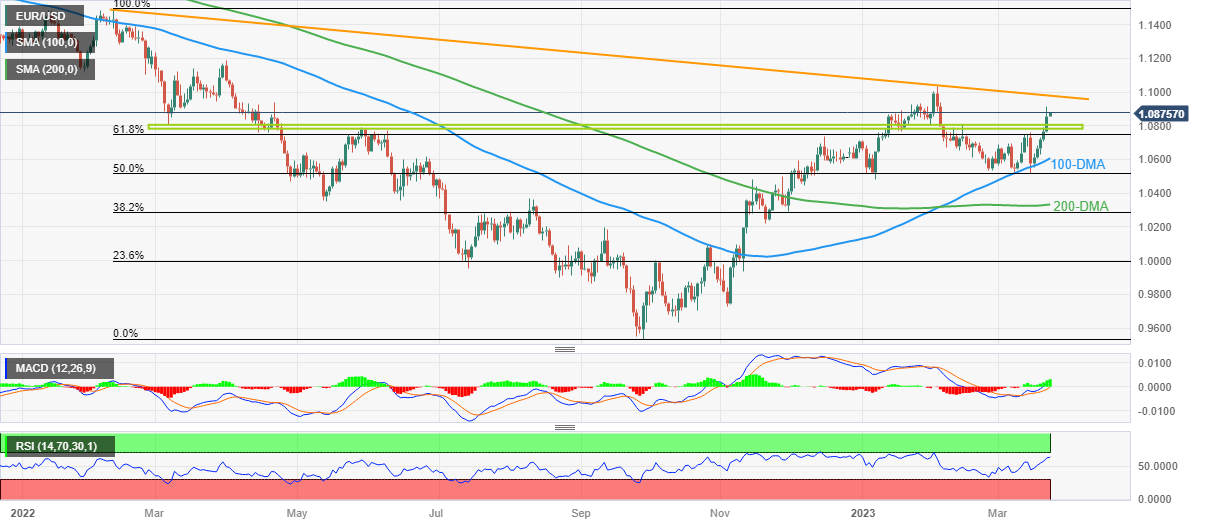
Trend: Further upside expected
- AUD/USD bulls are in the market and eye a break 0.6700.
- Bulls look to the 0.6850s on the daily chart as a prospect.
AUD/USD rallied to the highest in nearly two weeks on Wednesday in the US session after the Federal Reserve hiked rates by another 25bps, as expected. However, the Fed came around with a far more dovish tone this time.
Analysts at Rabobank have lowered their forecast for the target range of the fed funds rate to 5.00-5.25% from 5.25-5.50%. In other words, we now expect only one more hike of 25 bps instead of two. ´´However, we stick to our forecast that the FOMC will not pivot this year.´´
Meanwhile, on the domestic front, the Reserve Bank of Australia´s minutes revealed a central bank that will reconsider the case for a pause at the April meeting to reassess the economic outlook that remained looking uncertain.
All in all, the fundamentals have overridden the technical picture but the bulls are in play at this juncture as the following illustrates:
AUD/USD daily chart

From a daily perspective, the bulls are on board and looking to fully test the 0.6850s on a break beyond 0.6758 highs.
AUD/USD H4 chart
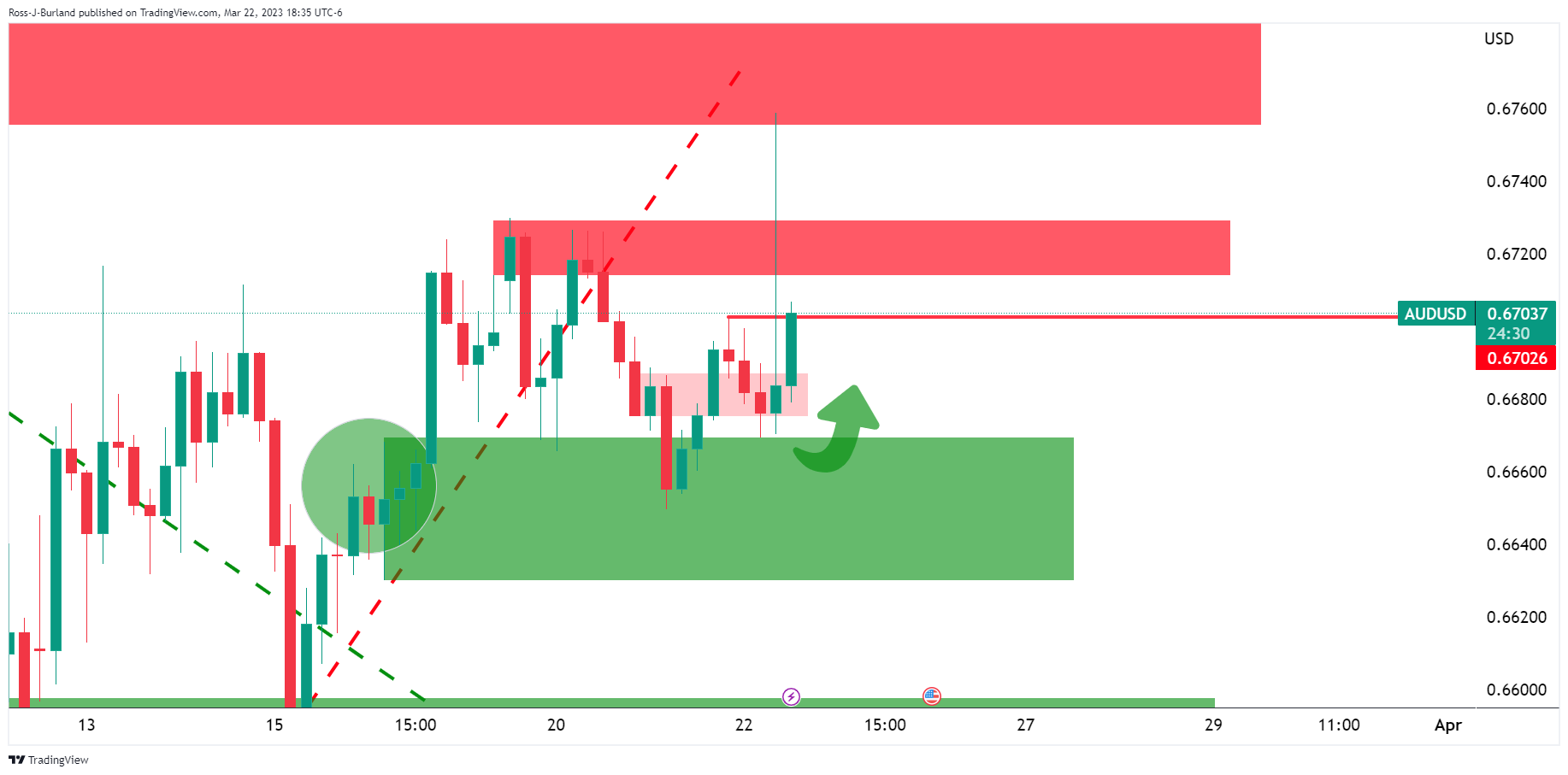
However, there is some work to be done yet. 0.6700 needs to give on a closing basis on the 4-hour chart that guards 0.6730 resistance.
- GBP/USD is aiming to recapture the 1.2300 resistance on hopes of an eleventh consecutive rate hike by the BoE.
- The USD Index has retreated as further credit tightening to safeguard the US banking system would cool off demand.
- The rollback of support for all bank deposits by US Janet Yellen triggered a sell-off in US equities.
The GBP/USD pair is looking to recapture the round-level resistance of 1.2300 in the Asian session. The Cable has rebounded after a vertical correction to near 1.2260 as the street anticipates that the absence of hawkish interest rate guidance from Federal Reserve (Fed) chair Jerome Powell while addressing the economy in the monetary policy meeting reflects that the Fed is close to ending its policy-tightening spell.
S&P500 futures have generated some gains in the Asian session after a plunge on Wednesday as Fed Powell has confirmed that the battle against the sticky United States inflation is continued. Fed Powell has said no to rate cuts in 2023 as taming the stubborn inflation is still a hard nut to crack. Apart from that, US Treasury Secretary Janet Yellen’s statement that the government "is not considering insuring all uninsured bank deposits," renewed fears of a banking sector meltdown.
The US Dollar Index (DXY) has retreated after a recovery move on hopes that further credit tightening to safeguard the banking system would cool off overall demand, the scale of economic activities, and inflation. Meanwhile, the appeal for US government bonds has increased amid expectations of a pause in further policy restriction and rollback of support for all bank deposits by US Janet Yellen.
On the United Kingdom front, the Pound Sterling is likely to remain solid as the Bank of England (BoE) is going to hike rates consecutive for the eleventh time. A 25 basis point (bp) interest rate hike is expected from BoE Governor Andrew Bailey as UK’s inflation has been lifted higher by soaring prices of food and non-alcoholic drinks and higher energy costs.
The interest rate decision by the BoE is going to be a tough one as policymakers were split about hiking rates further or keeping them steady amid global banking turmoil.
- Gold price grinds higher after staging strong recovery from one-week low.
- Federal Reserve announcements, United States Treasury Secretary Janet Yellen’s comments weigh on yields and propel XAU/USD.
- Banking sector rout prods policy hawks despite meeting immediate rate hike needs, suggesting further upside for the Gold price.
Gold price (XAU/USD) bulls take a breather around $1,970 during Thursday’s sluggish Asian session, after posting the biggest daily gain in a week during the volatile Wednesday. That said, the Federal Reserve’s (Fed) dovish rate hike and US Treasury Secretary Janet Yellen’s comments suggesting no out-of-the-line support for the United States banks seem to weigh on the Treasury bond yields and propel the XAU/USD price. It’s worth noting that the cautious mood ahead of today’s monetary policy meeting by the Bank of England (BoE) and Swiss National Bank (SNB) allows space for metal buyers.
Gold price rally as United States Treasury bond yields slump
Gold price jumped over $30 as the United States Treasury bond yields marked the biggest daily slump in a week the previous day. The reason could be linked to the multiple announcements from the Federal Reserve (Fed) and the Treasury Department that bolstered fears of baking fallouts and drowned the US Dollar, due to the Fed’s dovish hike. That said, the US 10-year and two-year Treasury bond yields stay pressured around 3.45% and 3.96% at the latest, after falling 4.80% and 5.50% in that order the previous day.
US Federal Reserve failed to push back the banking sector fears despite announcing a 0.25% rate hike. The reason could be linked to the statements saying, “some additional policy firming may be appropriate,” instead of previous remarks like “ongoing increases in the target range will be appropriate”.
It should be noted that Fed Chair Jerome Powell and US Treasury Secretary Janet Yellen’s comments were more important as Fed’s Powell said that officials do not see rate cuts for this year, which in turn allowed breathing space to the greenback bears in the last. On the other hand, US Treasury Secretary Janet Yellen ruled out considering “blanket insurance” for bank deposits. Recently, Bloomberg also came out with the news suggesting that the Federal Deposit Insurance Corporation is said to delay the bid deadline for a Silicon Valley private bank.
Elsewhere, fears about the Russia-China ties and the cautious mood ahead of the key central bank announcements seem to also weigh on the market sentiment. However, chatters surrounding China’s ability to mark notable growth, despite the global banking rout, keep the Gold buyers hopeful.
Amid these plays, the S&P 500 Futures print mild gains even after Wall Street’s downbeat performance.
Central banks in focus
Having witnessed the initial reaction to the Federal Reserve (Fed) moves, Gold traders should keep their eyes on the monetary policy announcements from the Bank of England (BoE) and Swiss National Bank (SNB) for fresh impulse.
That said, strong inflation data from the UK may allow the BoE to keep its hawkish bias and announce a 0.25% rate hike while the SNB is up for 50 basis points (bps) of rate lift despite the banking turmoil.
Although the hawkish central bank actions may probe the XAU/USD bulls for a bit, any negative surprises, either in the form of dovish rate increases or no rate lifts at all, could bolster the Gold price towards crossing the key $2,015 hurdle.
Gold price technical analysis
Gold price extends bounce off the 50-bar Simple Moving Average (SMA), backed by the looming bull cross on the Moving Average Convergence and Divergence (MACD) indicator and upbeat Relative Strength Index (RSI) line, not overbought.
In doing so, the XAU/USD approaches the previous support line from March 09, around $1,994 by the press time.
Following that, a two-month-old upward-sloping resistance line, near $2,015, acts as the last defense of the Gold bears.
On the contrary, a downside break of the 50-SMA support of $1,936 isn’t an open invitation to the XAU/USD bears as the $1,900 threshold and the 200-SMA level surrounding $1,865 could challenge the Gold sellers afterward.
Even if the metal drops below $1,865, multiple levels near $1,855 and $1,820 could prod the XAU/USD downside before highlighting the previous monthly low around $1,805 and the $1,800 threshold for the Gold sellers.
Overall, the Gold price regains upside momentum and appears well-set to challenge the $2,000 round figure.
Gold price: Four-hour chart

Trend: Further upside expected
| Index | Change, points | Closed | Change, % |
|---|---|---|---|
| NIKKEI 225 | 520.94 | 27466.61 | 1.93 |
| Hang Seng | 332.67 | 19591.43 | 1.73 |
| KOSPI | 28.61 | 2416.96 | 1.2 |
| ASX 200 | 60.2 | 7015.6 | 0.87 |
| FTSE 100 | 30.64 | 7566.84 | 0.41 |
| DAX | 20.85 | 15216.19 | 0.14 |
| CAC 40 | 18.21 | 7131.12 | 0.26 |
| Dow Jones | -530.49 | 32030.11 | -1.63 |
| S&P 500 | -65.9 | 3936.97 | -1.65 |
| NASDAQ Composite | -190.15 | 11669.96 | -1.6 |
| Pare | Closed | Change, % |
|---|---|---|
| AUDUSD | 0.66824 | 0.2 |
| EURJPY | 142.69 | 0.04 |
| EURUSD | 1.0858 | 0.82 |
| GBPJPY | 161.189 | -0.4 |
| GBPUSD | 1.22654 | 0.38 |
| NZDUSD | 0.62194 | 0.41 |
| USDCAD | 1.37315 | 0.14 |
| USDCHF | 0.91685 | -0.58 |
| USDJPY | 131.404 | -0.78 |
- EUR/JPY has dropped to near 142.50 despite ECB’s Lagarde refreshed fears of higher Eurozone inflation.
- The recent increase in financial market risks has made it more difficult for central banks to fight inflation.
- A major contribution to Japan’s inflation is coming from higher import prices.
The EUR/JPY pair has extended its correction to near 142.50 in the early Tokyo session. The cross has dropped further as investors are shifting their focus toward the release of Japan’s National Consumer Price Index (CPI) data, which will release on Friday.
According to the consensus, annual headline CPI is expected to decline to 4.1% from the former release of 4.3%. While the core CPI that strips off oil and food prices is seen higher at 3.4% against the prior release of 3.2%.
Bank of Japan (BoJ) policymakers have been worried that the major contribution to Japan’s inflation is coming from higher import prices while the impact of domestic forces is absent. A Reuters Tankan survey showed that “Big Japanese manufacturers remained pessimistic about business conditions for a third straight month in March.” The sentiment index for big manufacturers stood at minus 3, slightly up from minus 5 seen in the previous month.
Meanwhile, European Central Bank (ECB) President Christine Lagarde has refreshed fears of higher inflation in the Eurozone citing "Inflation is still high and uncertainty around its path ahead has increased." The commentary got more strength after Reuters reported, “The recent increase in financial market risks has made it more difficult for central banks to fight inflation,” the five “wise ones” who advise Berlin on economic policy said in their biannual report.
Wage growth and a recent revival in energy costs have been major drivers of persistent Eurozone inflation. And the cost-push inflation measures will continue to keep Eurozone inflation at elevated levels. Investors should brace for the continuation of bigger rate hikes from the ECB to tame the stubborn inflation ahead.
© 2000-2025. All rights reserved.
This site is managed by Teletrade D.J. LLC 2351 LLC 2022 (Euro House, Richmond Hill Road, Kingstown, VC0100, St. Vincent and the Grenadines).
The information on this website is for informational purposes only and does not constitute any investment advice.
The company does not serve or provide services to customers who are residents of the US, Canada, Iran, The Democratic People's Republic of Korea, Yemen and FATF blacklisted countries.
Making transactions on financial markets with marginal financial instruments opens up wide possibilities and allows investors who are willing to take risks to earn high profits, carrying a potentially high risk of losses at the same time. Therefore you should responsibly approach the issue of choosing the appropriate investment strategy, taking the available resources into account, before starting trading.
Use of the information: full or partial use of materials from this website must always be referenced to TeleTrade as the source of information. Use of the materials on the Internet must be accompanied by a hyperlink to teletrade.org. Automatic import of materials and information from this website is prohibited.
Please contact our PR department if you have any questions or need assistance at pr@teletrade.global.















